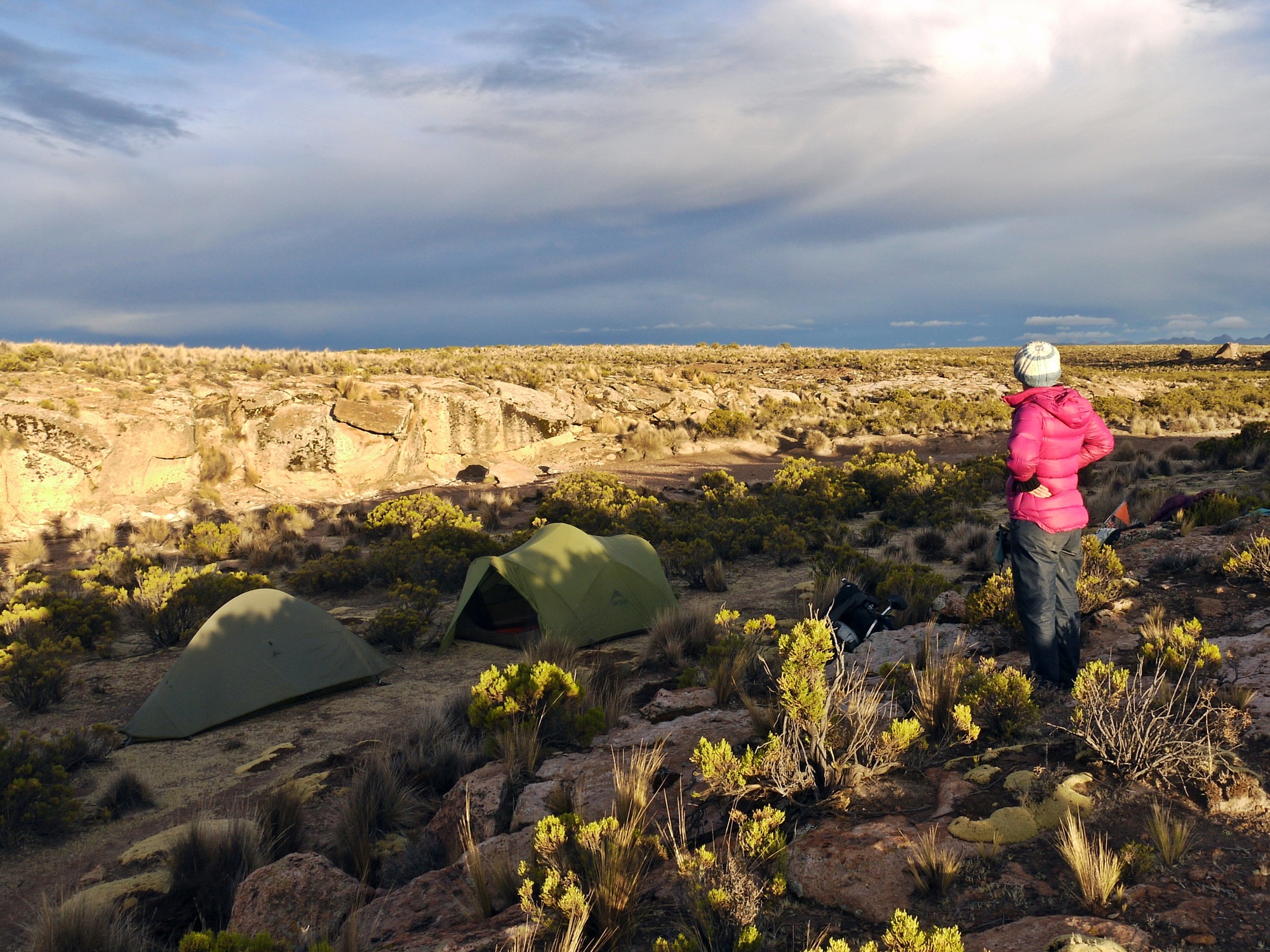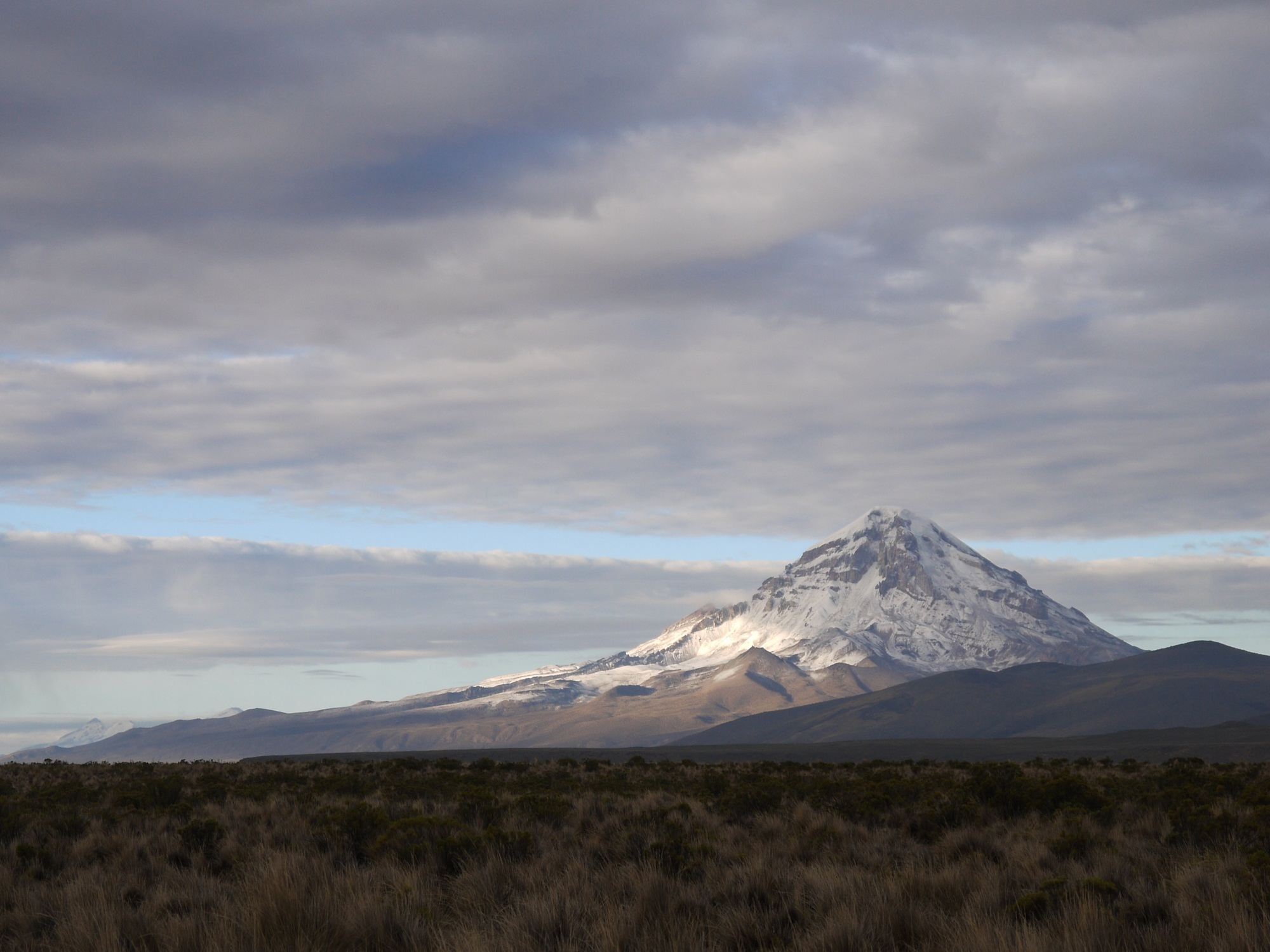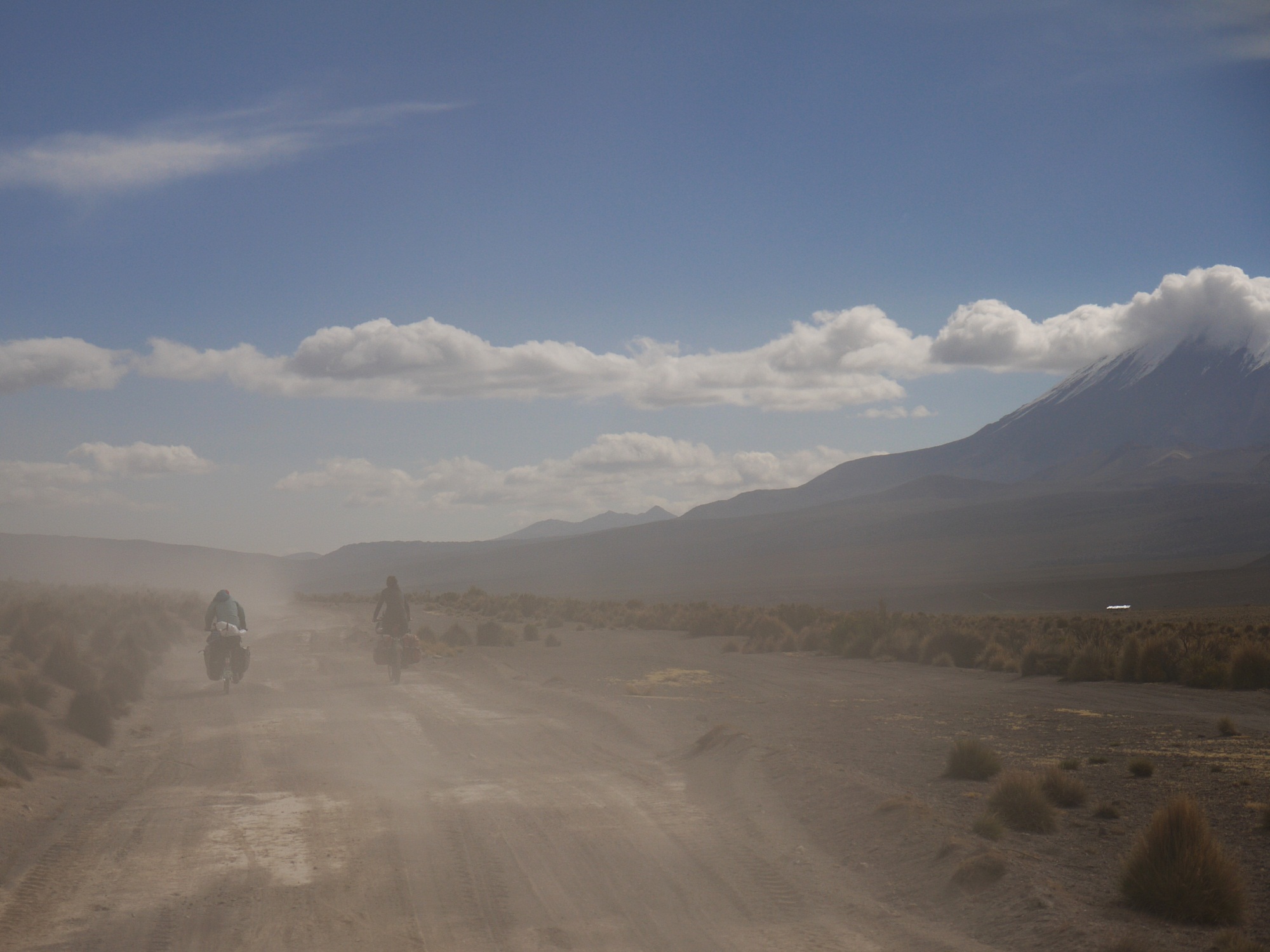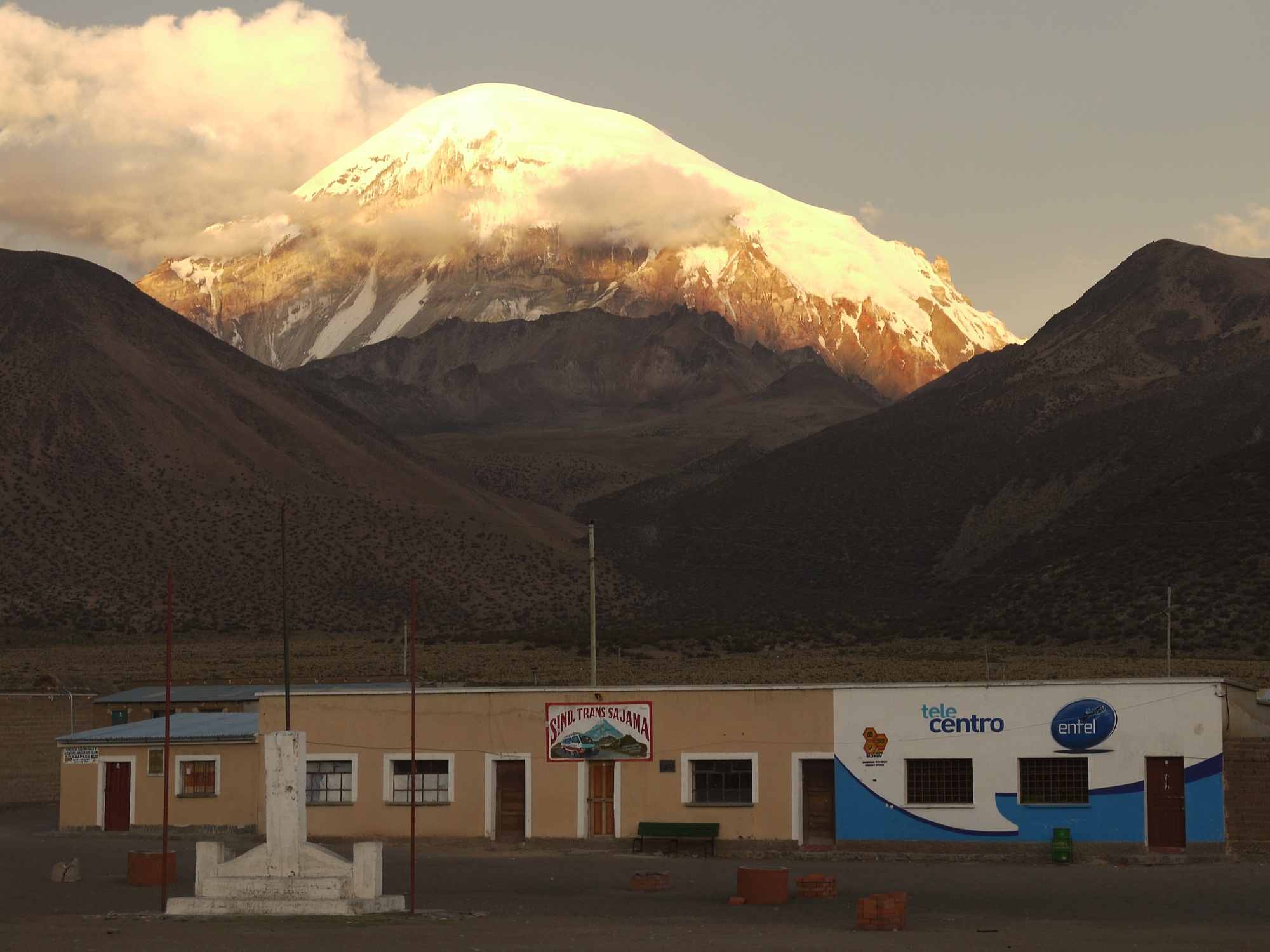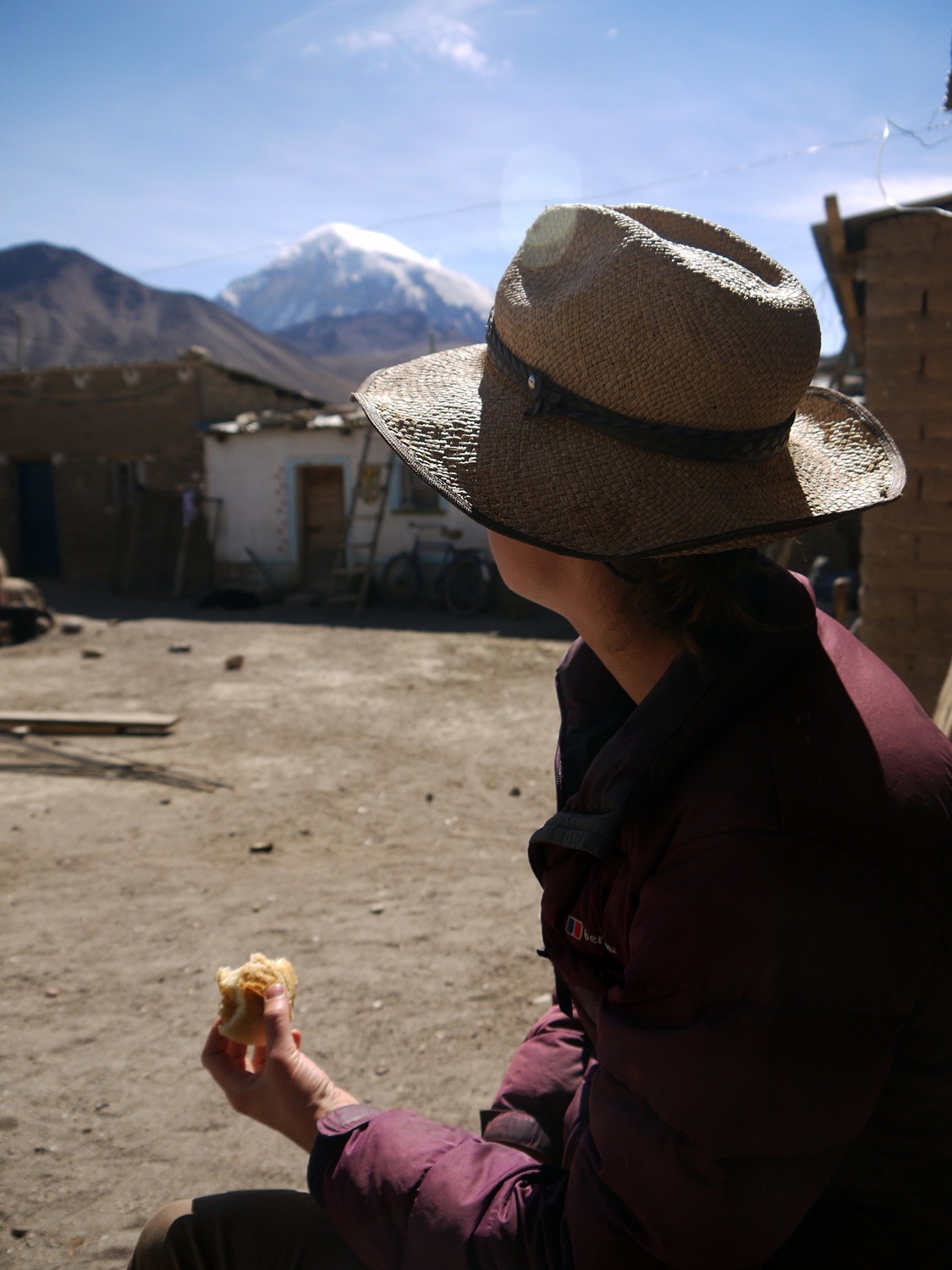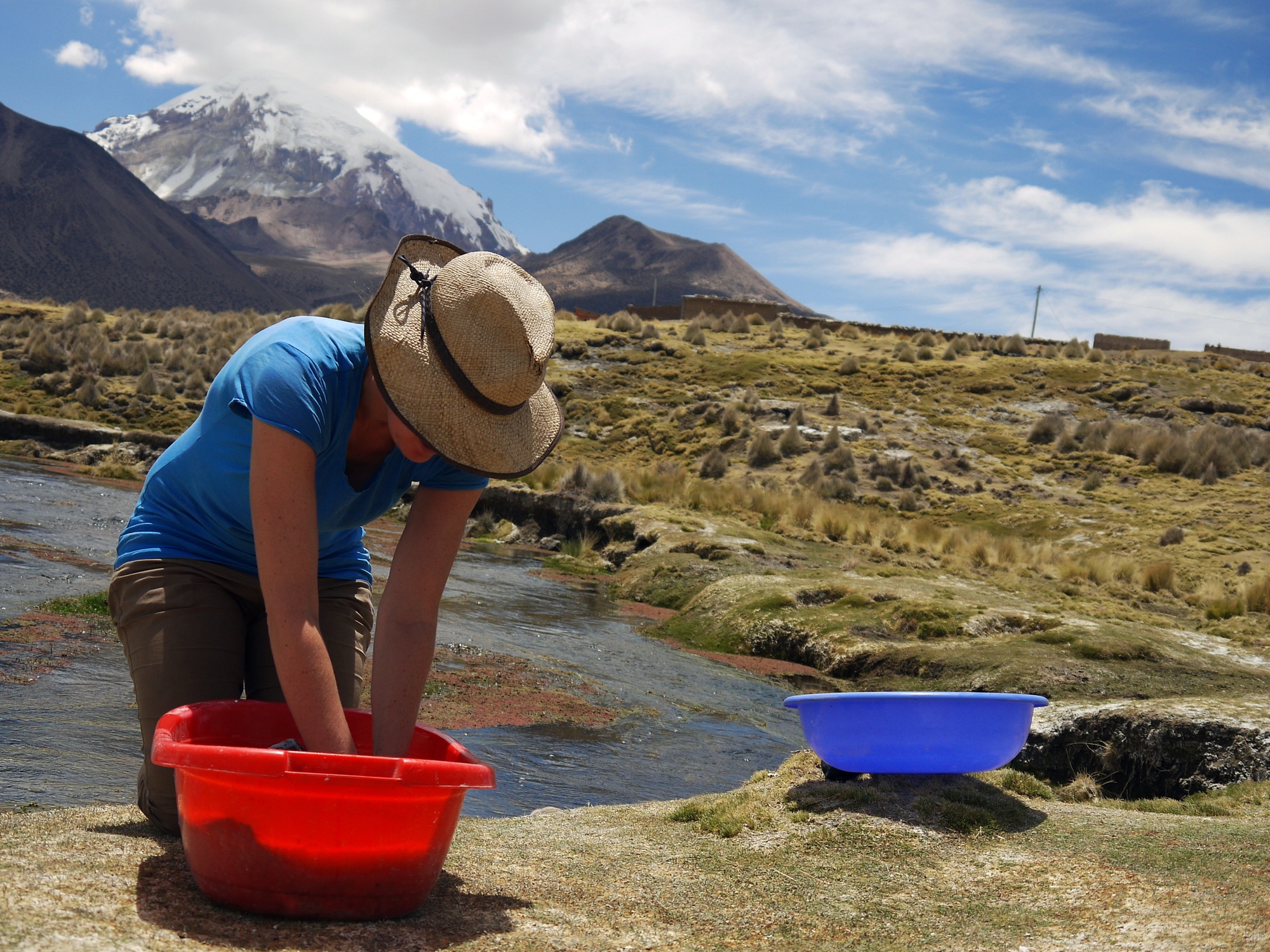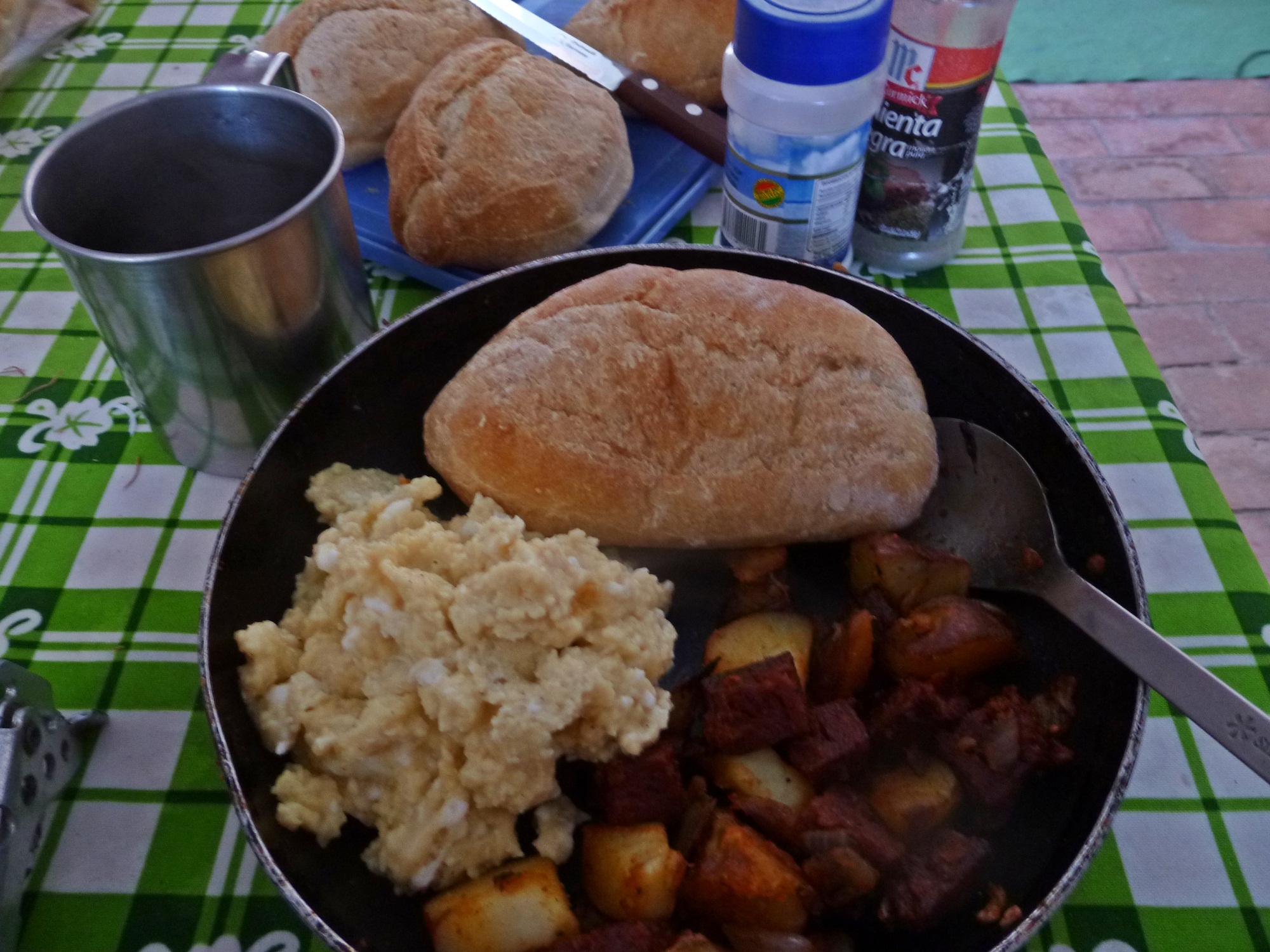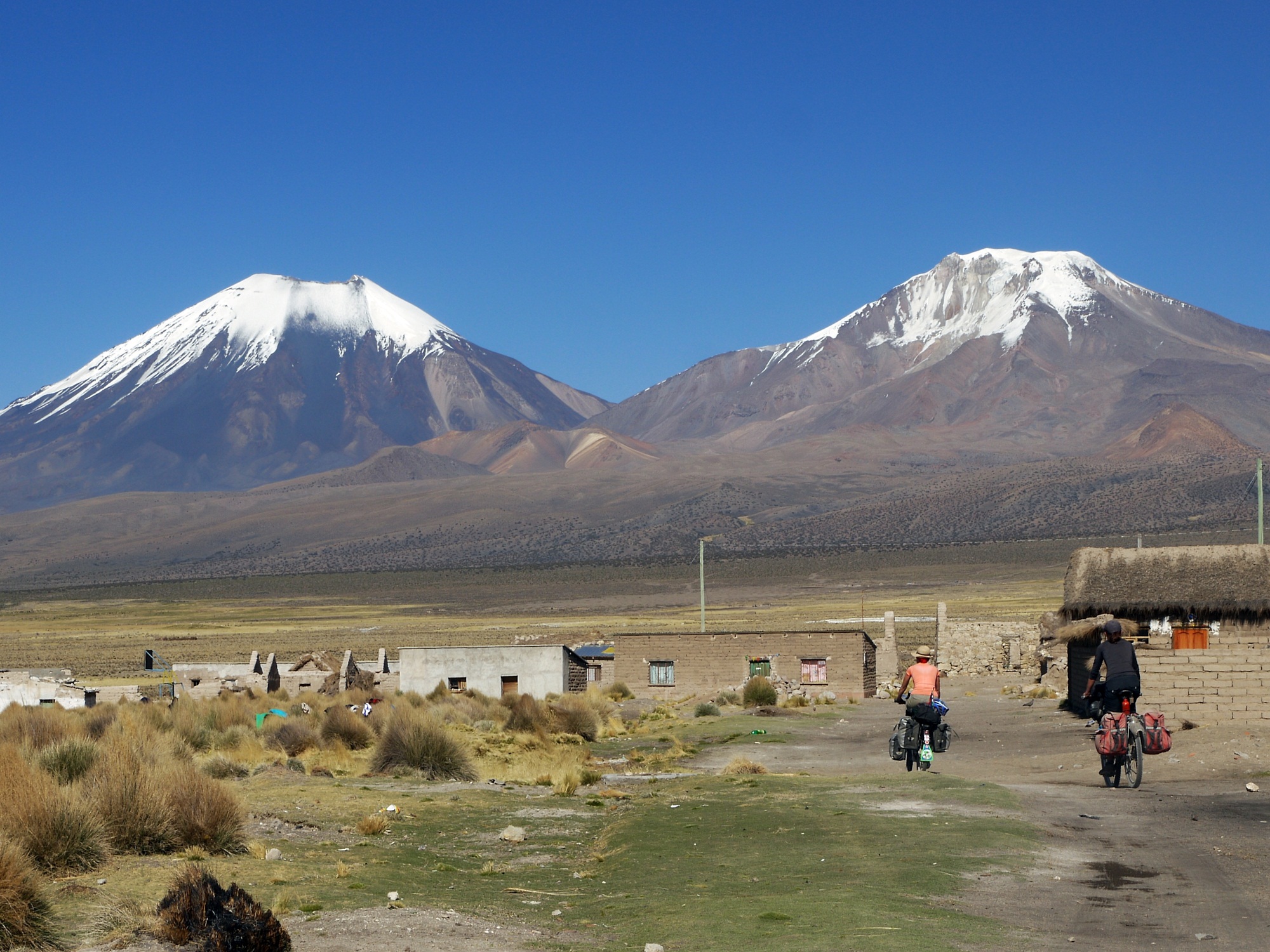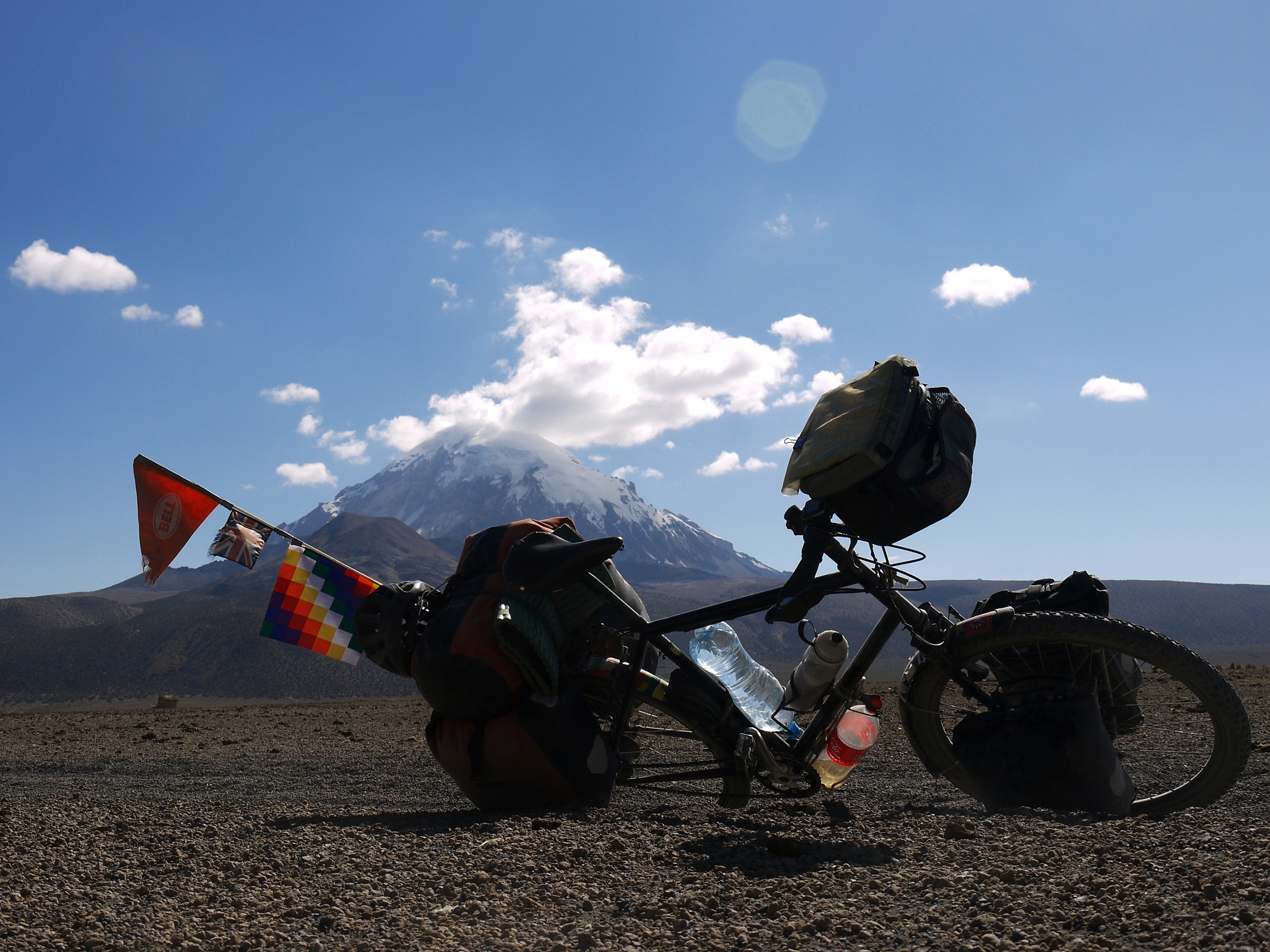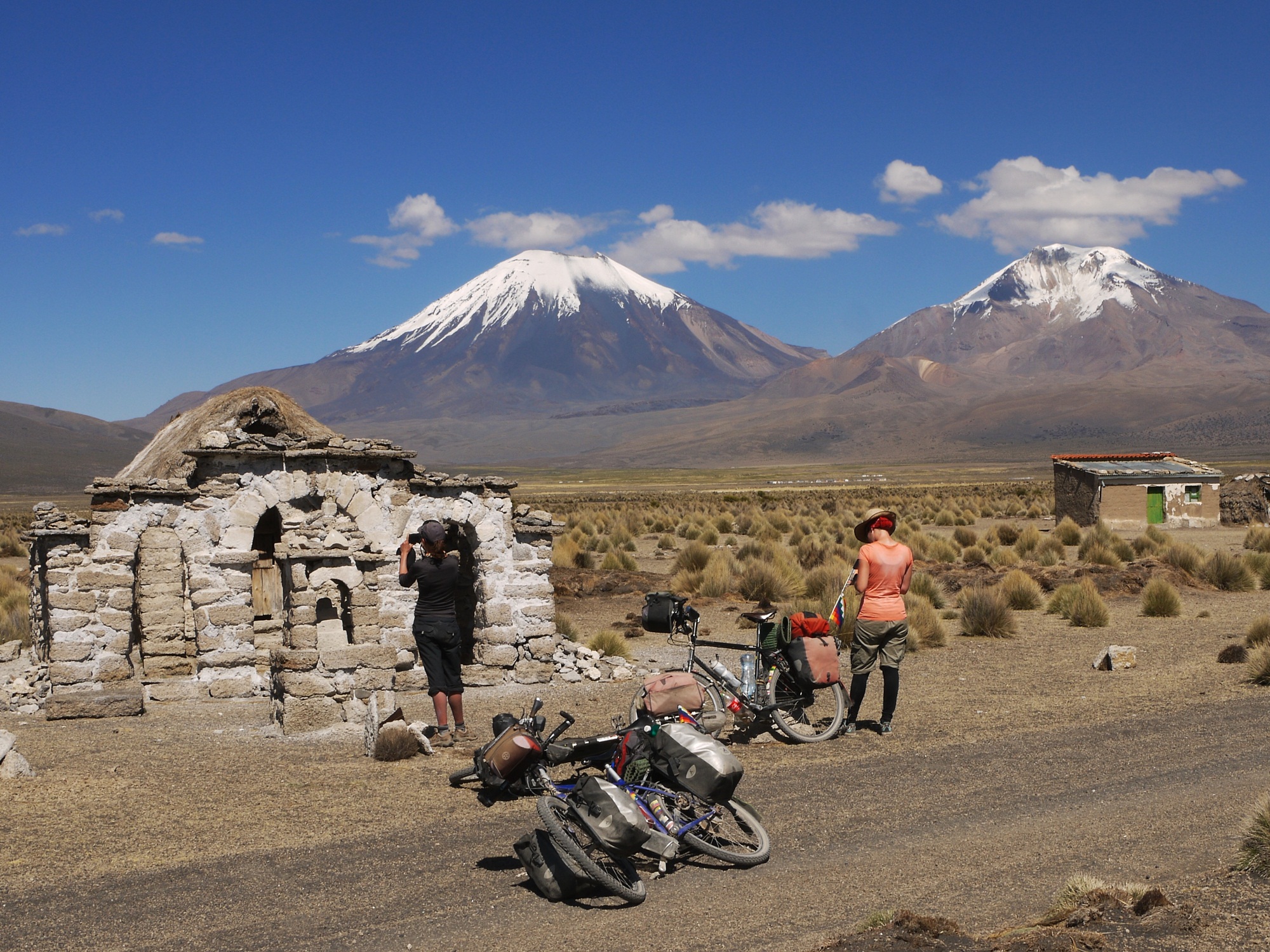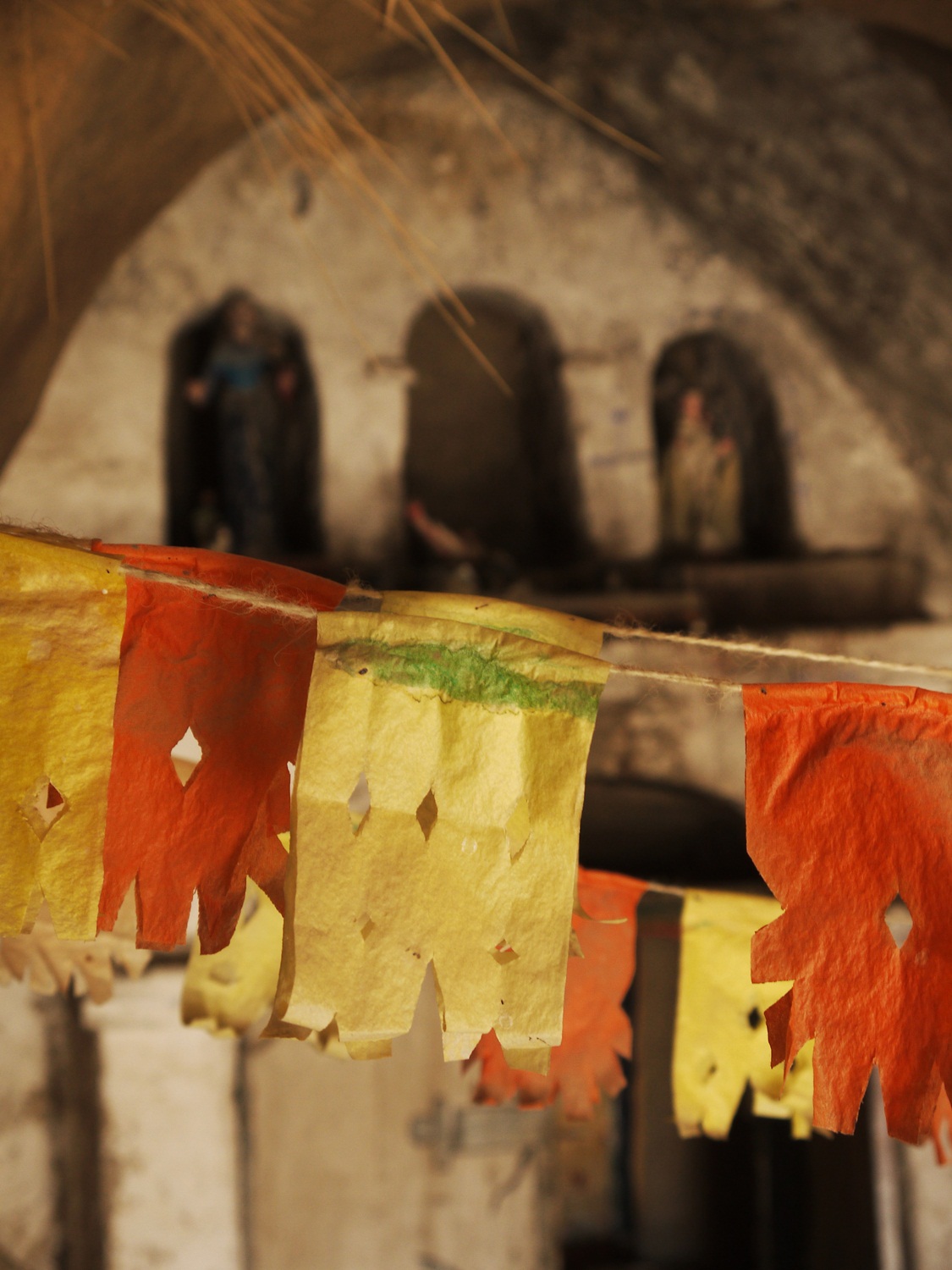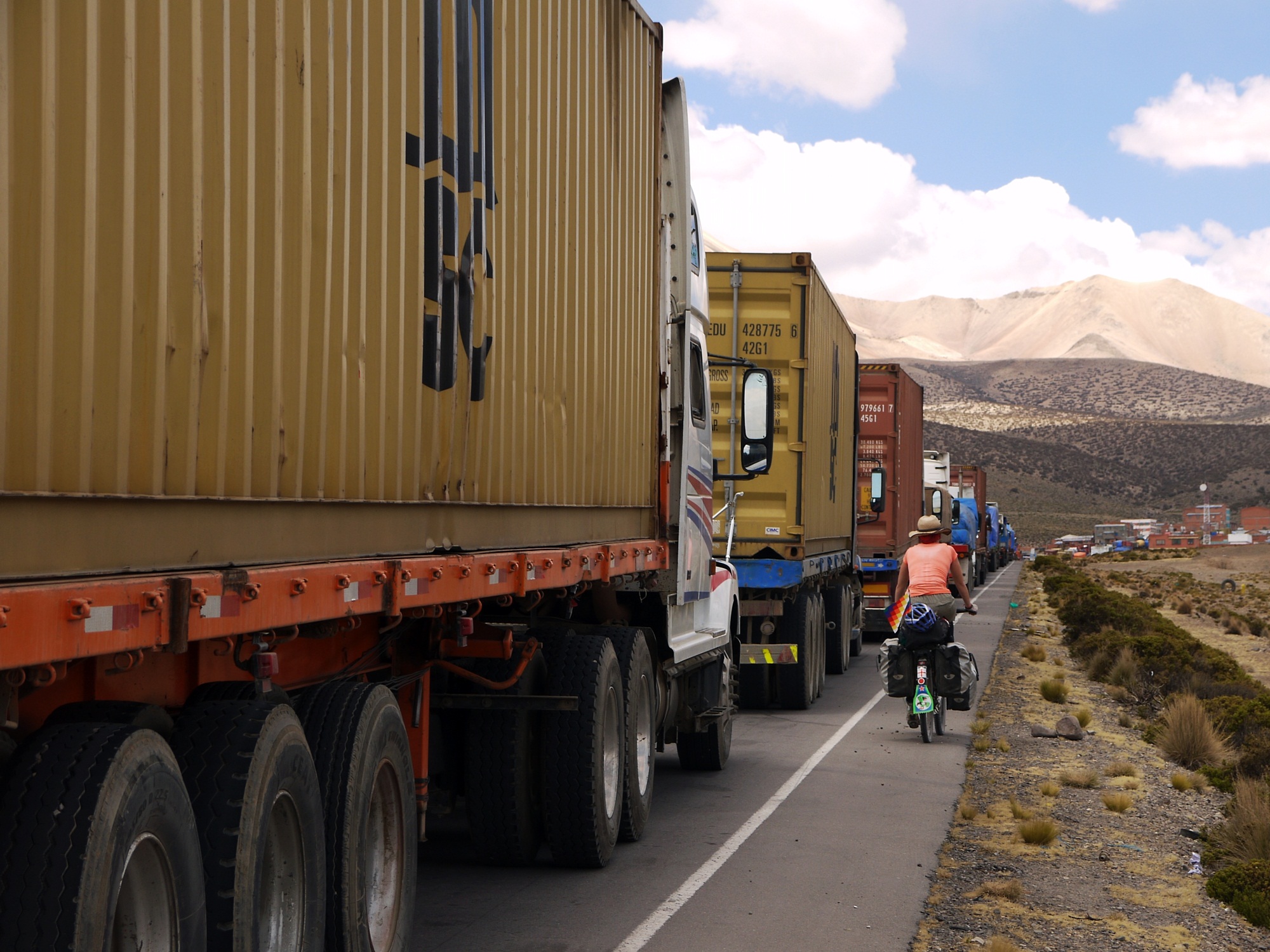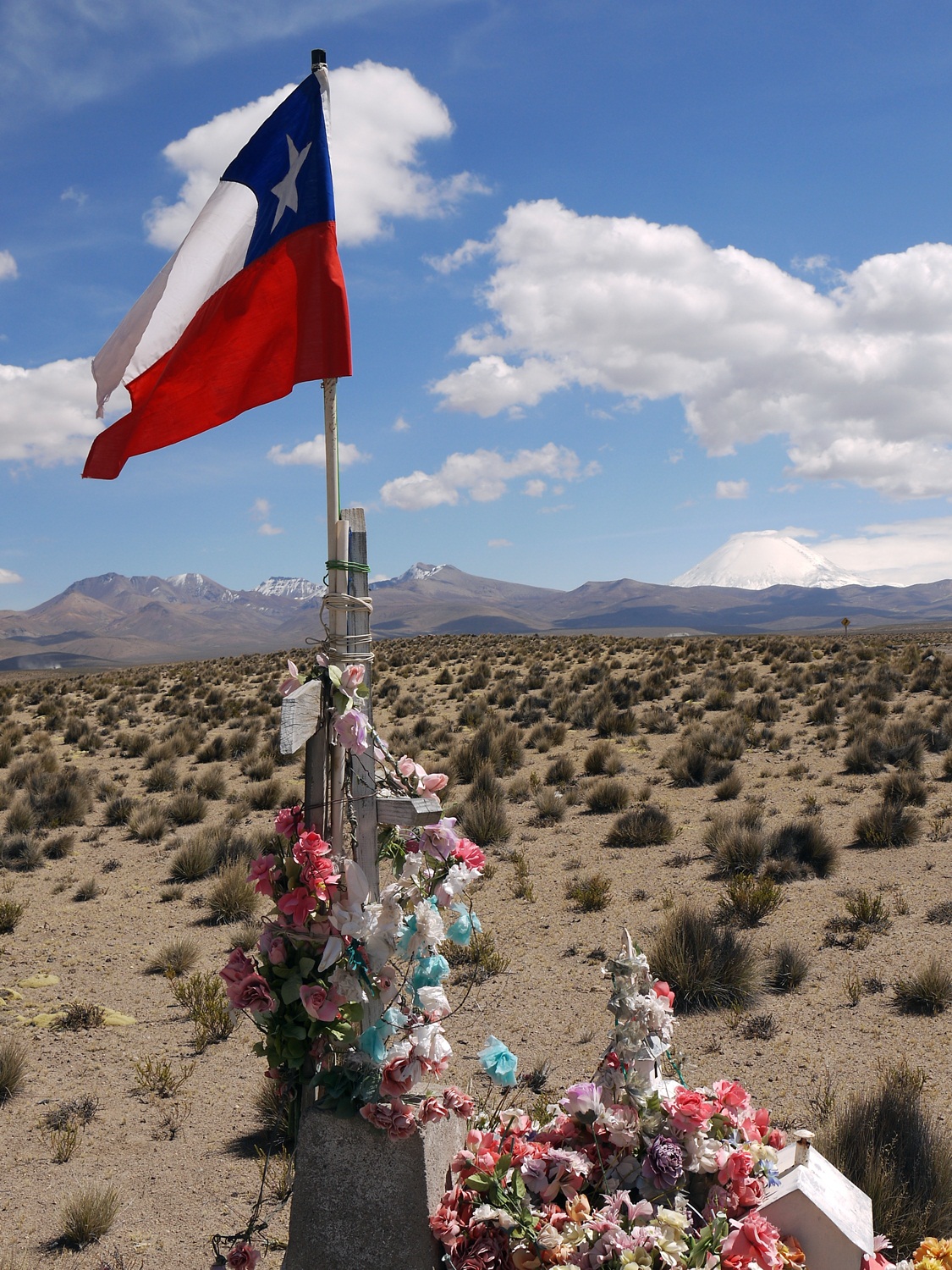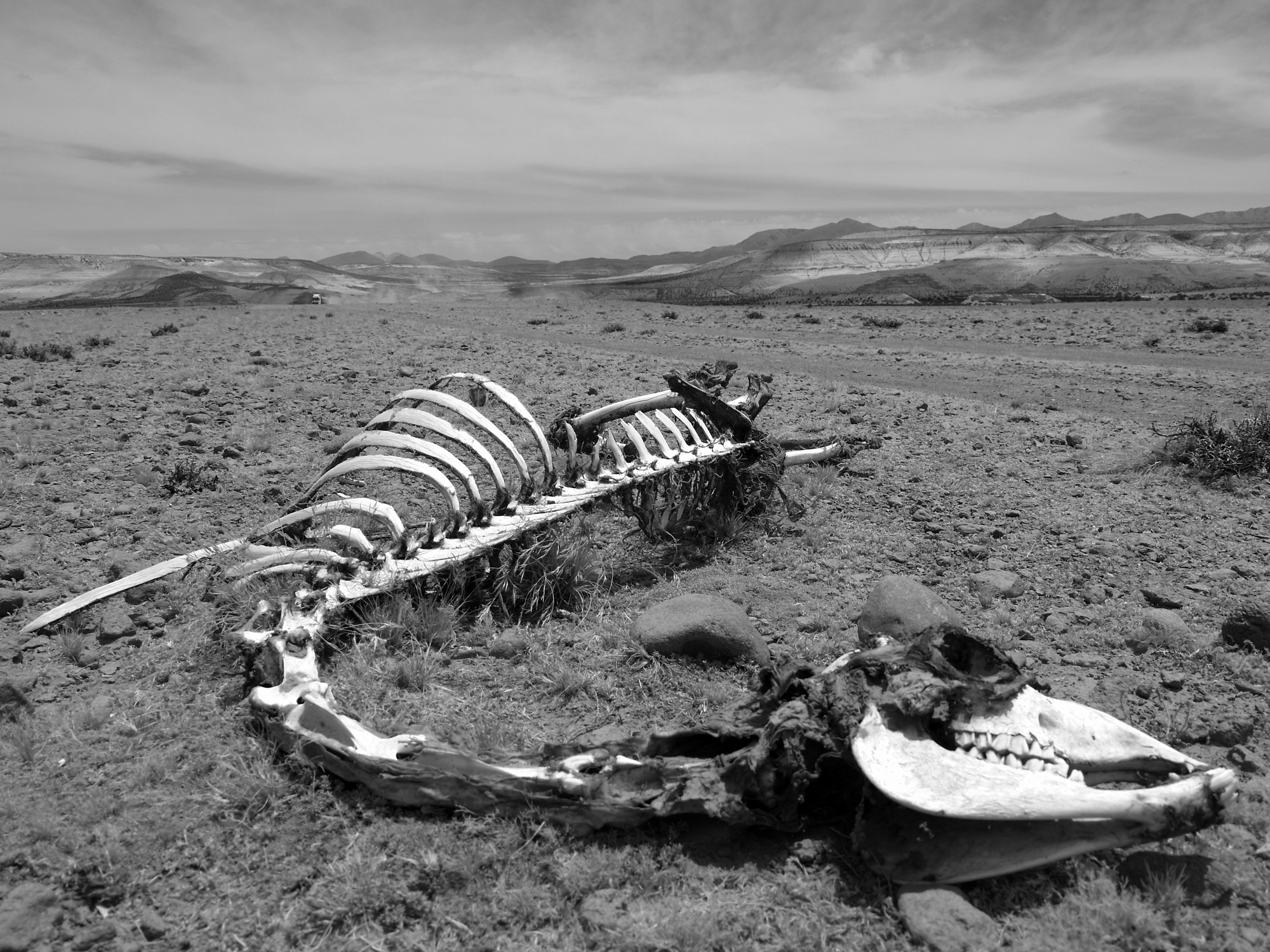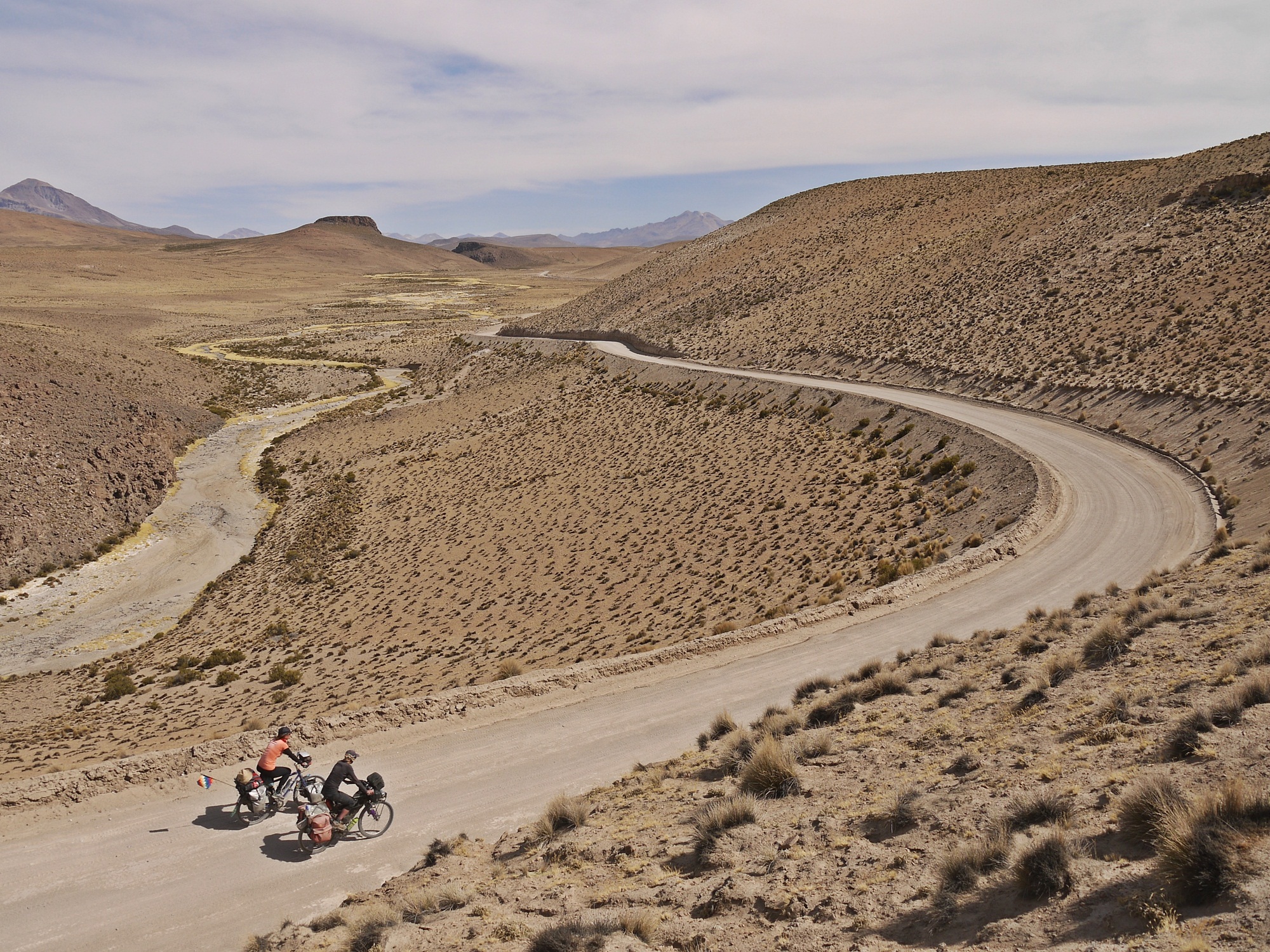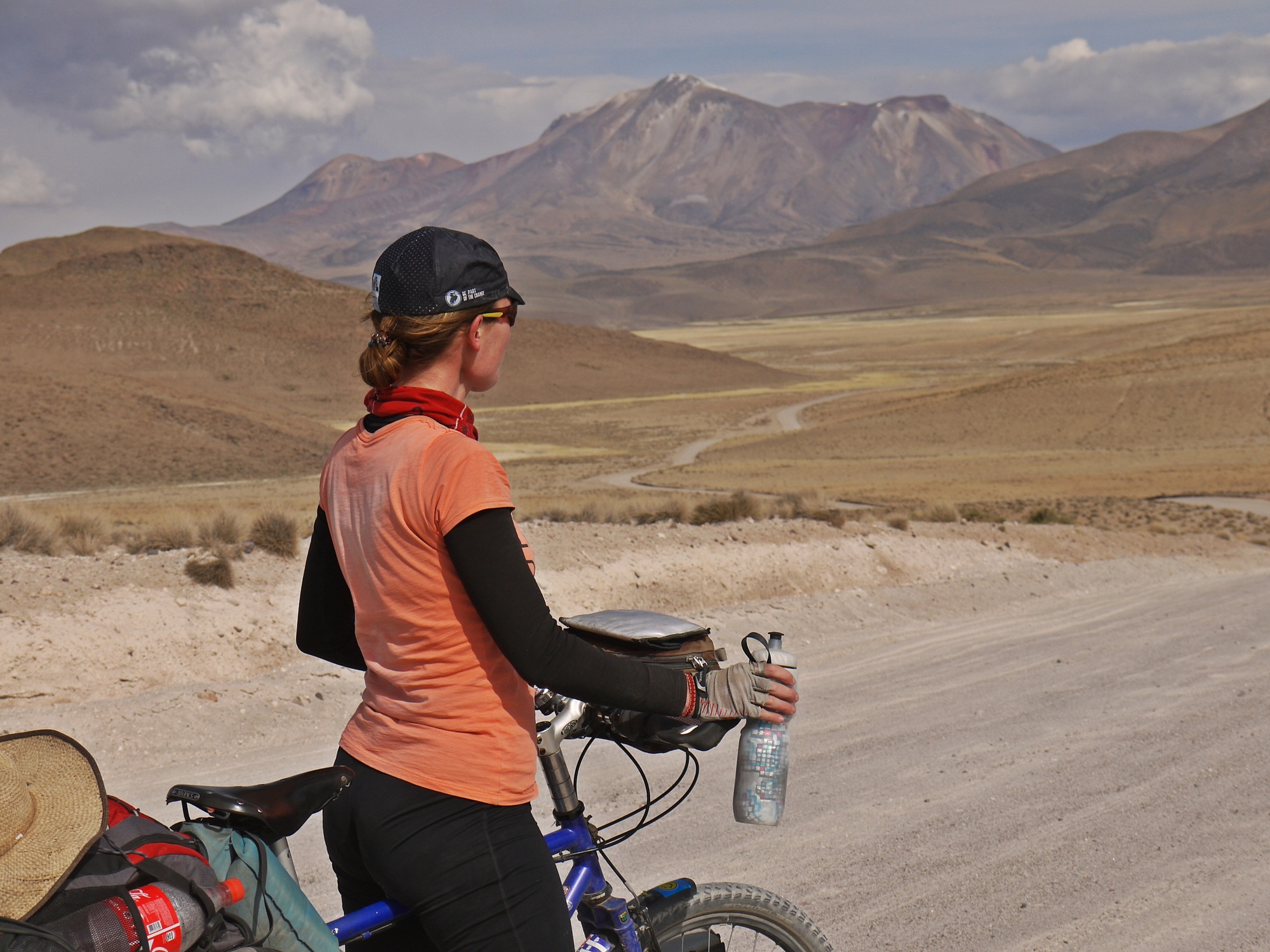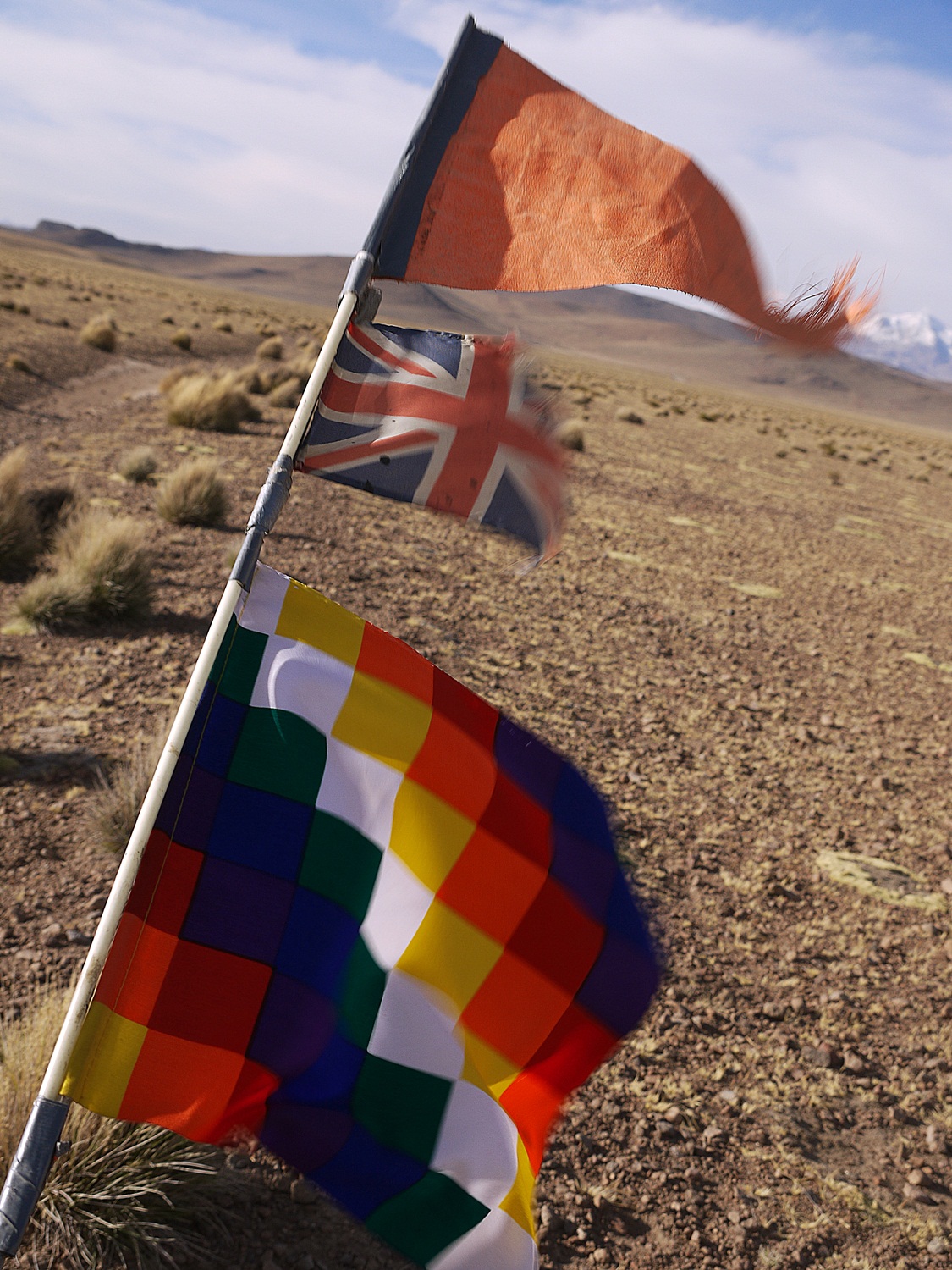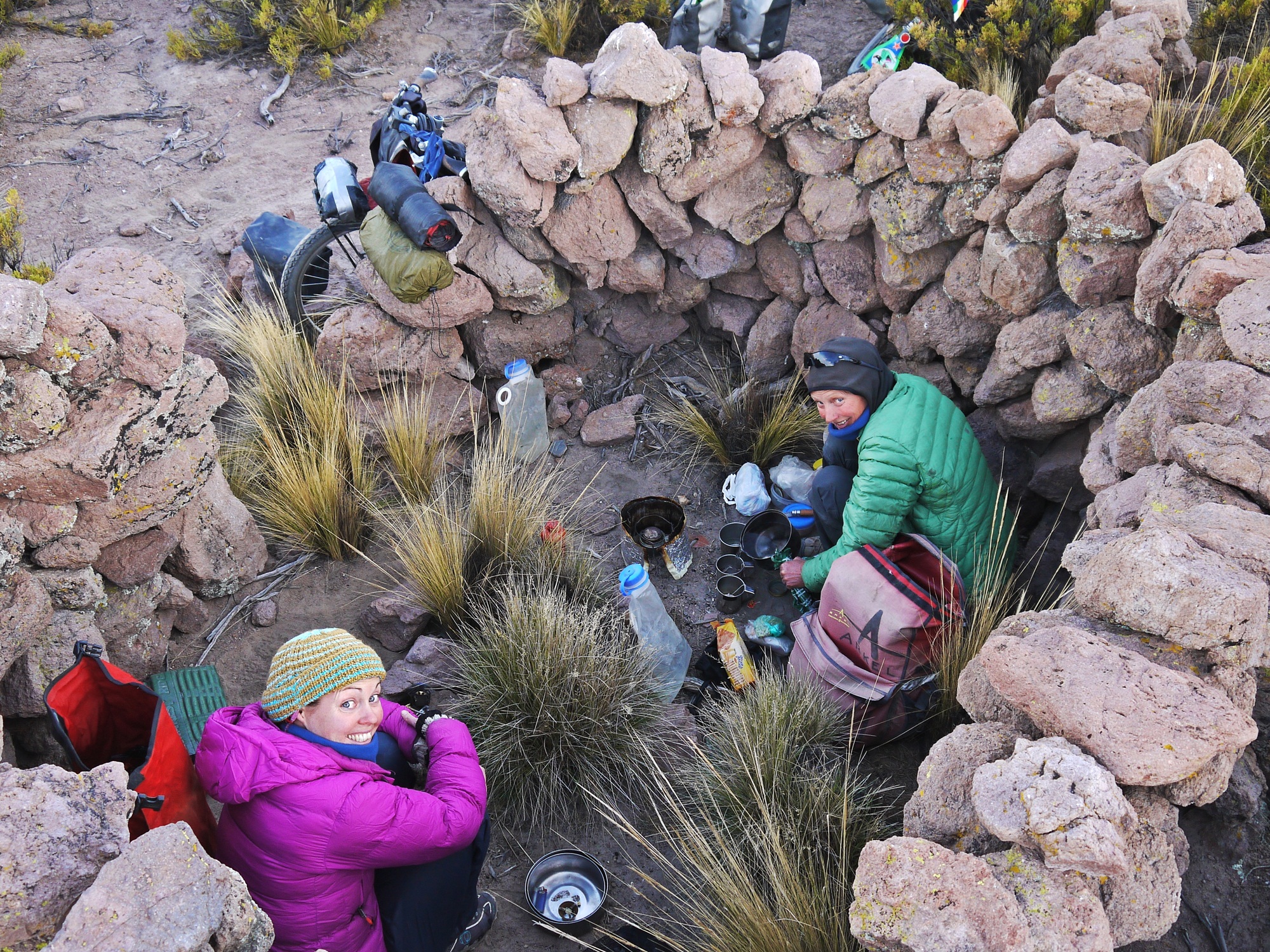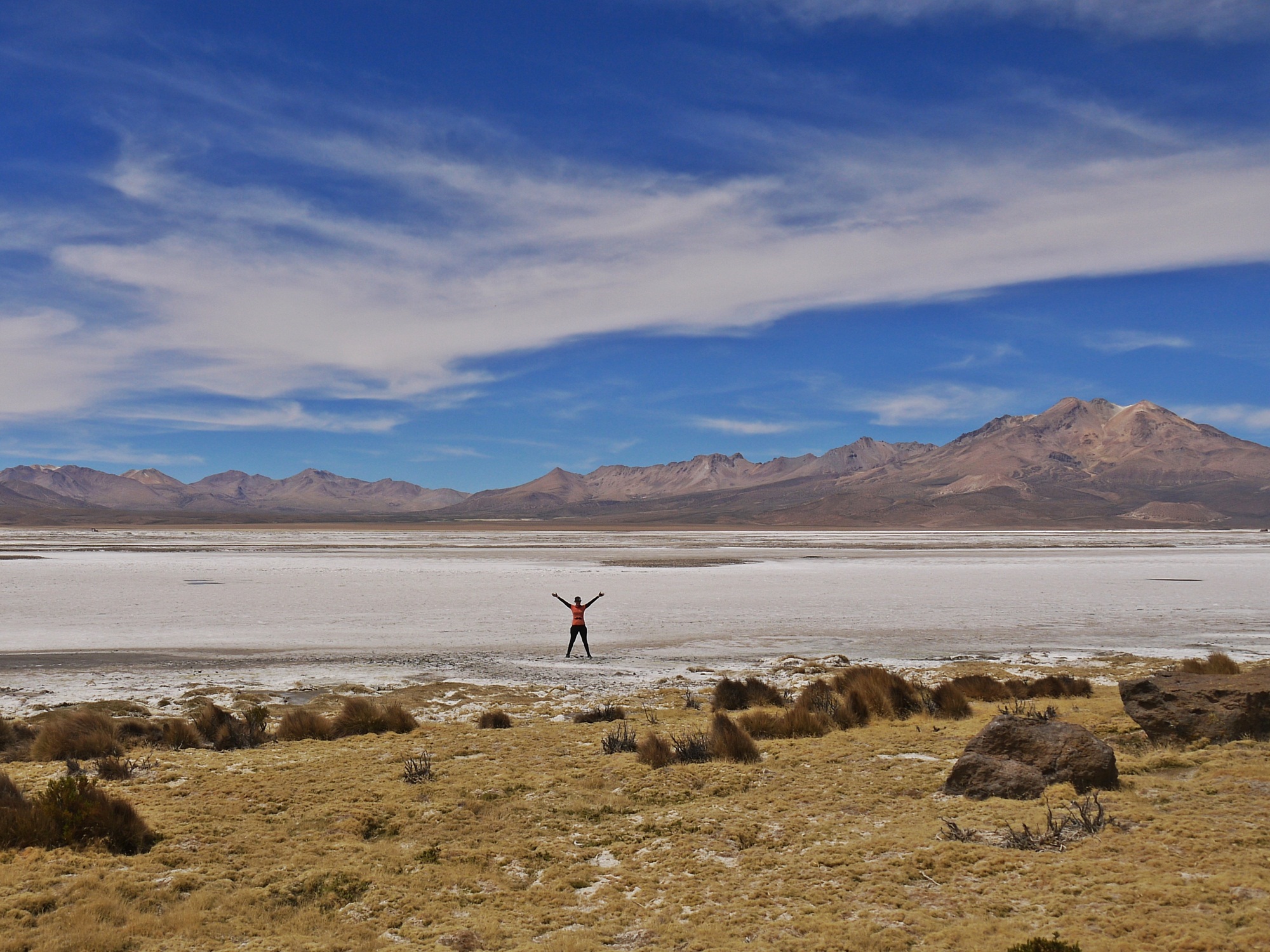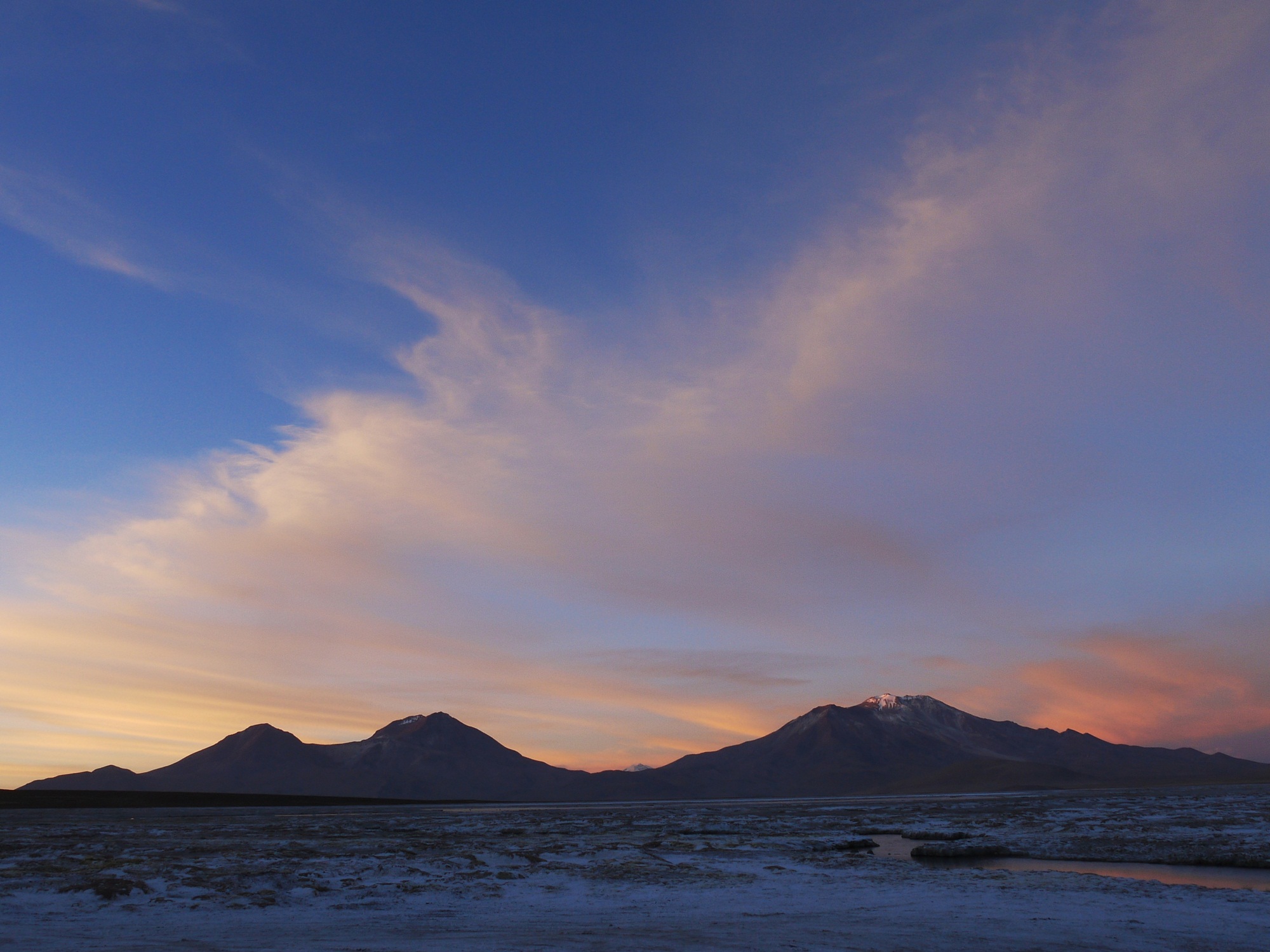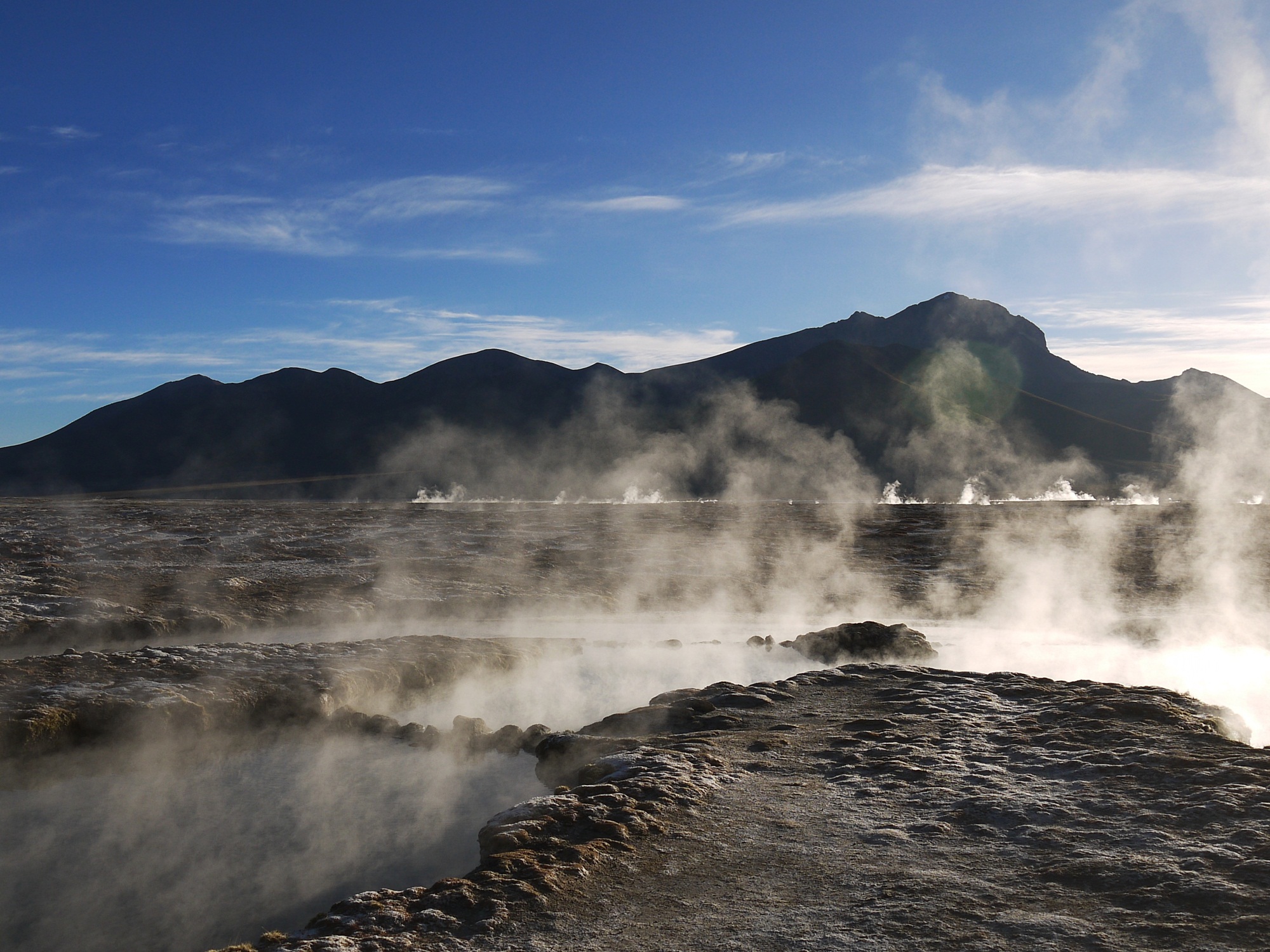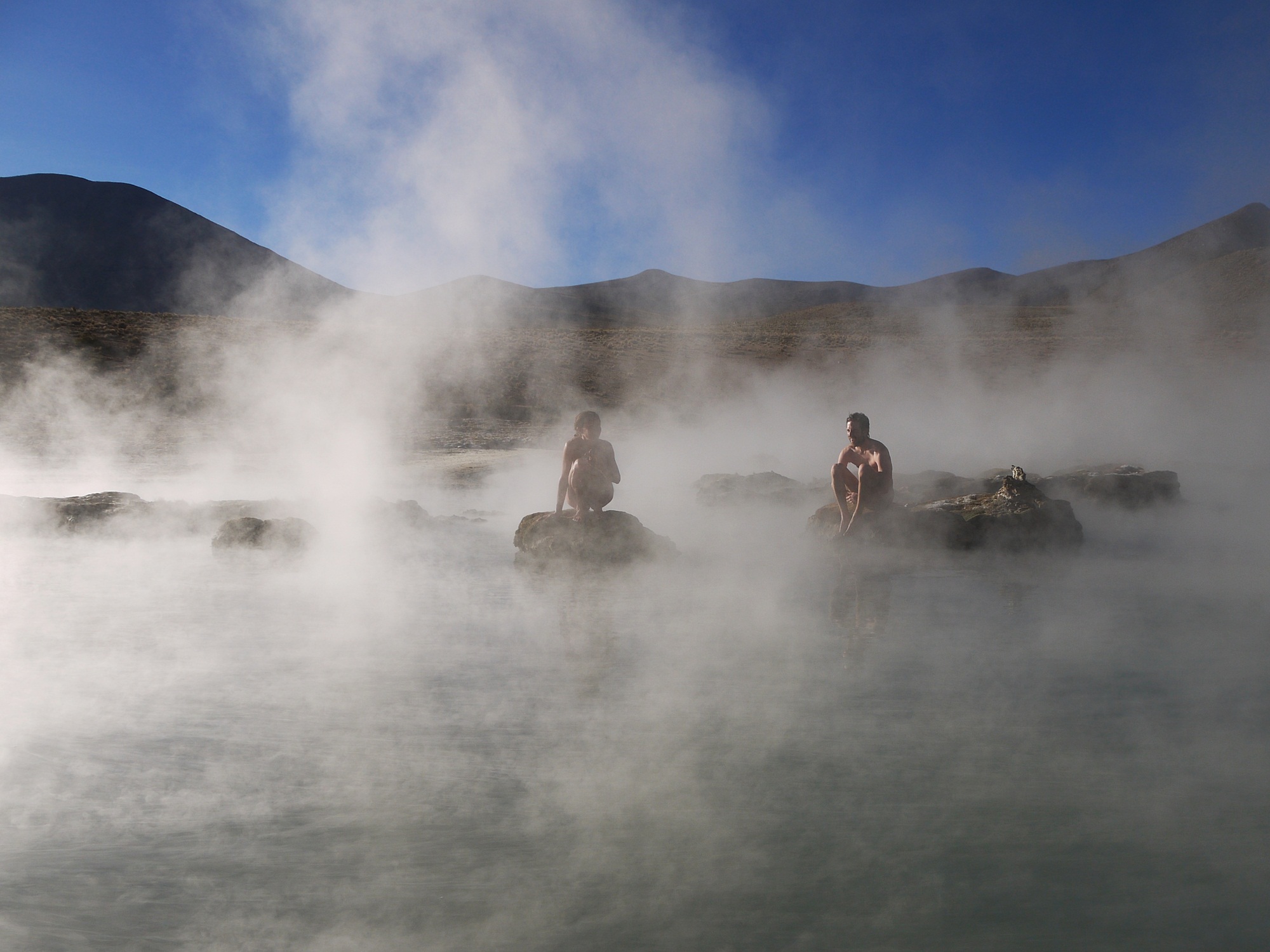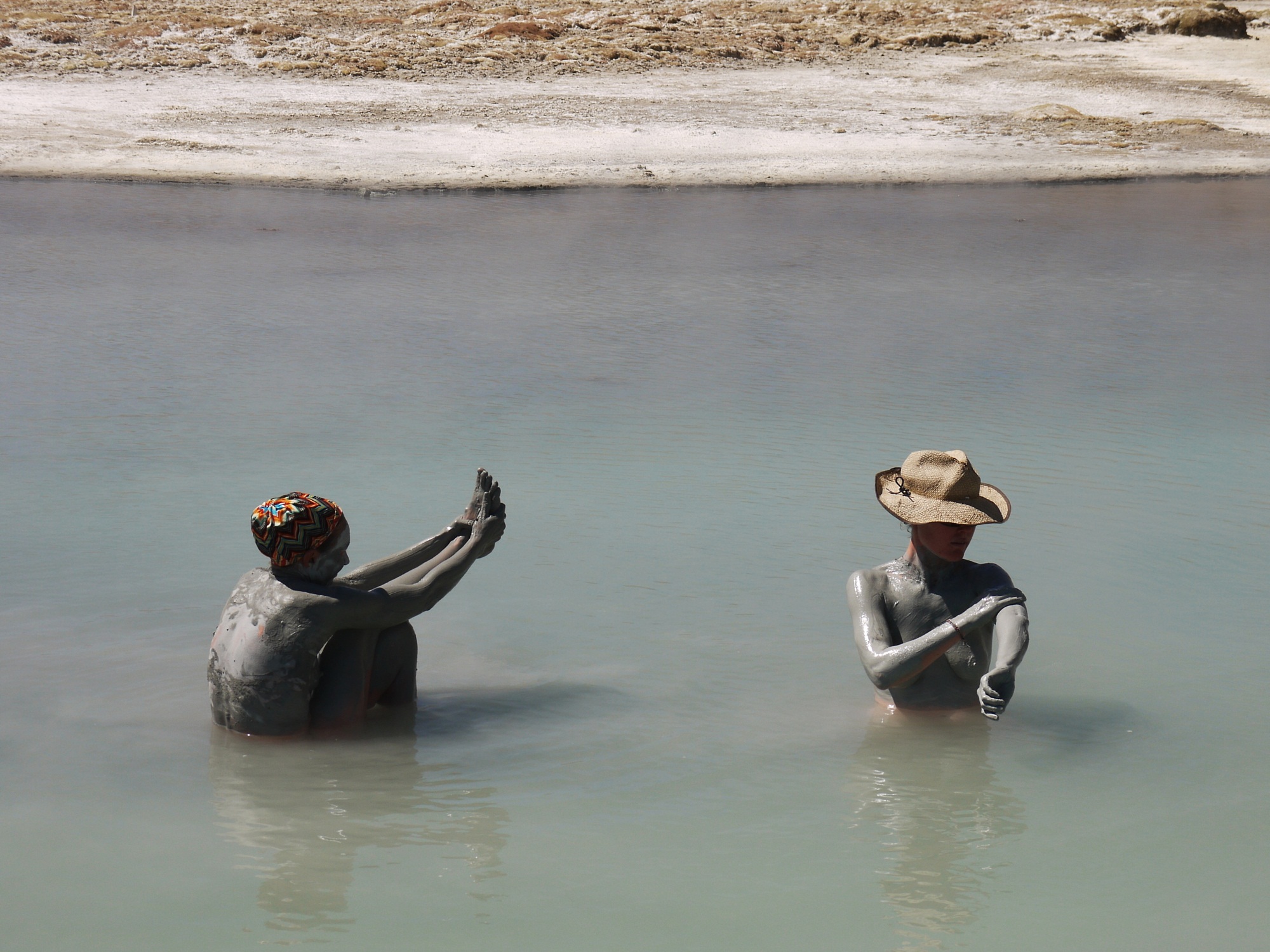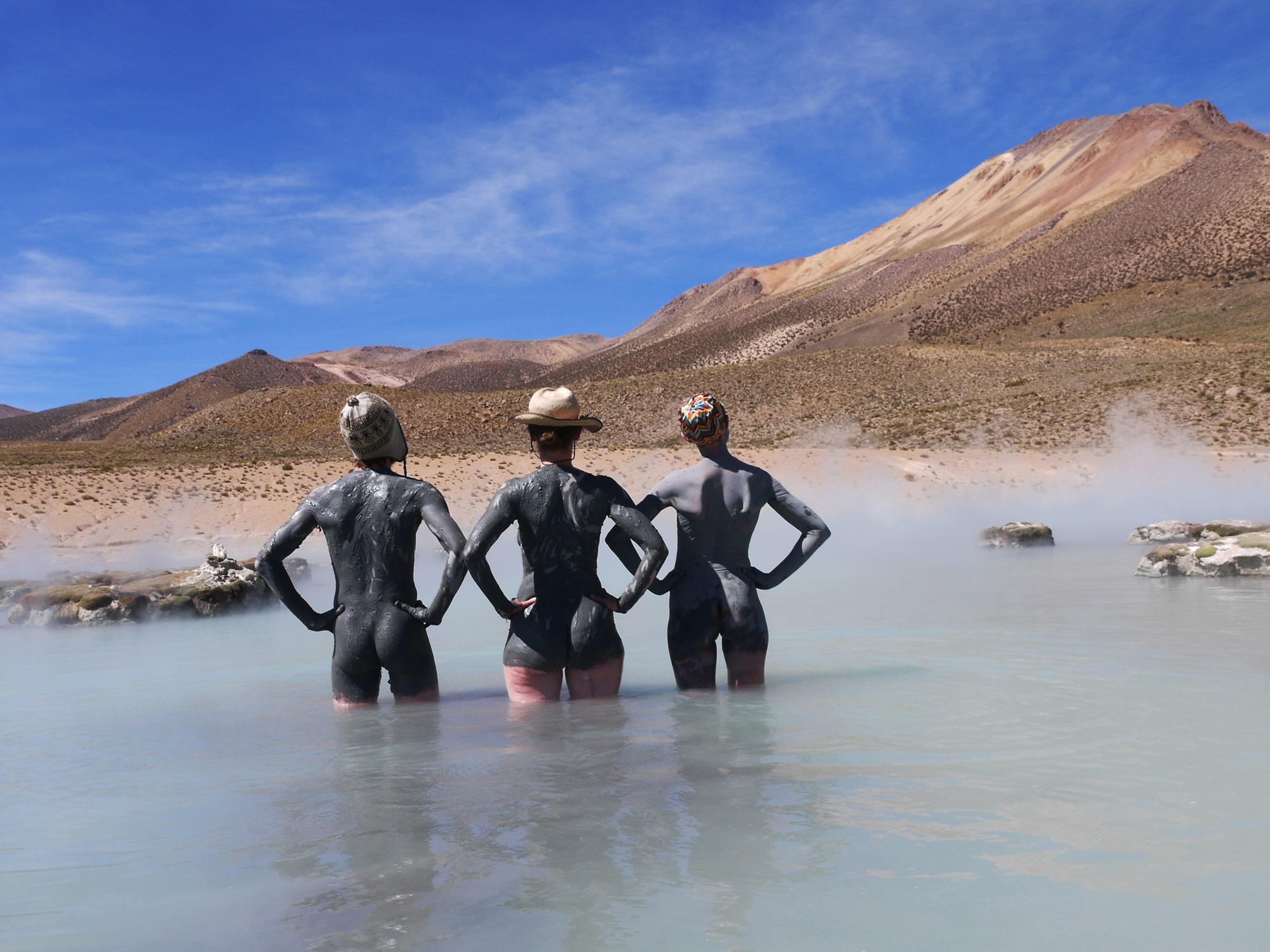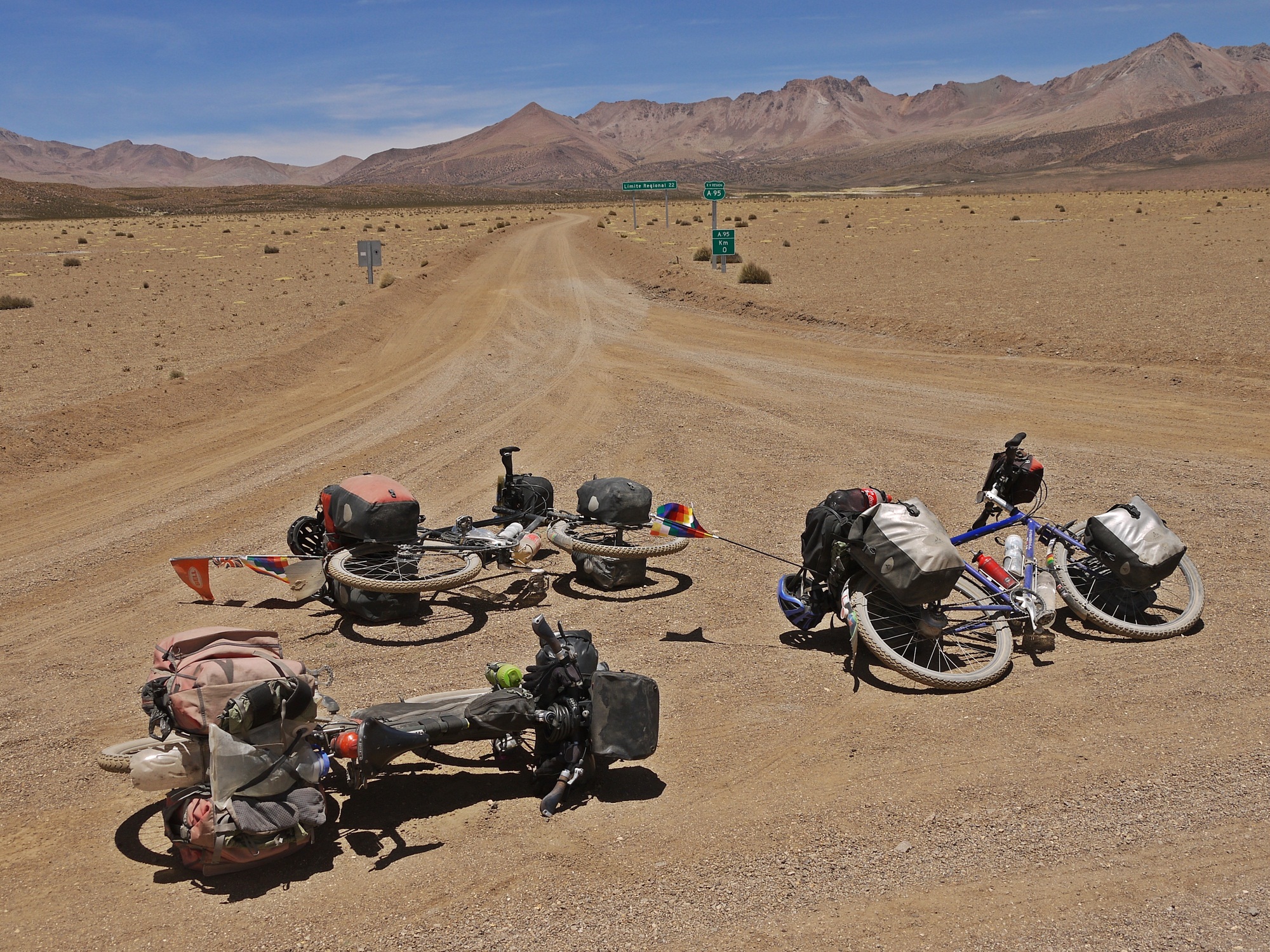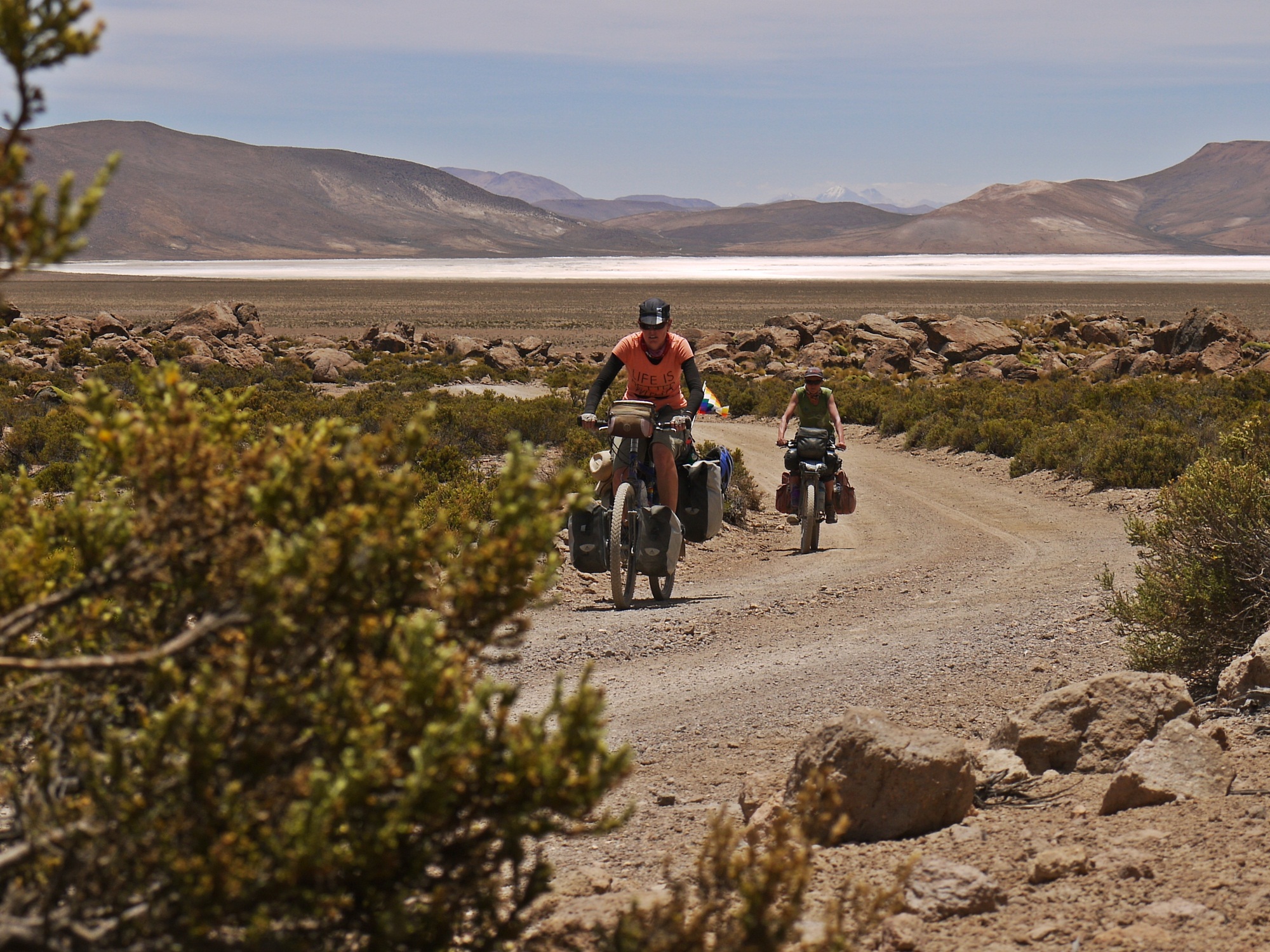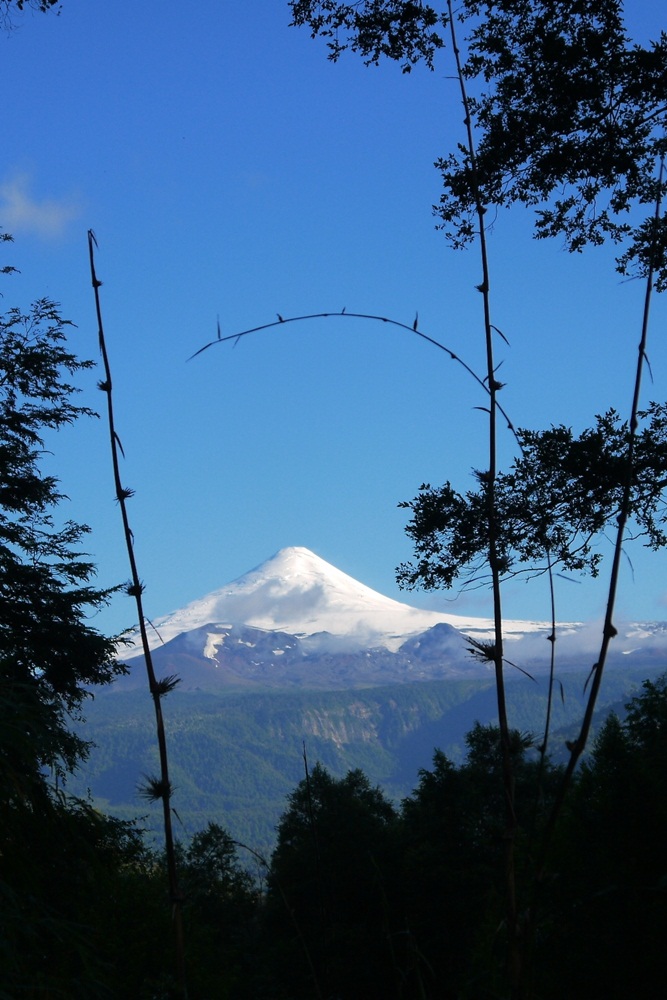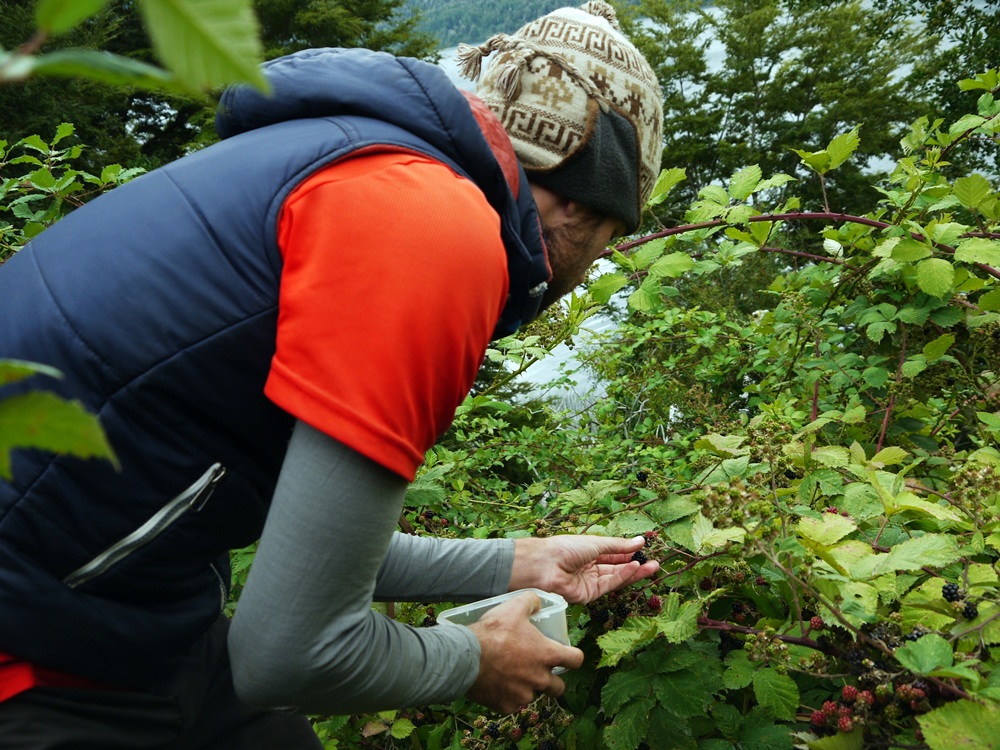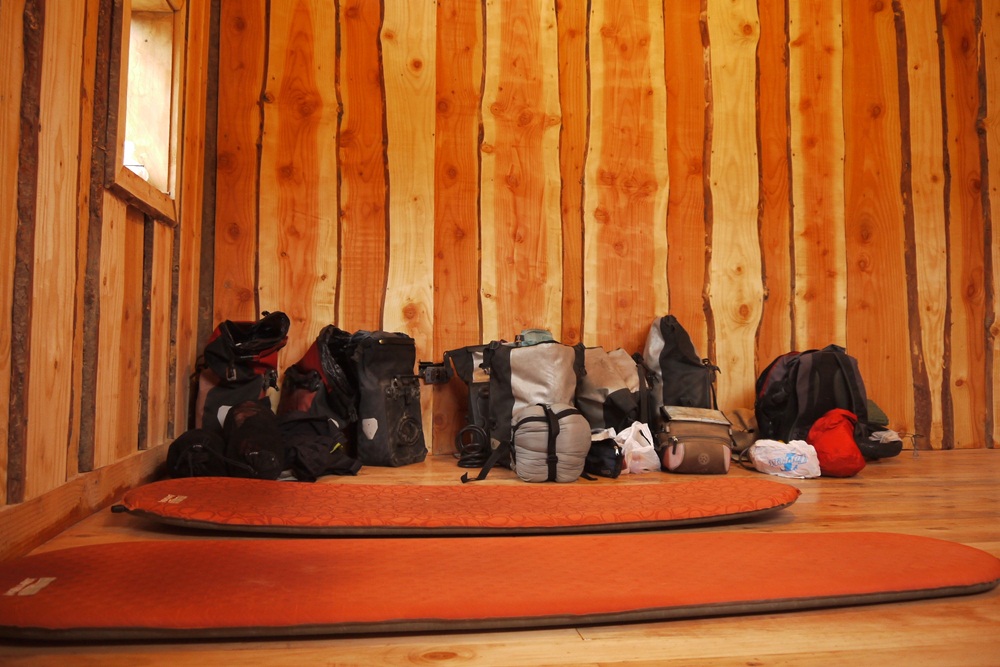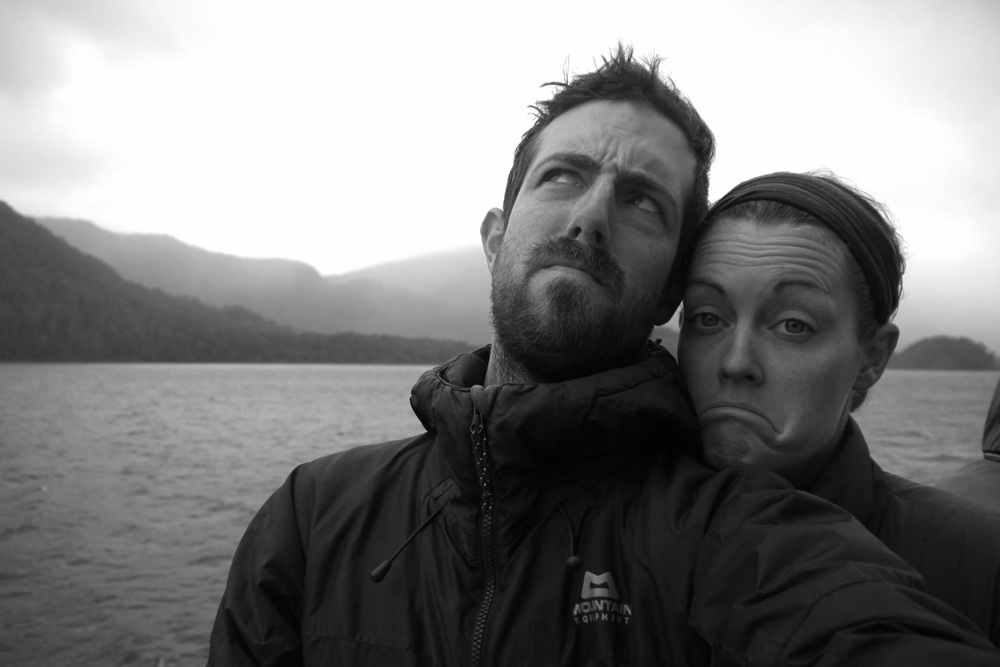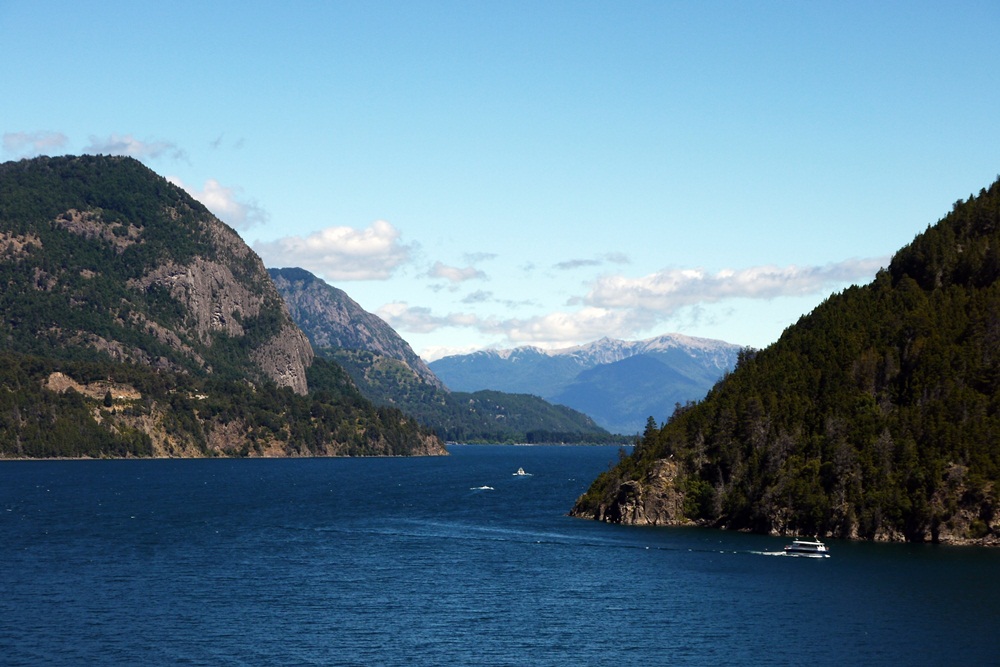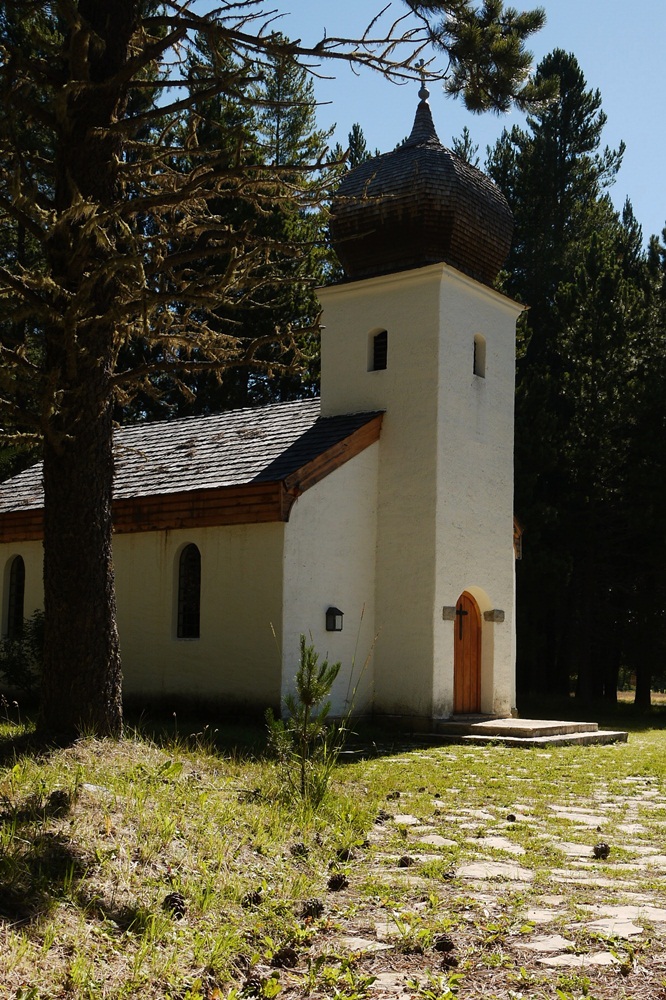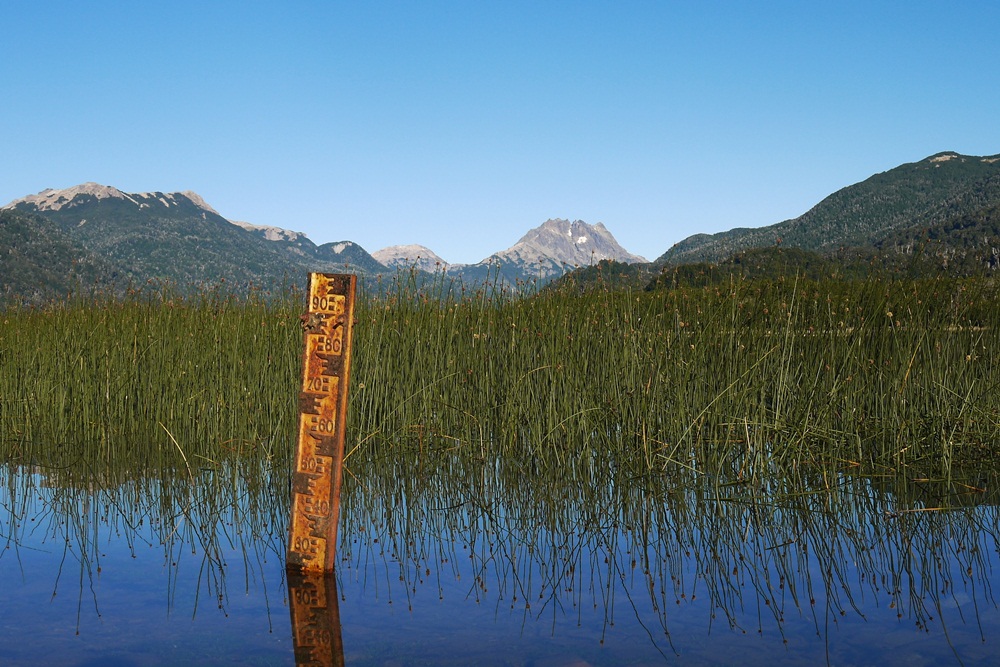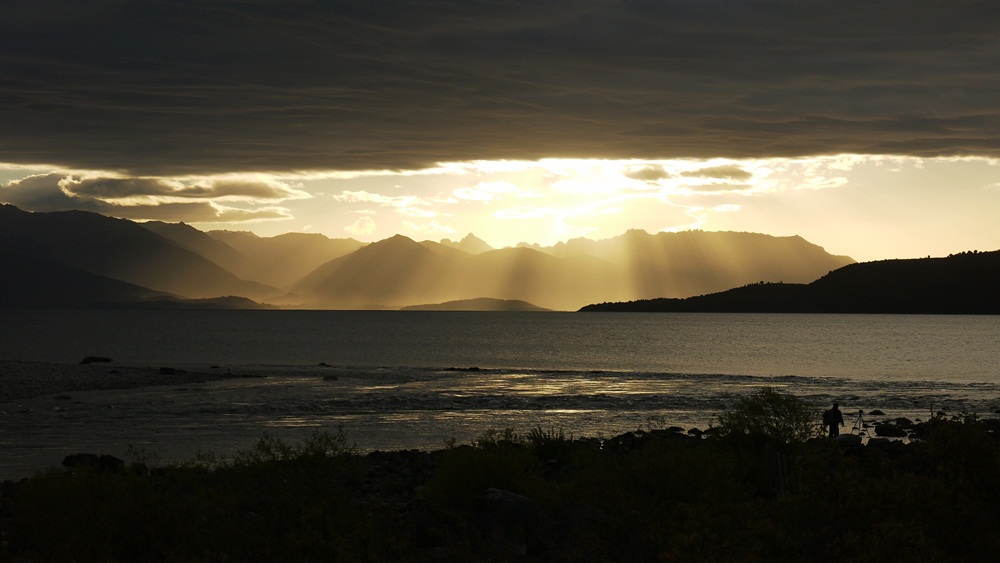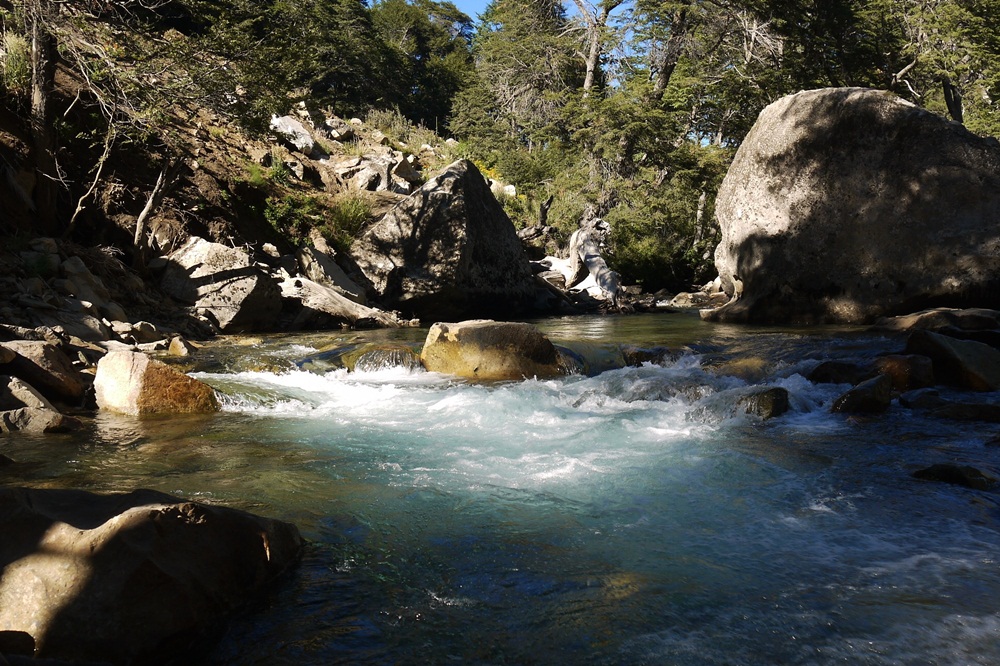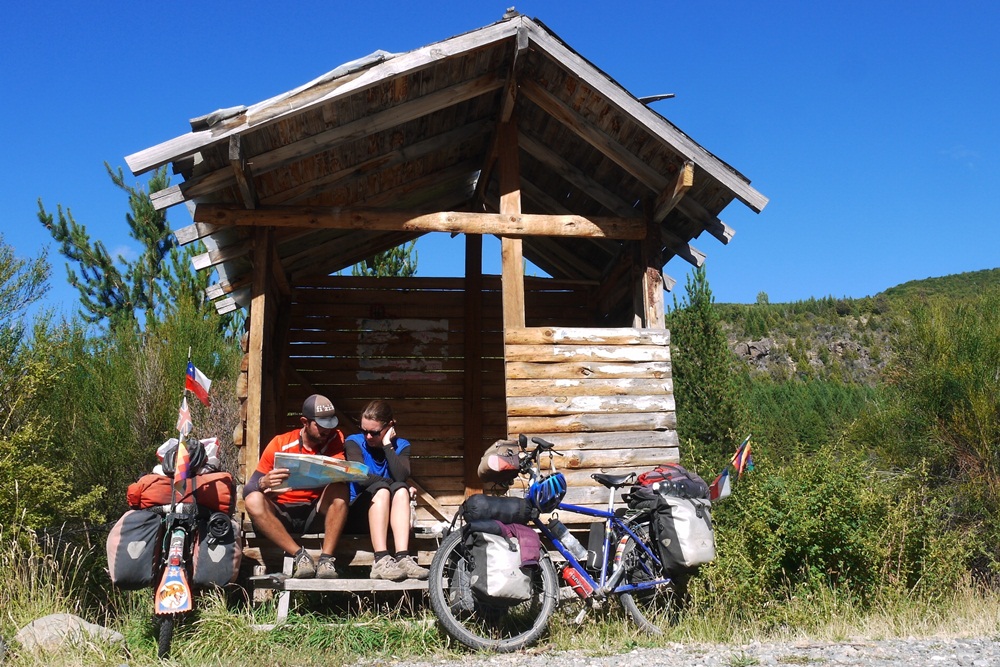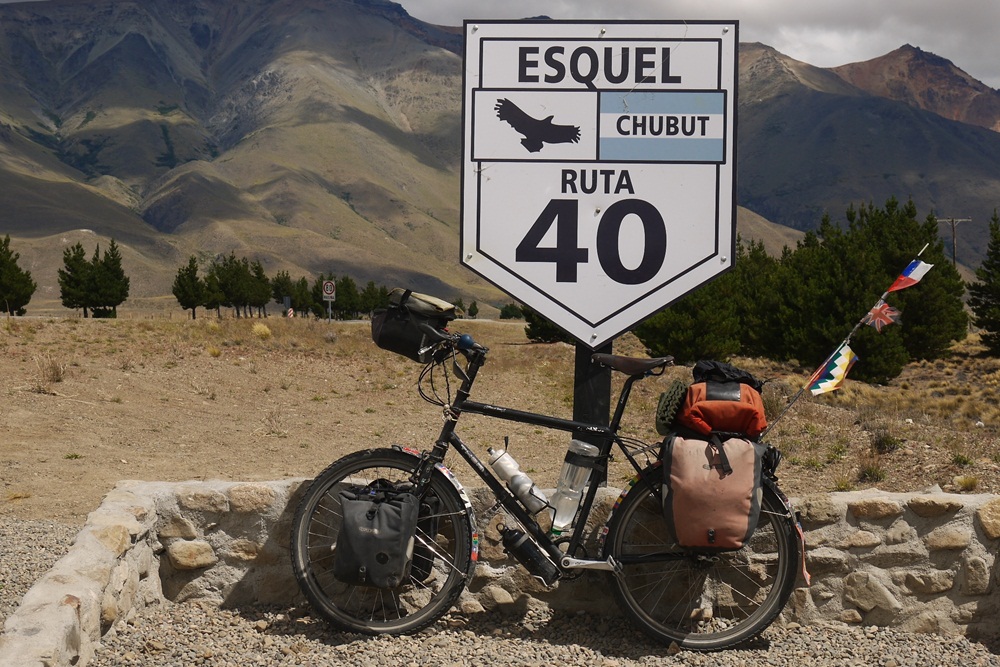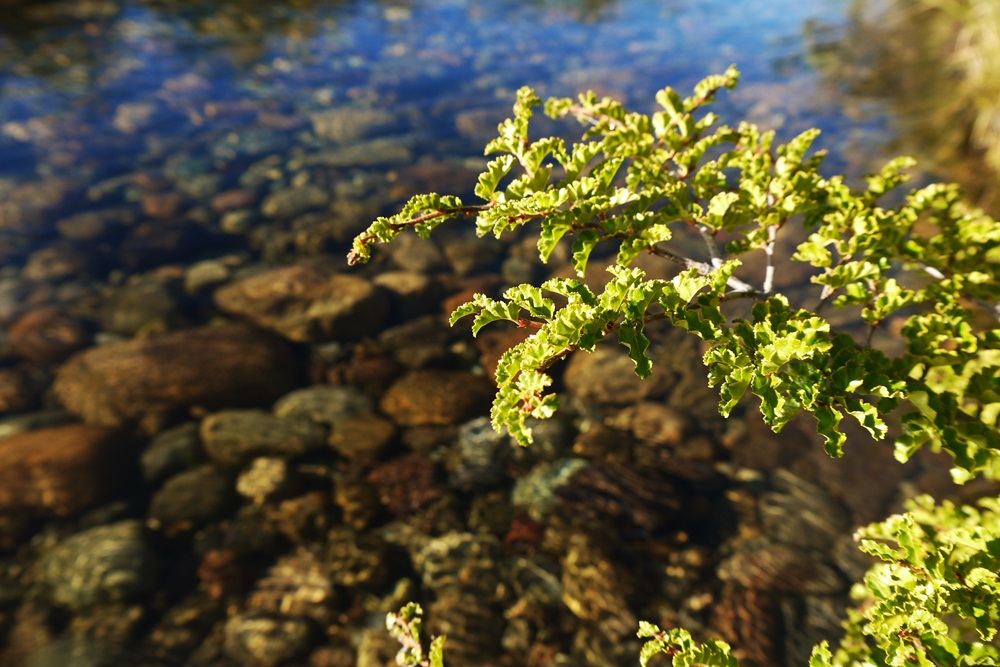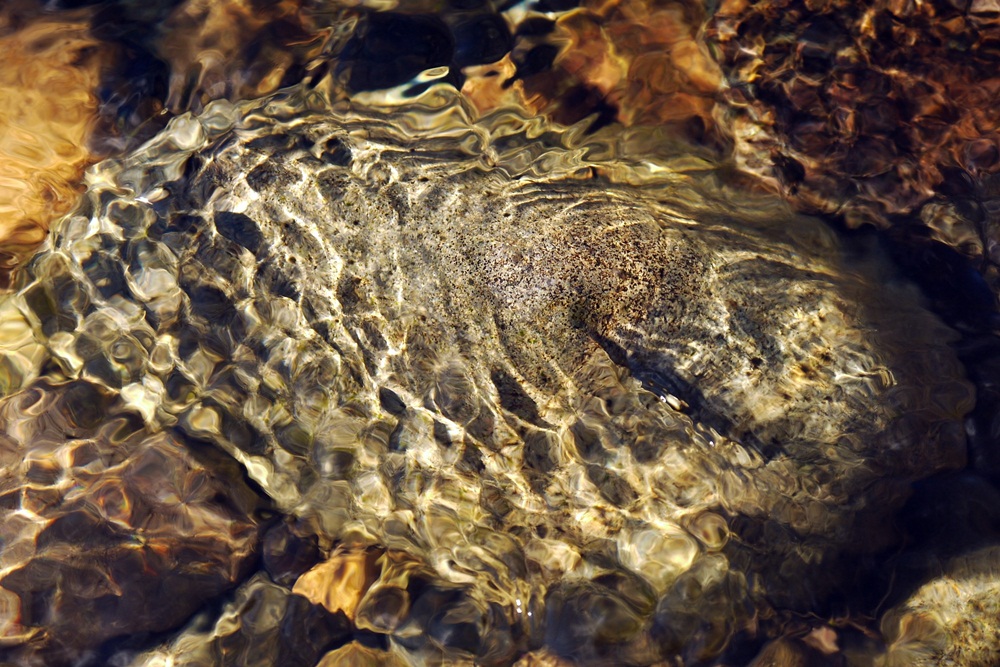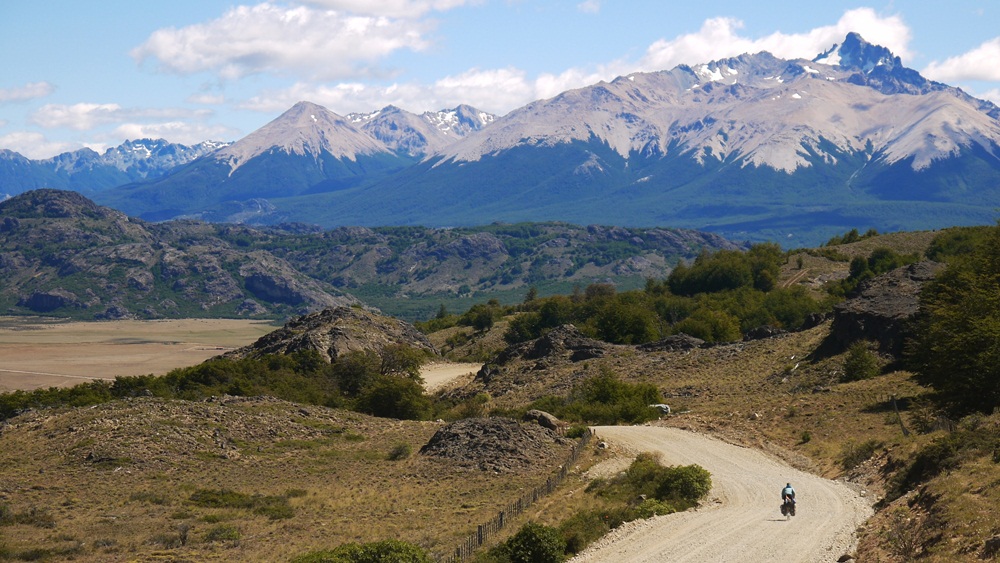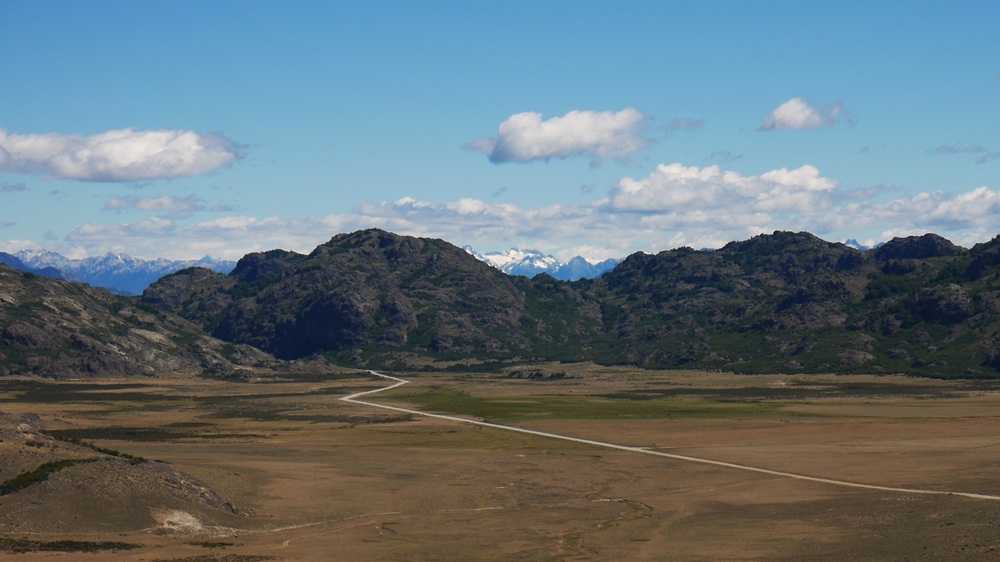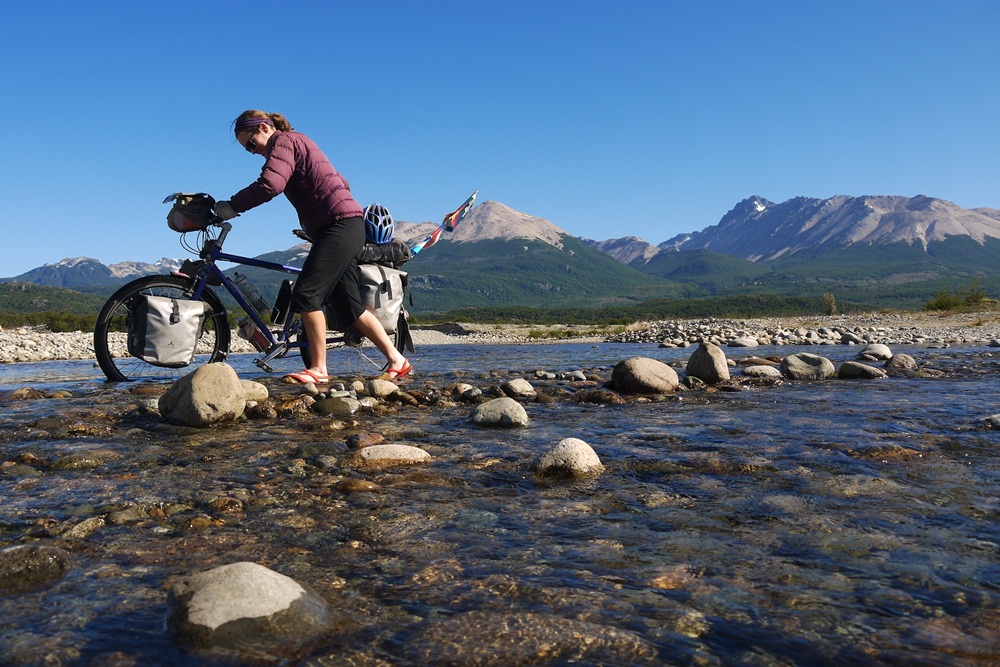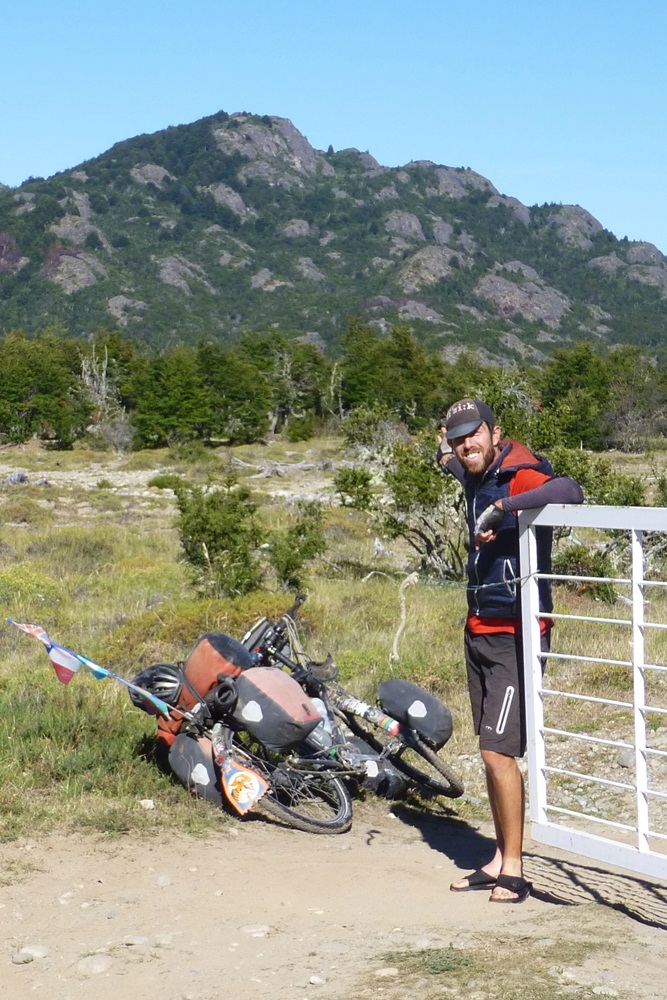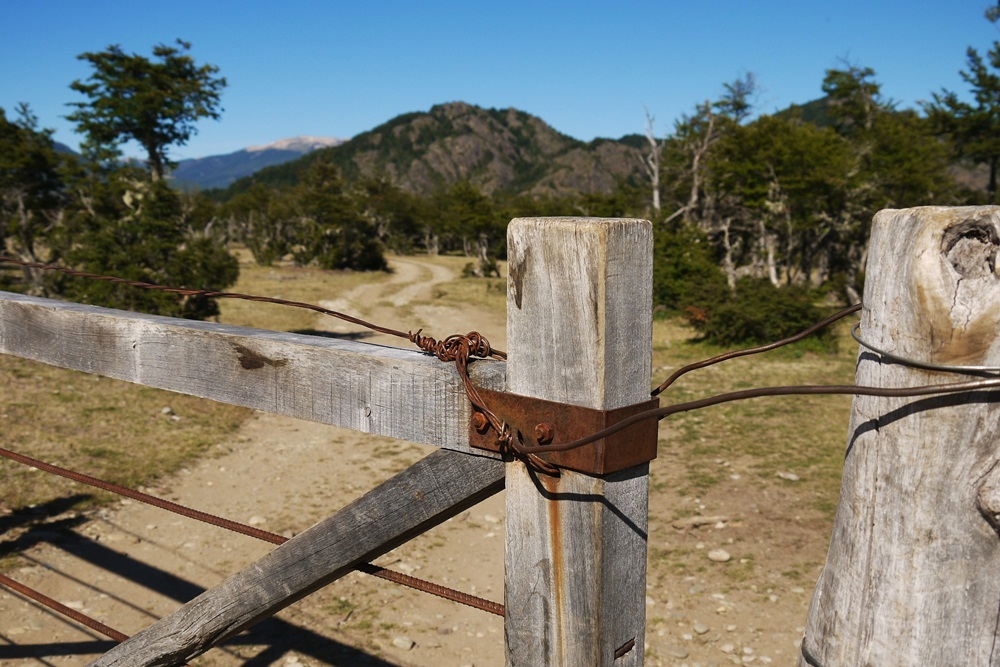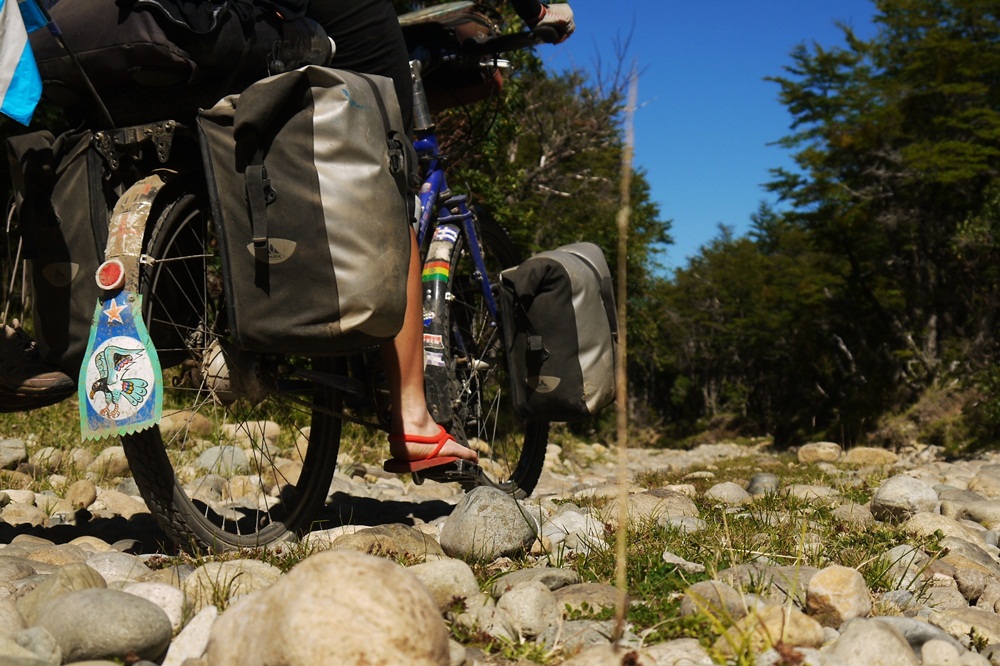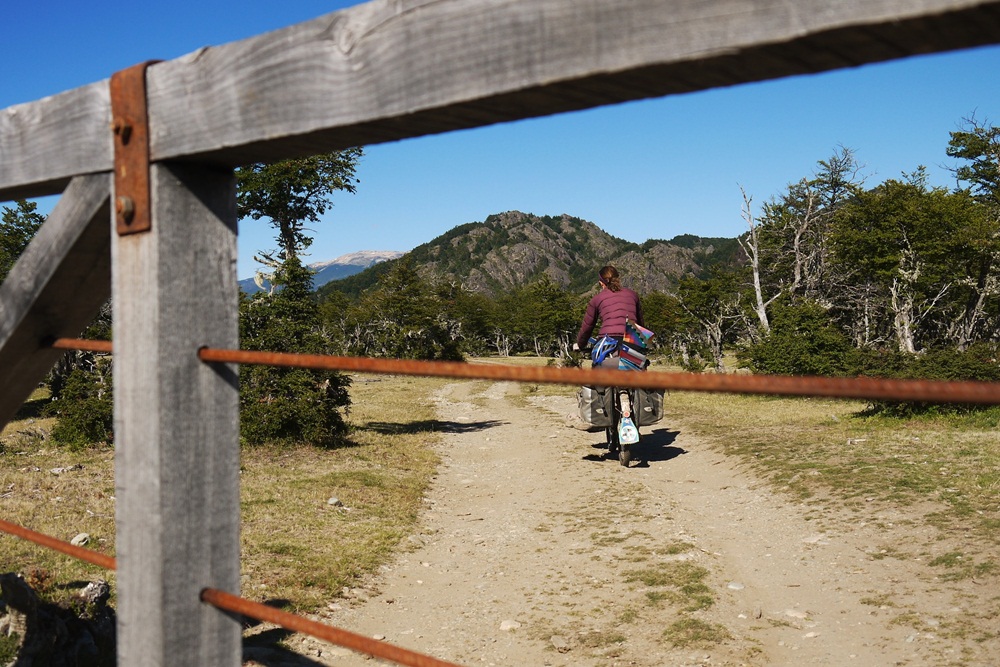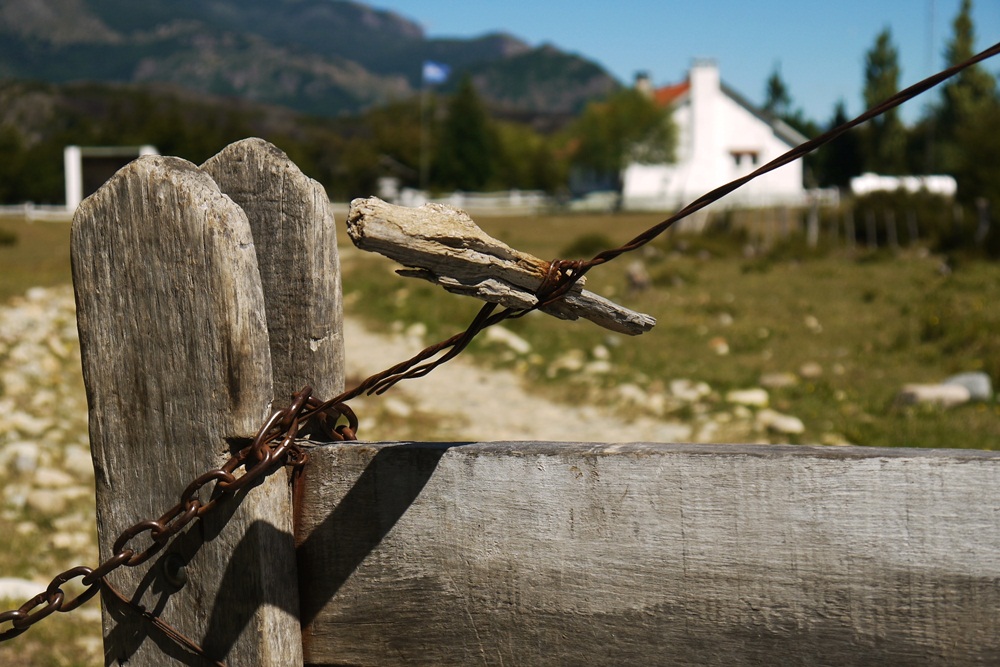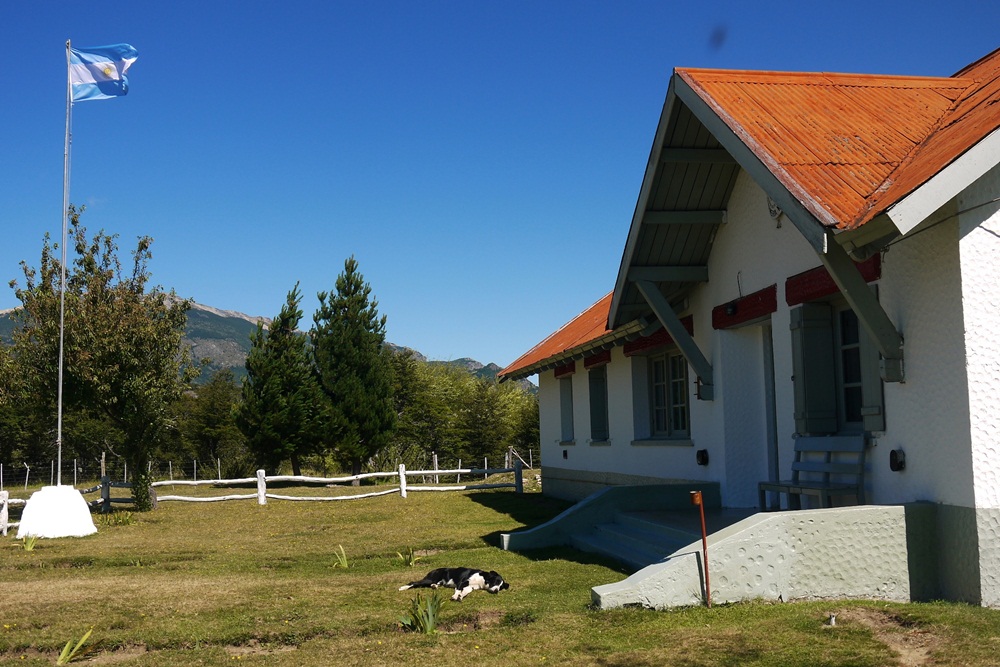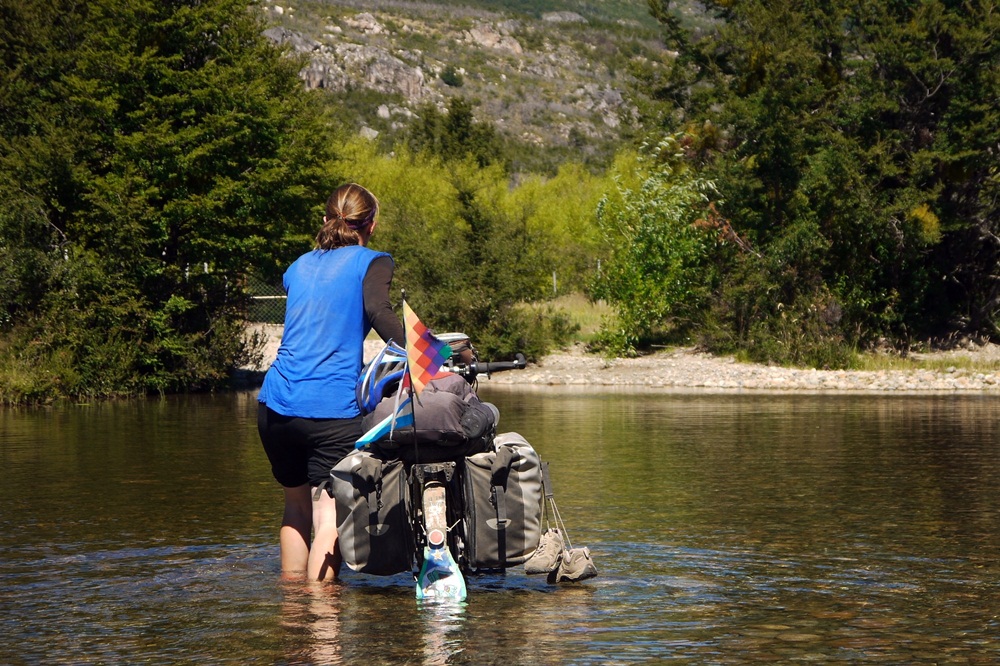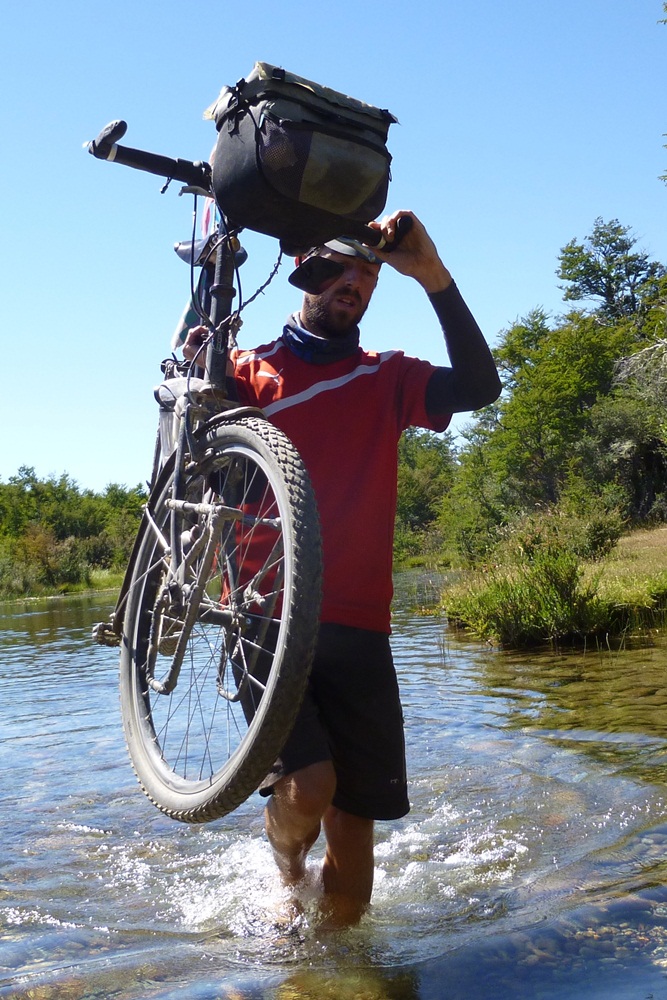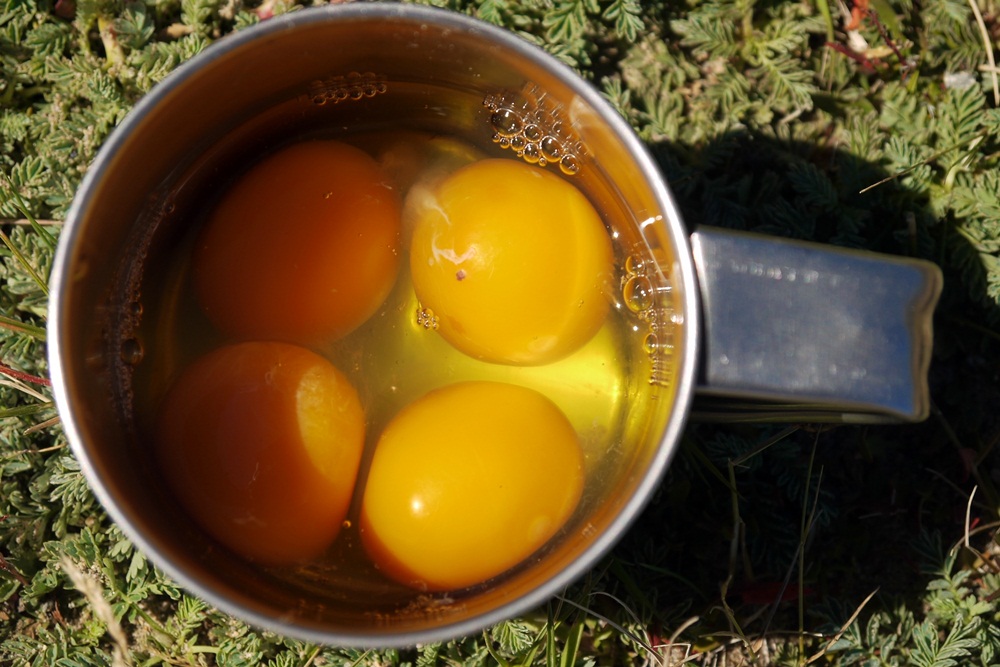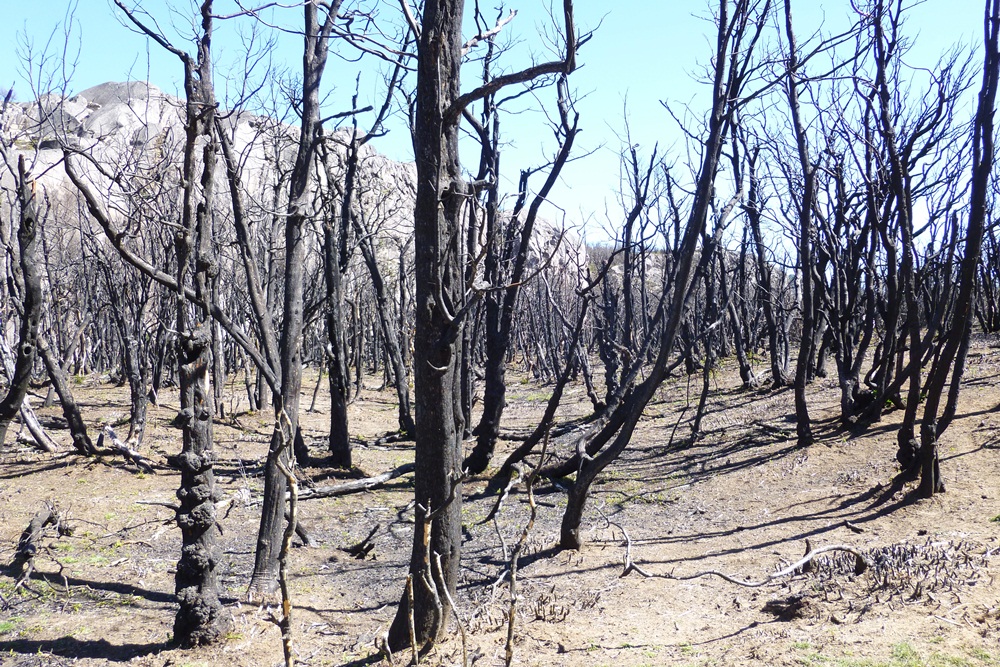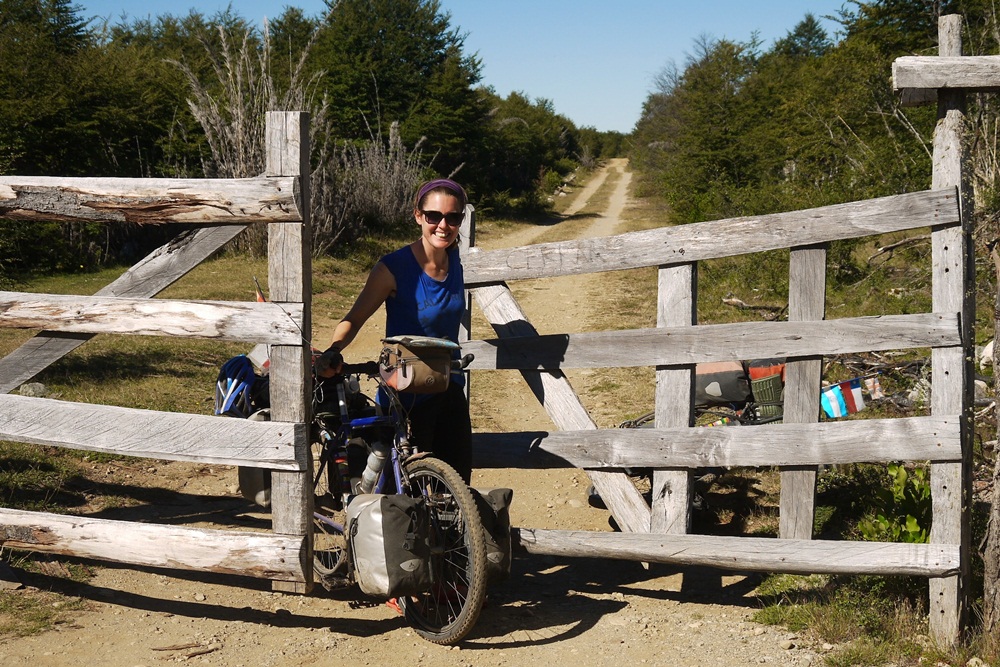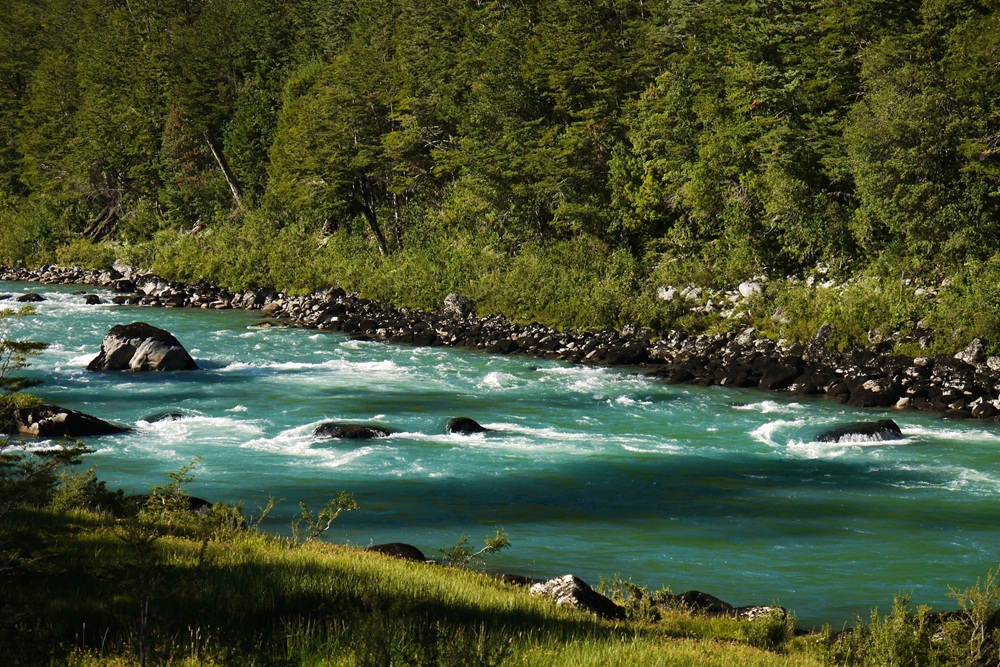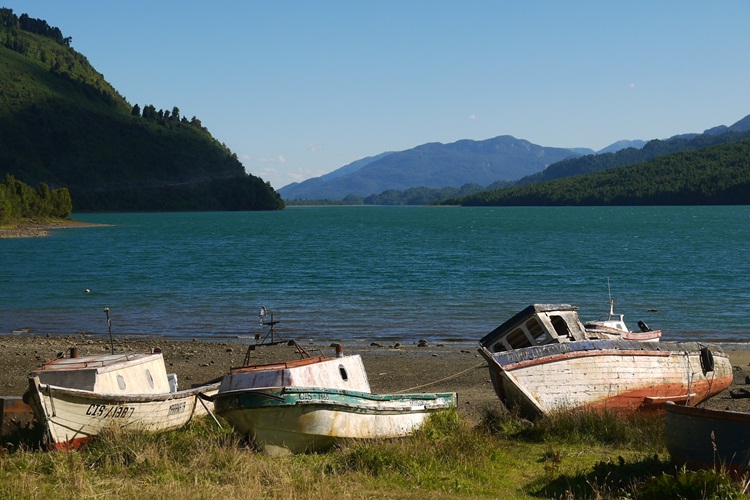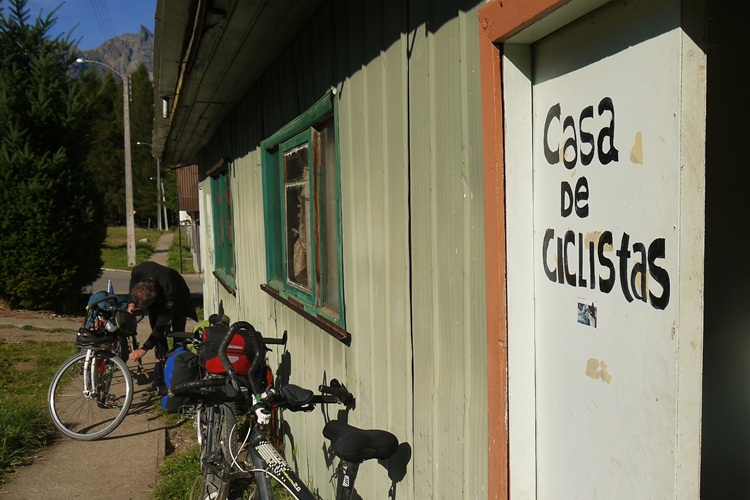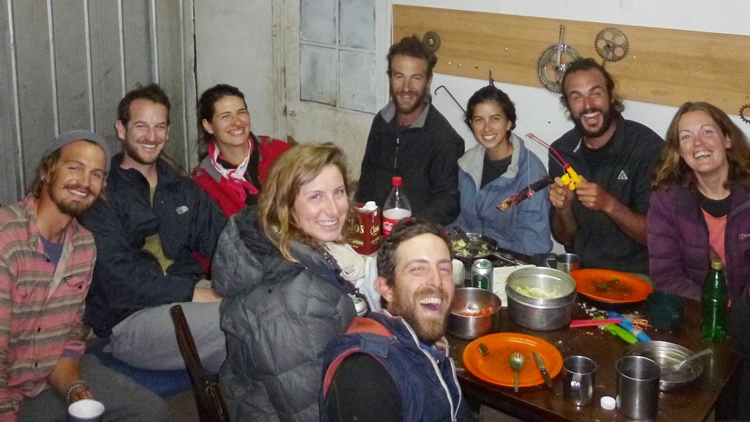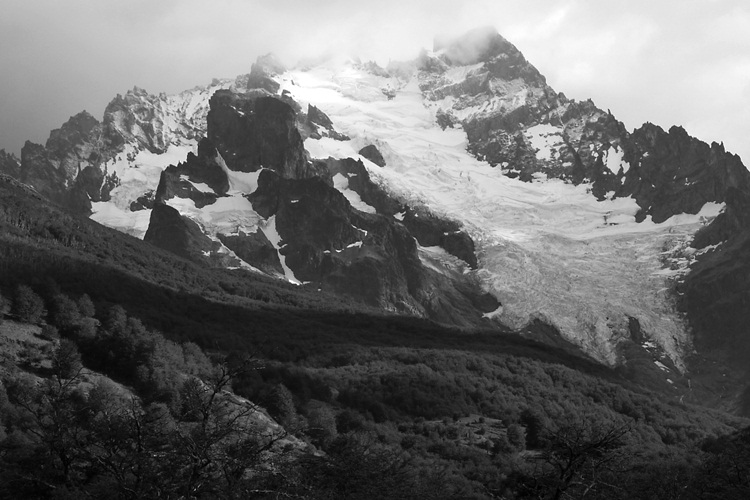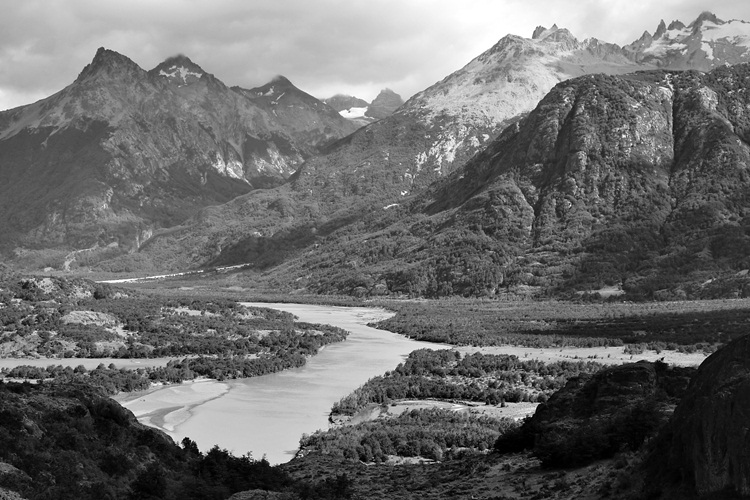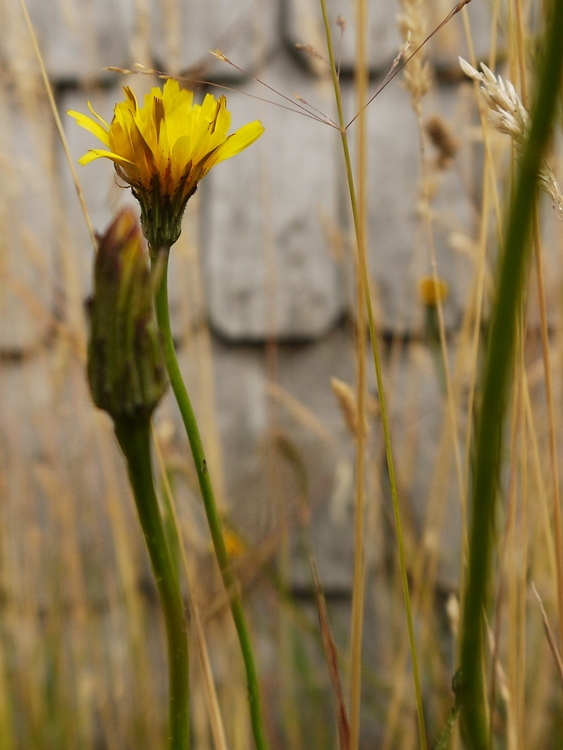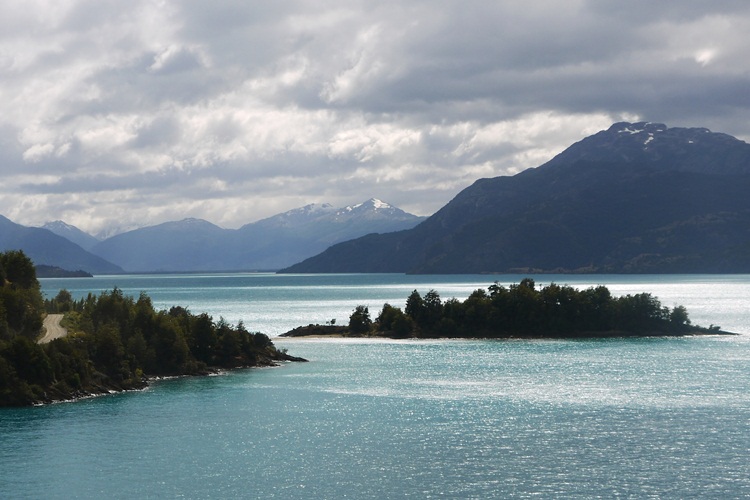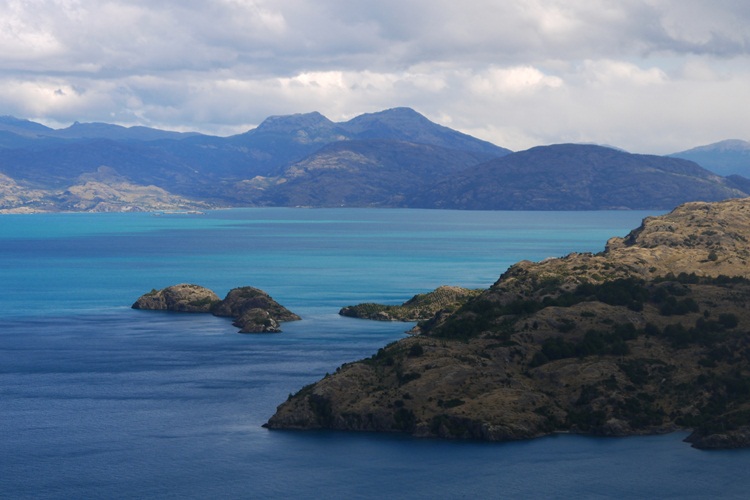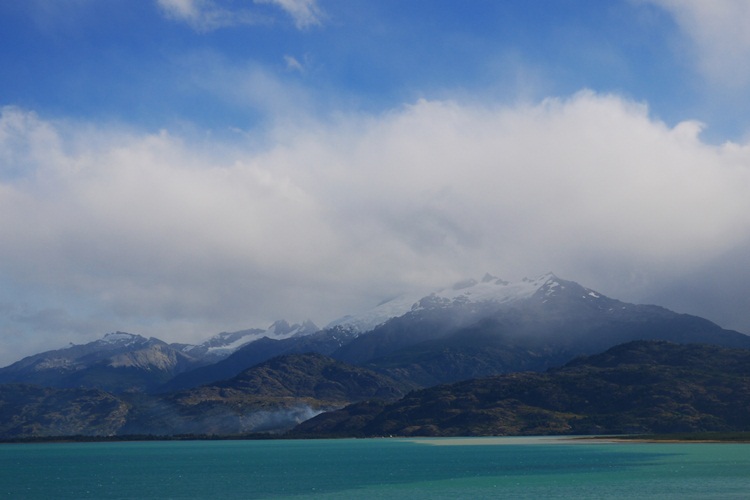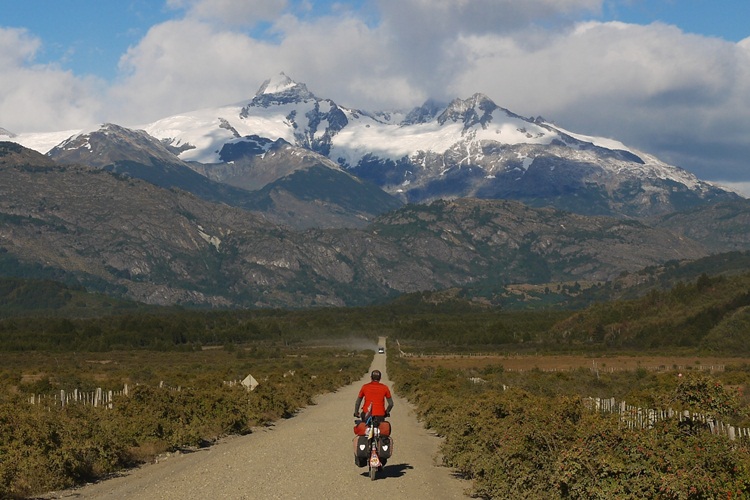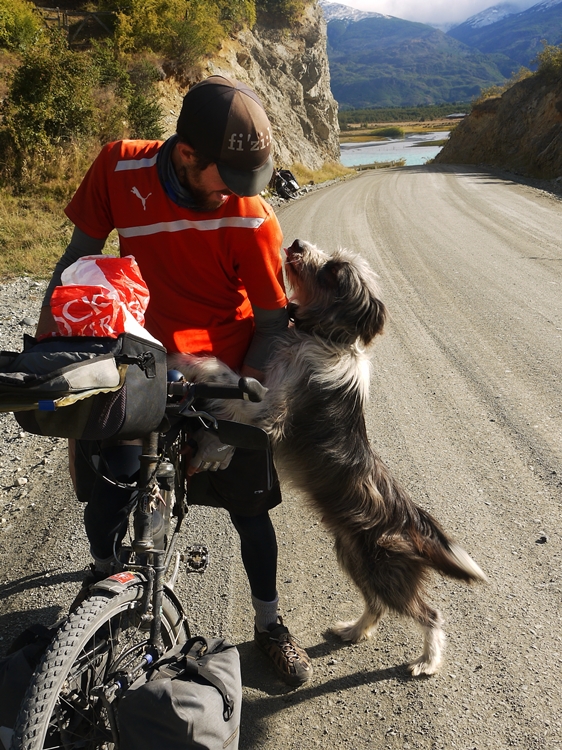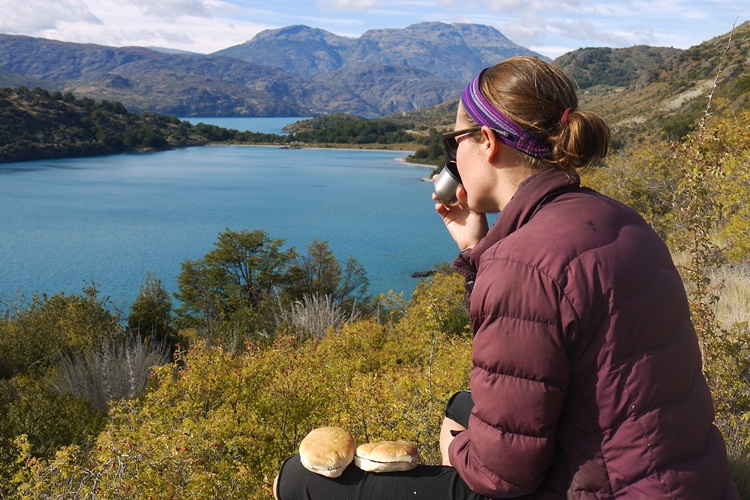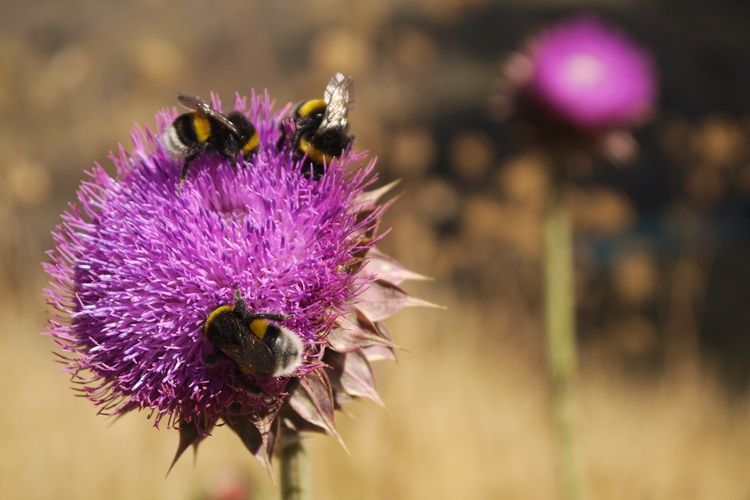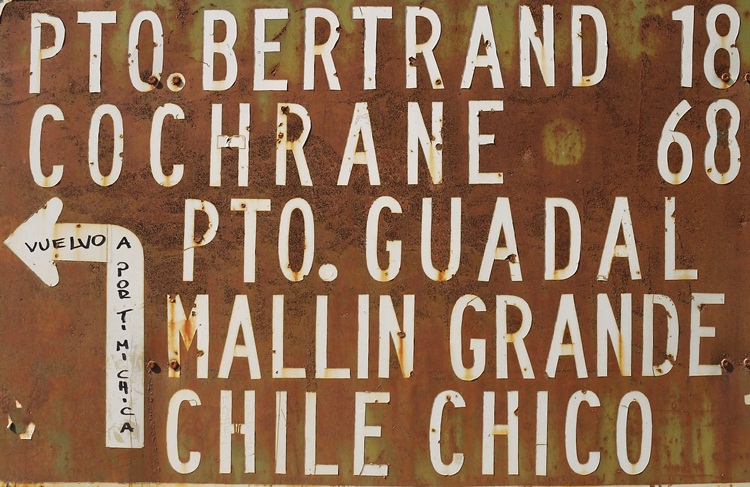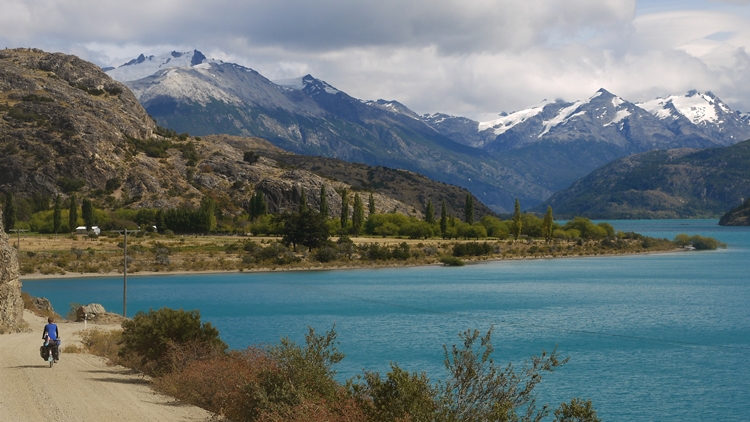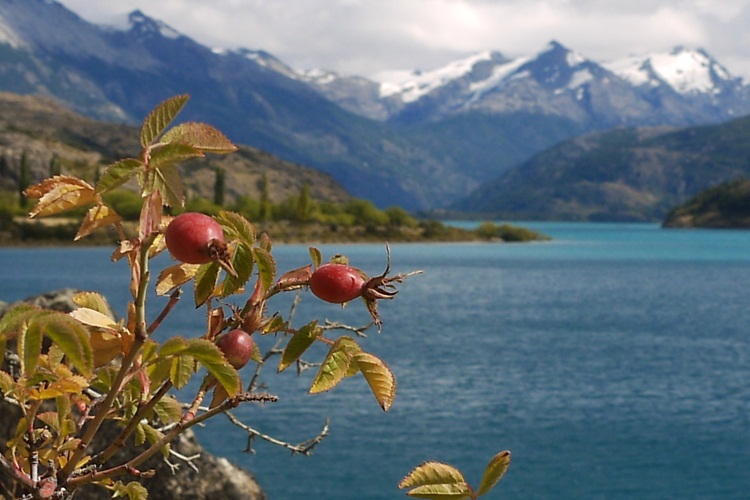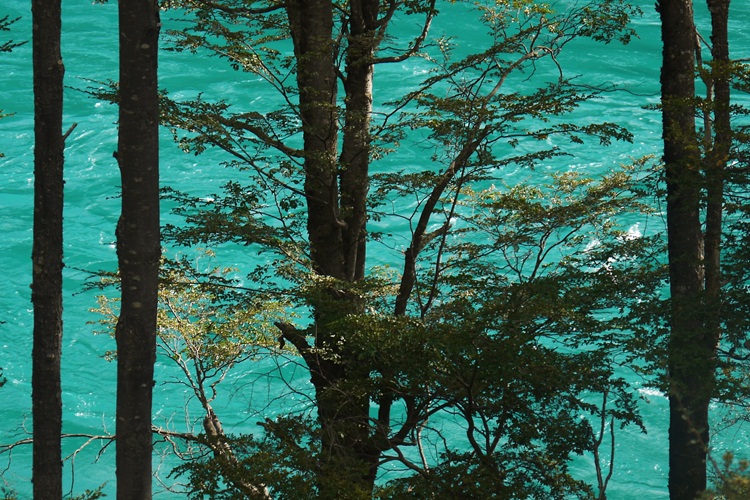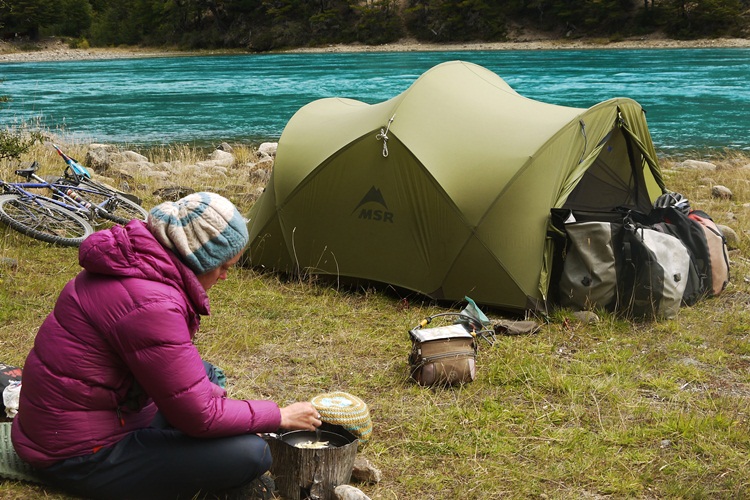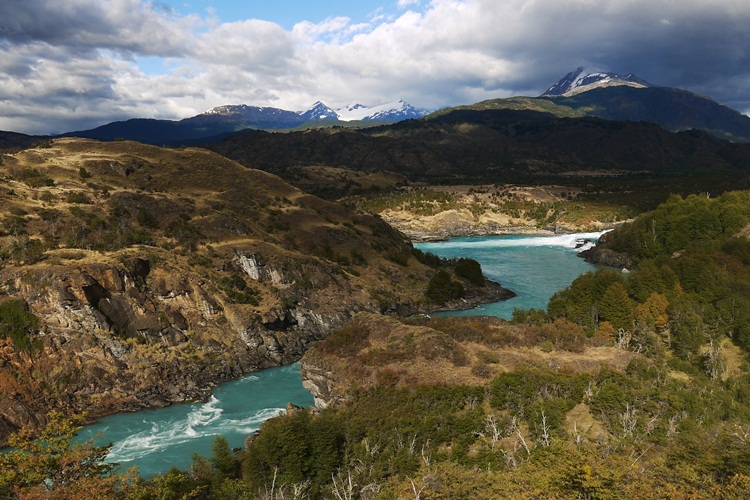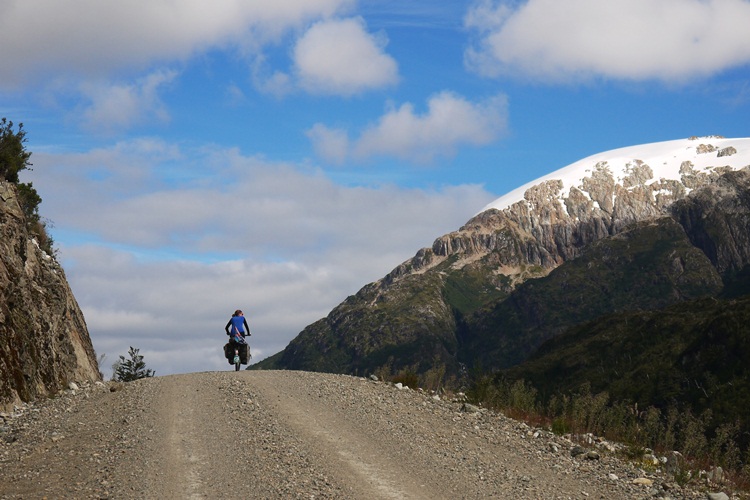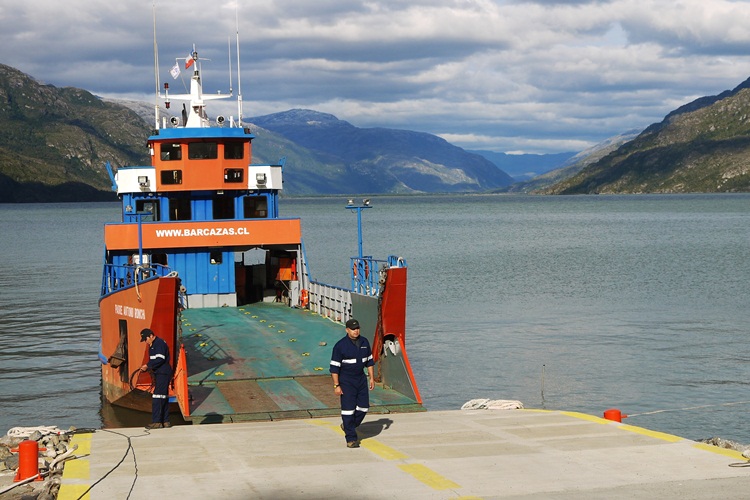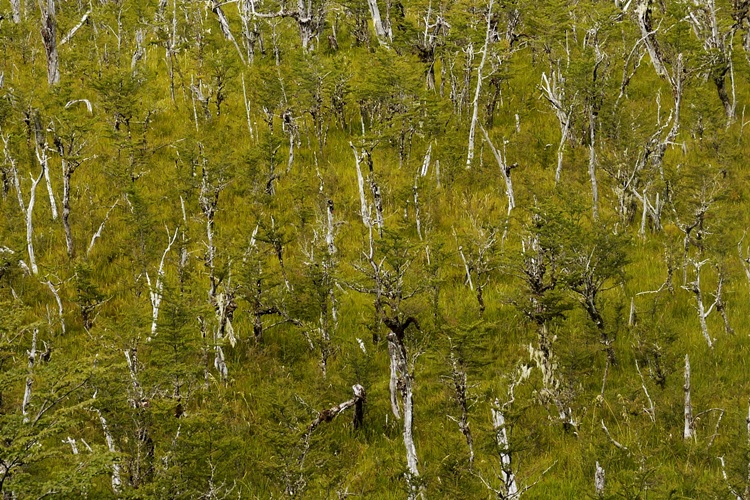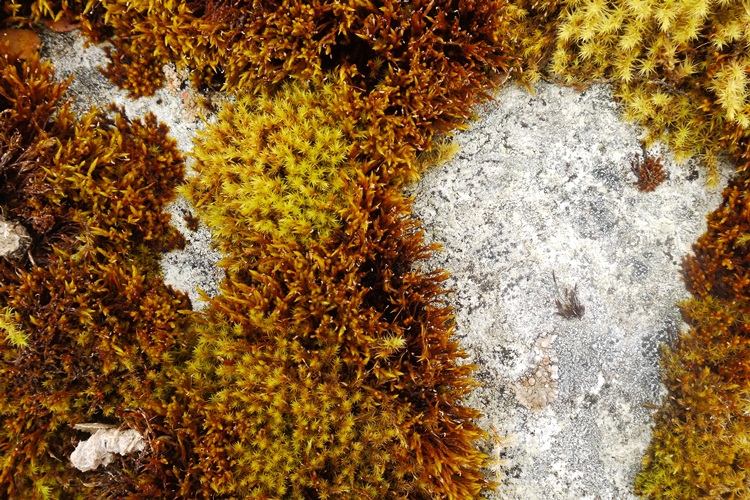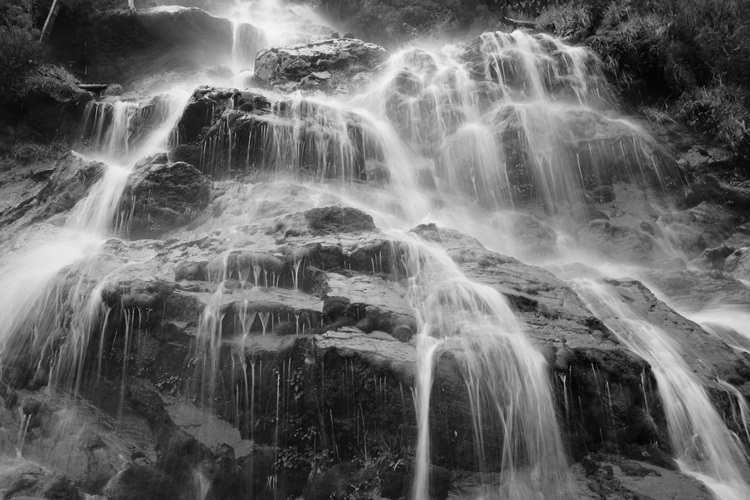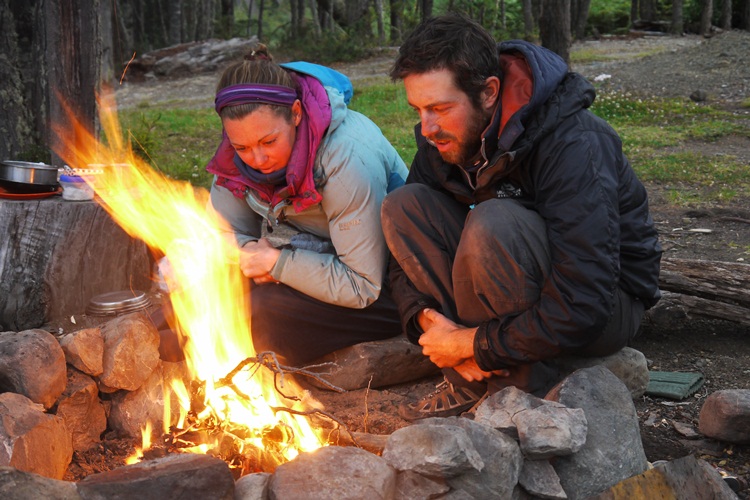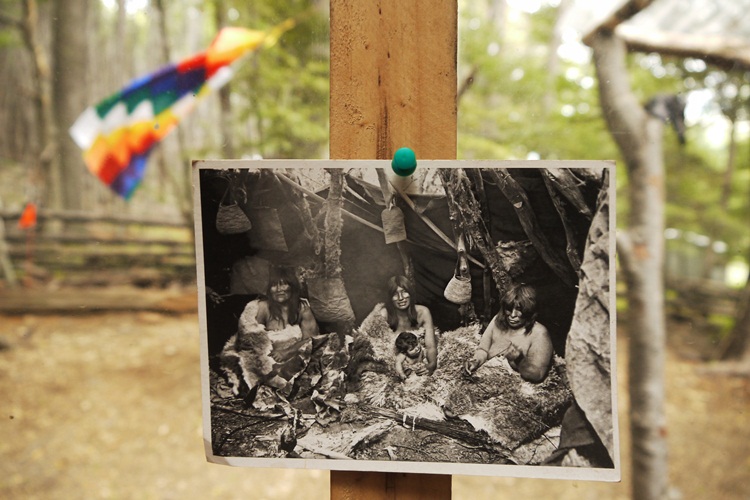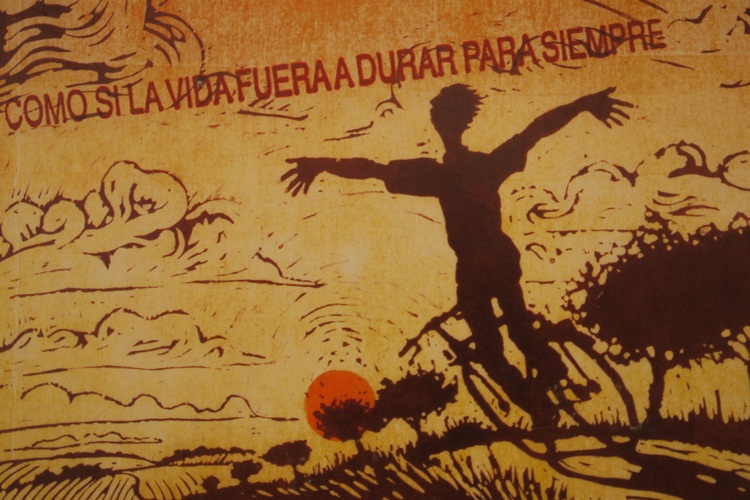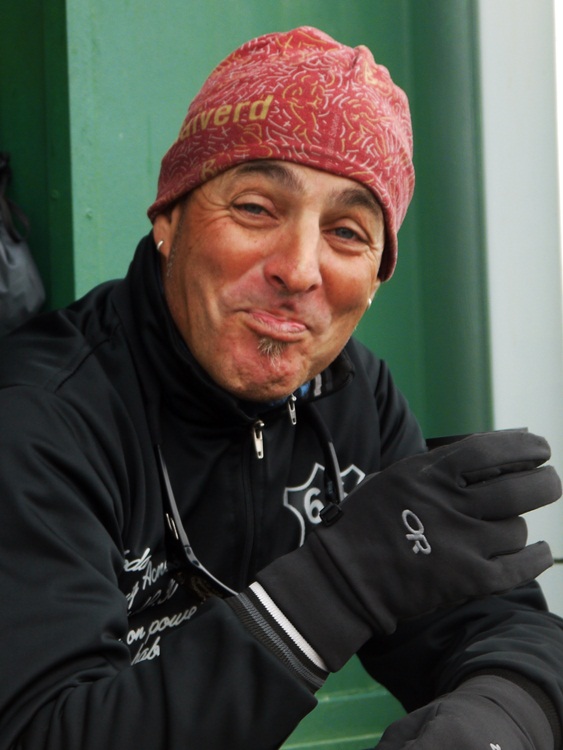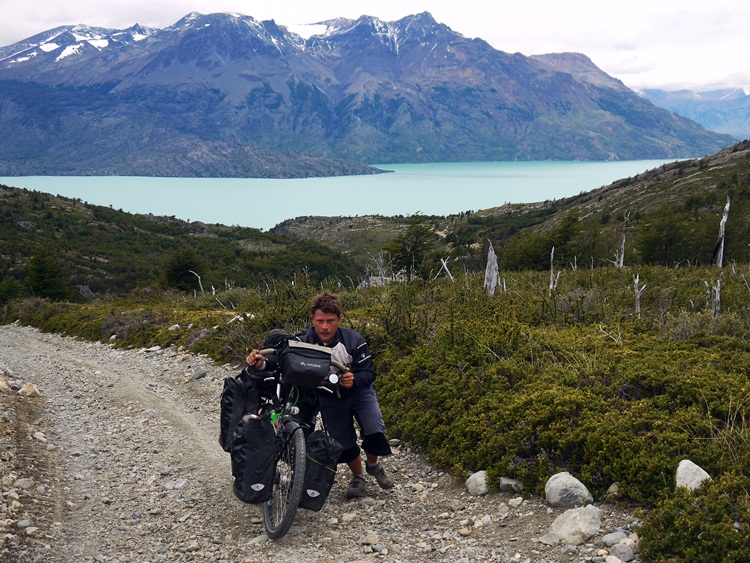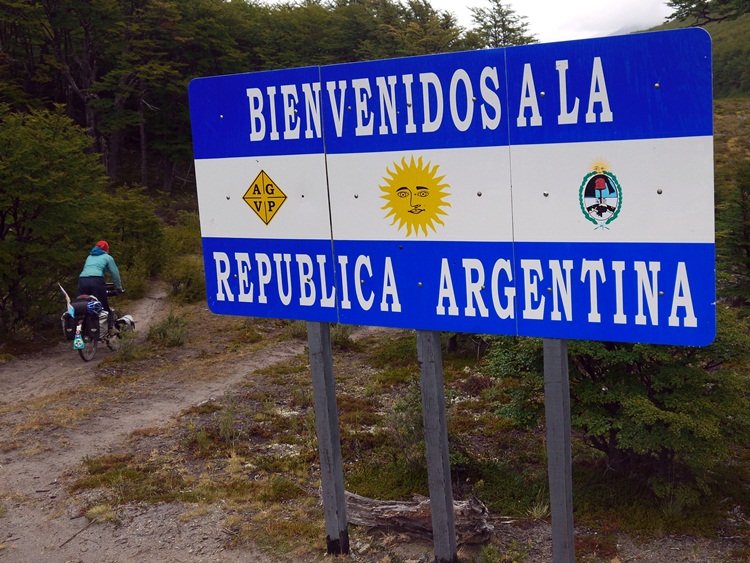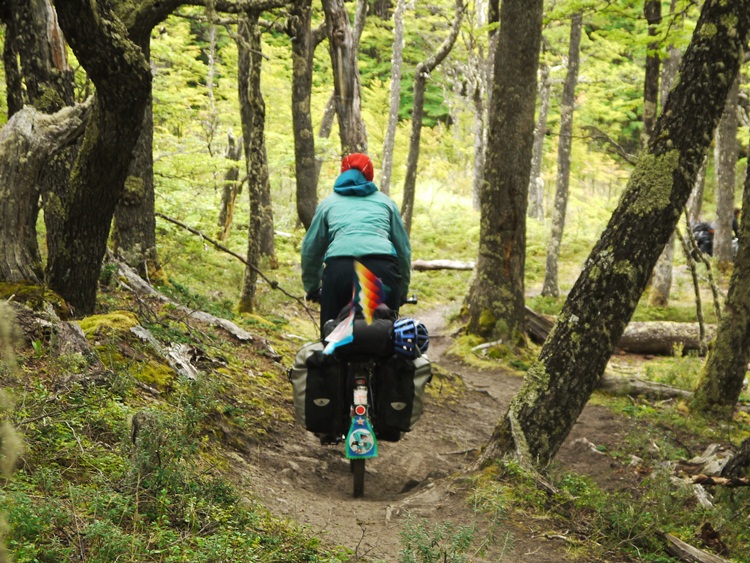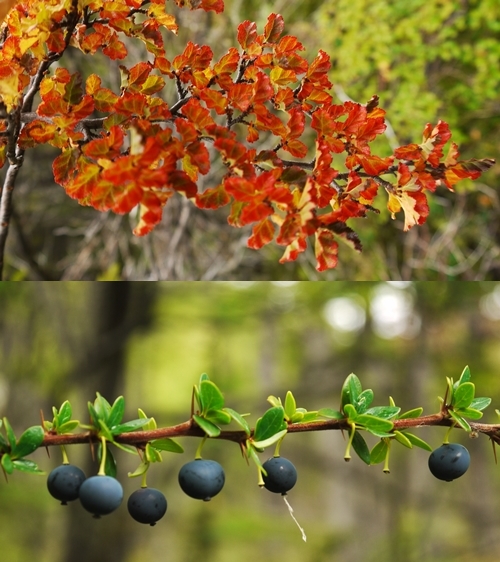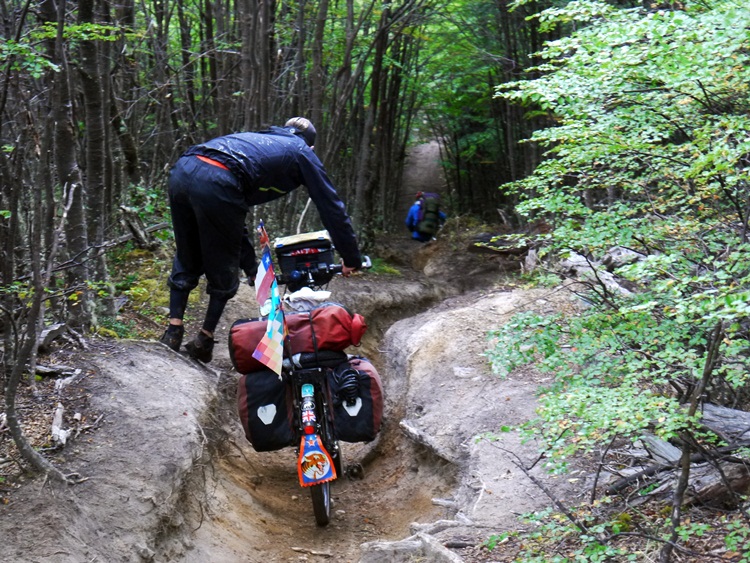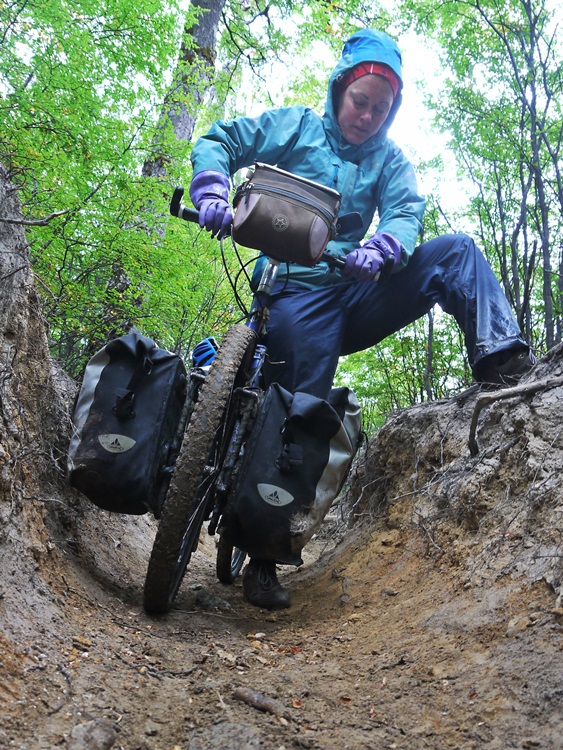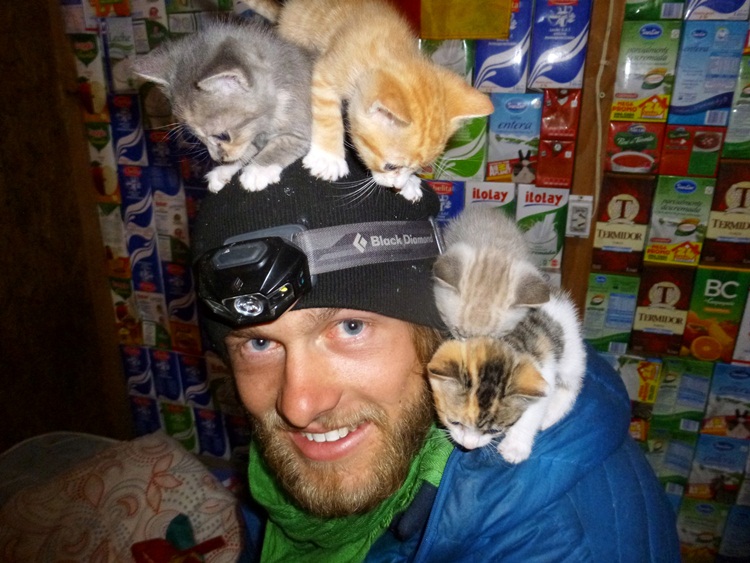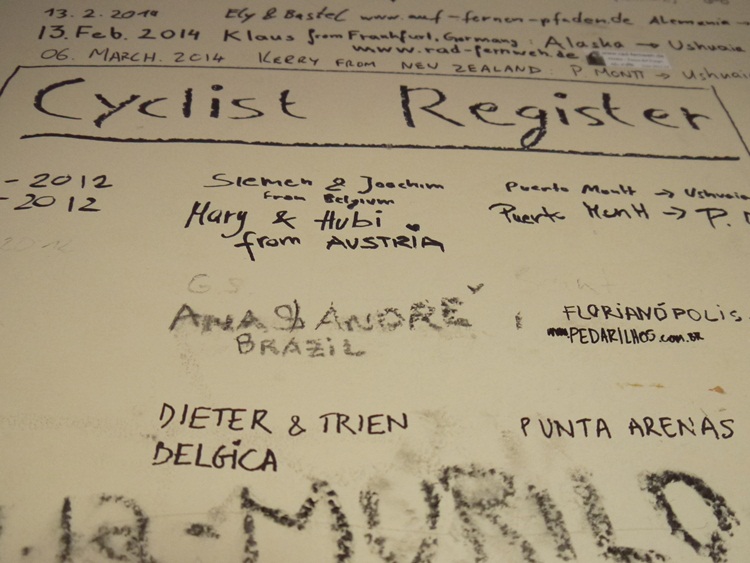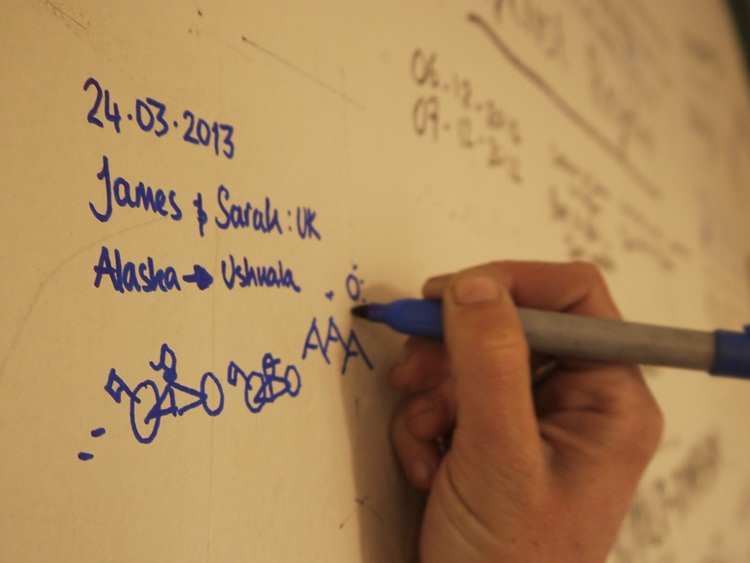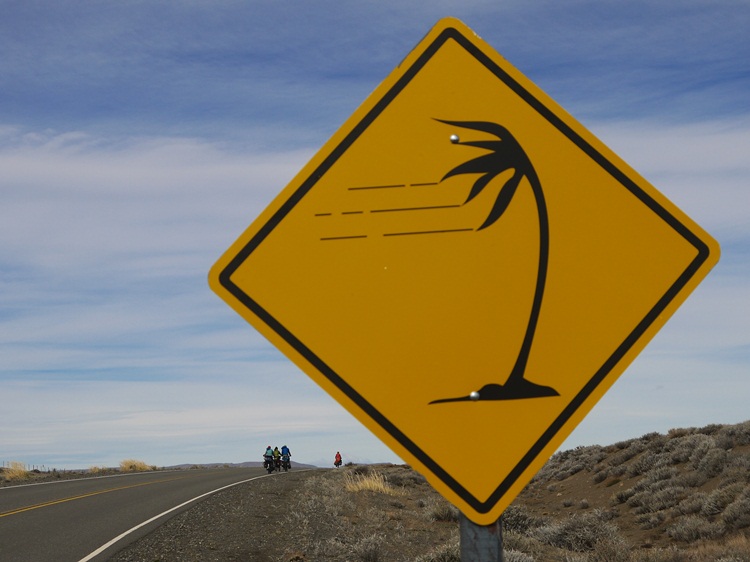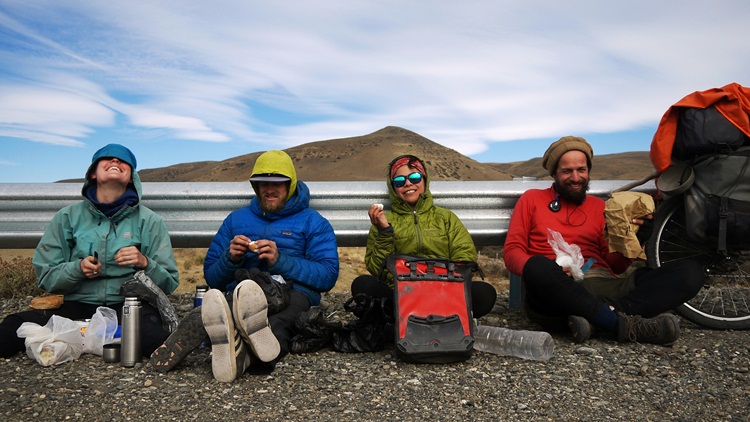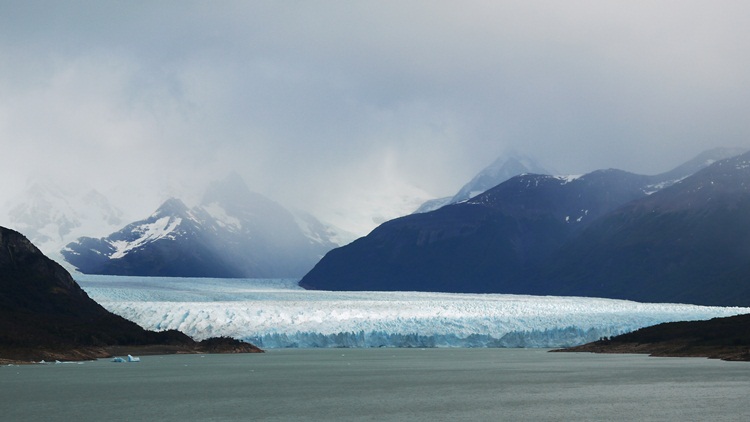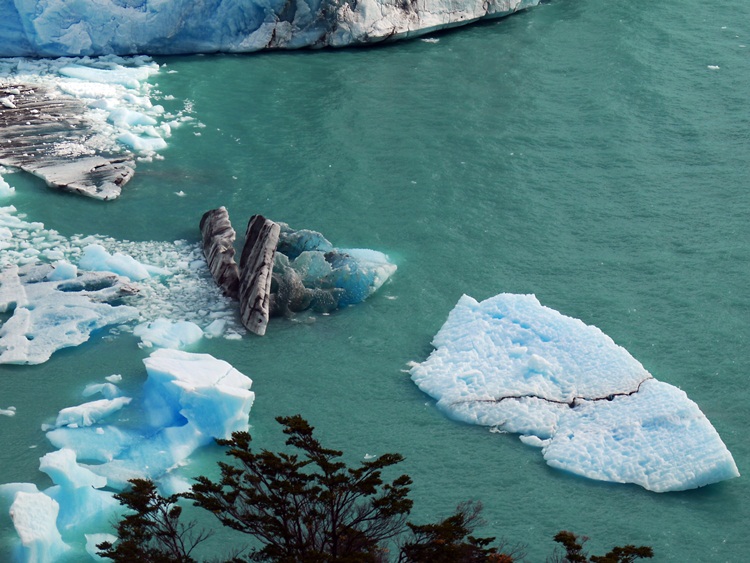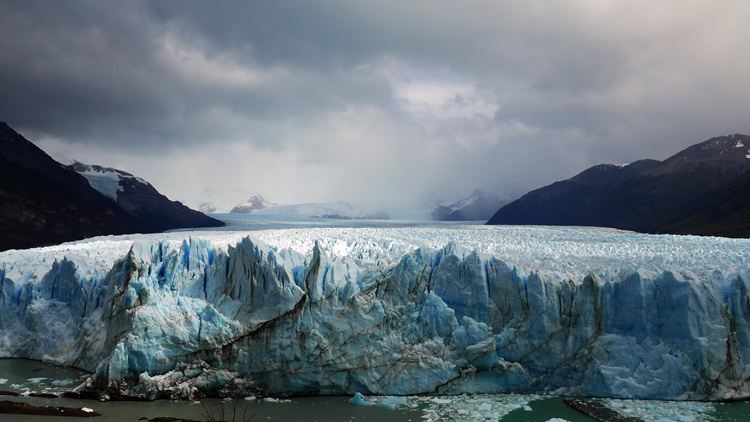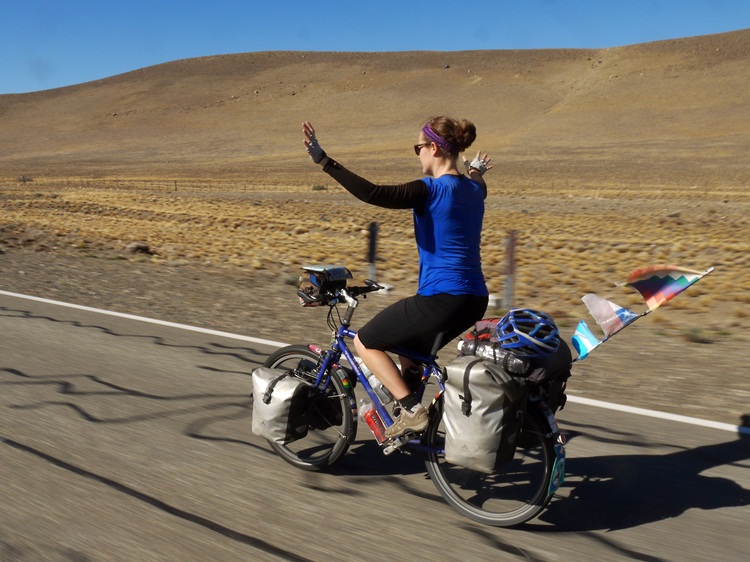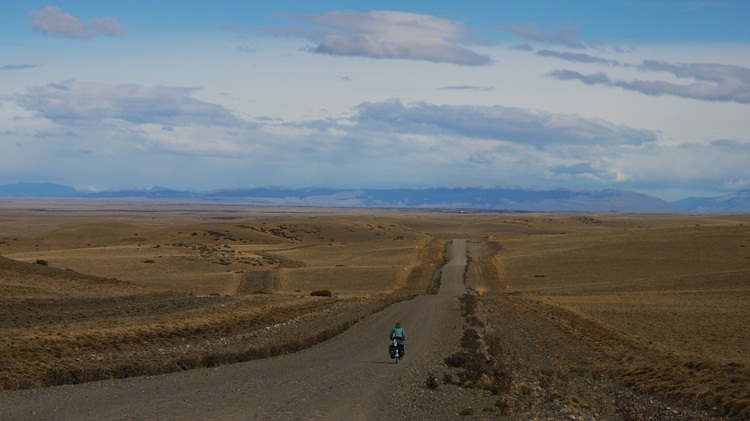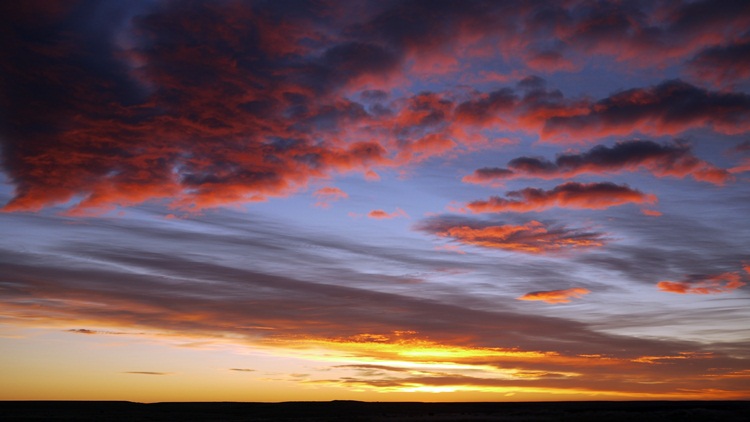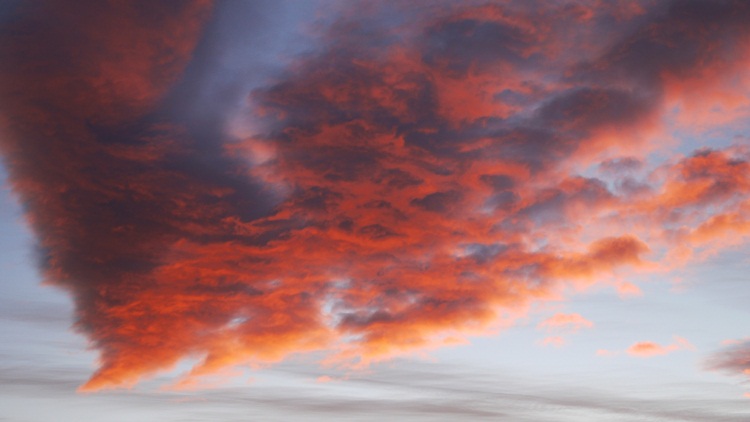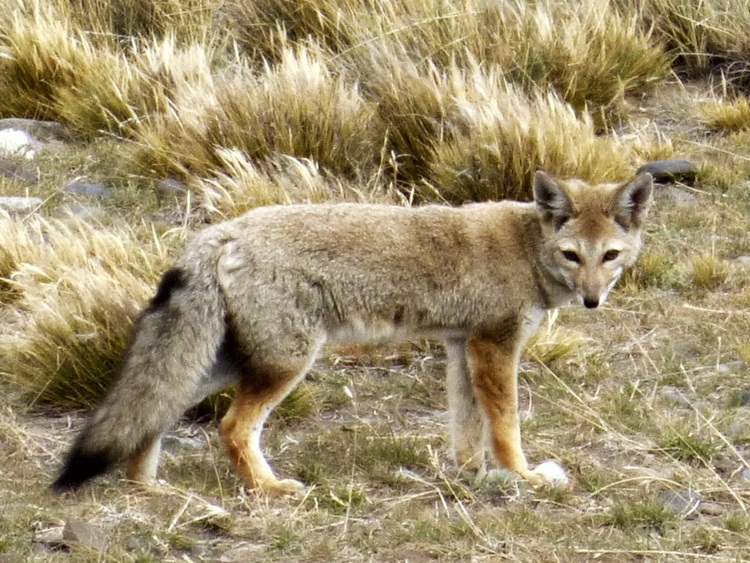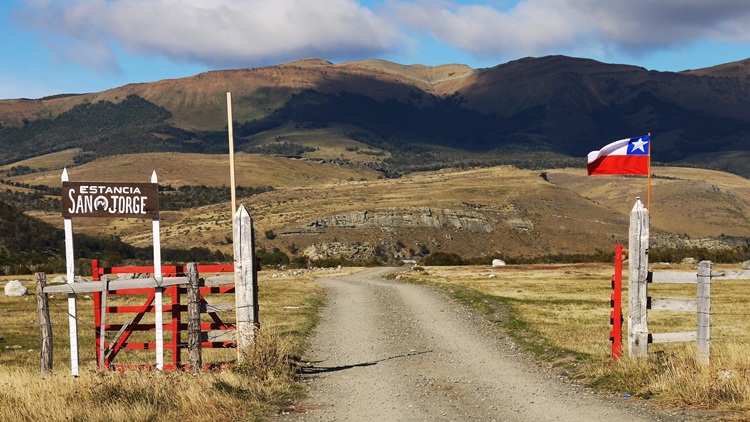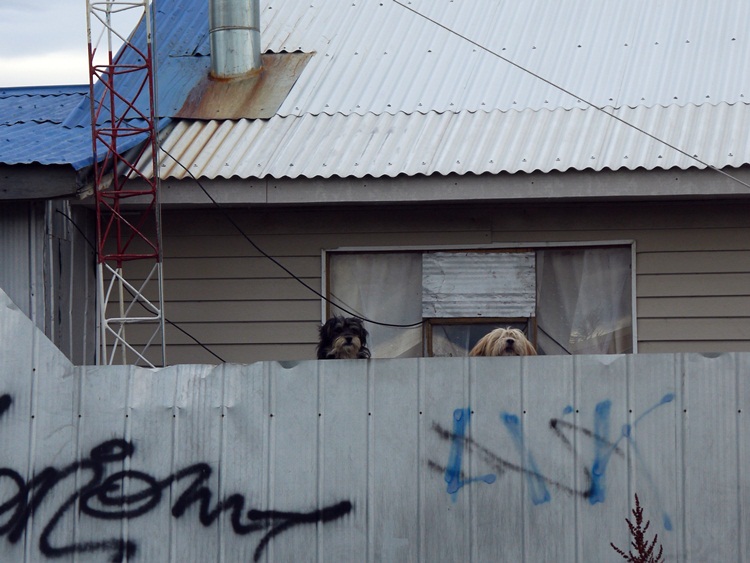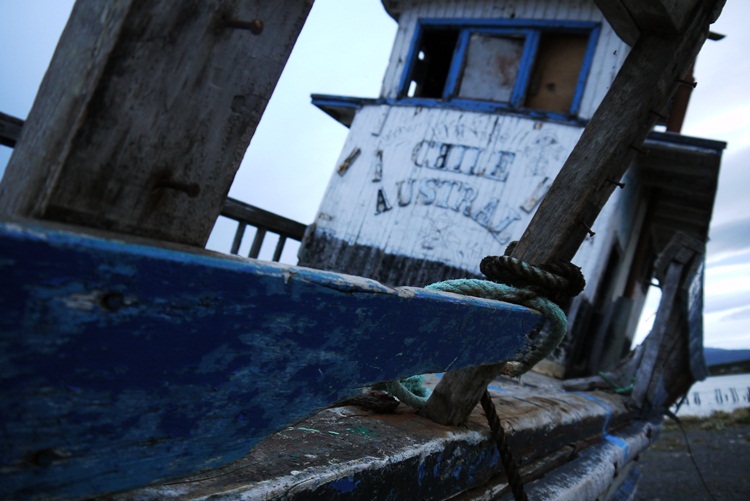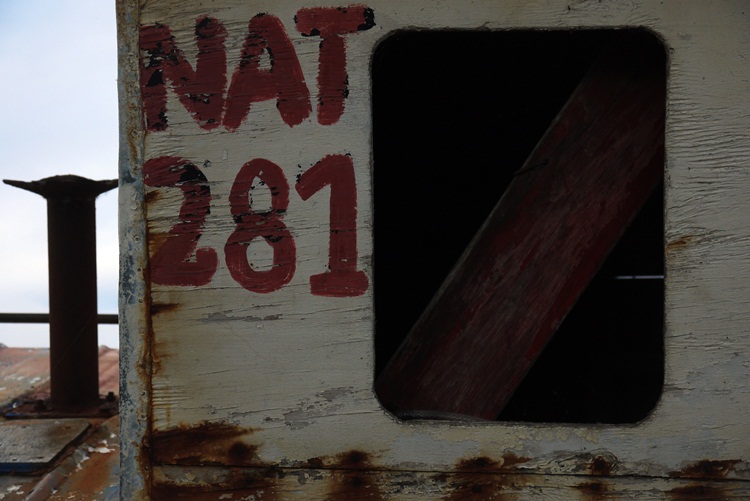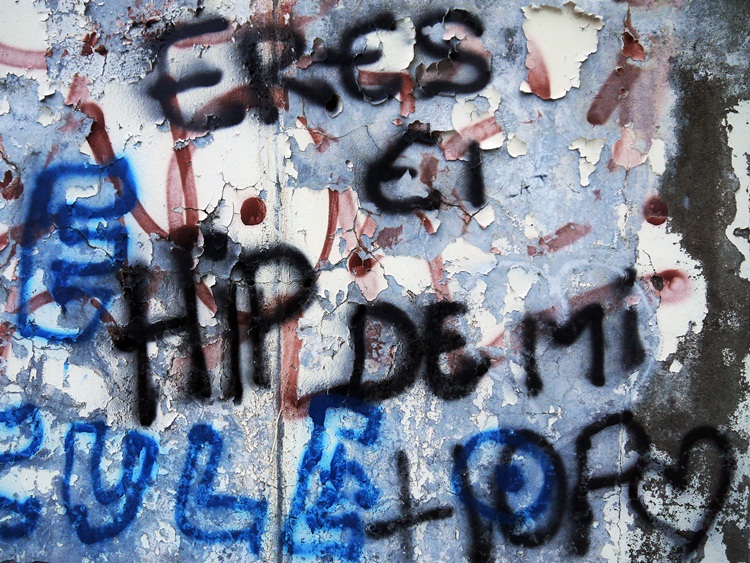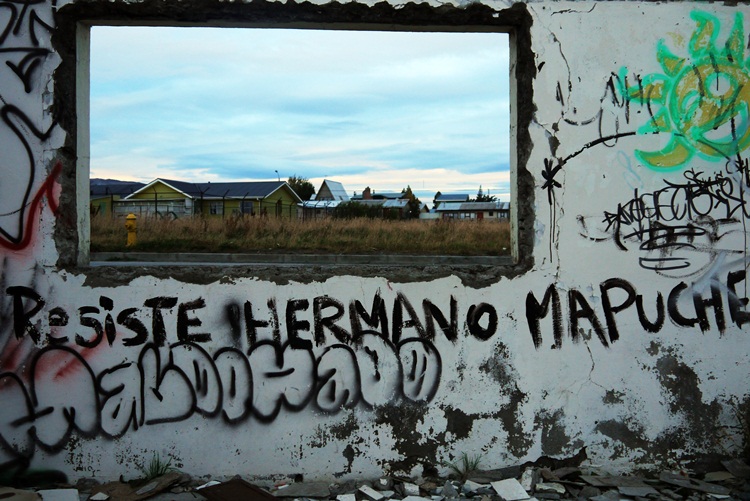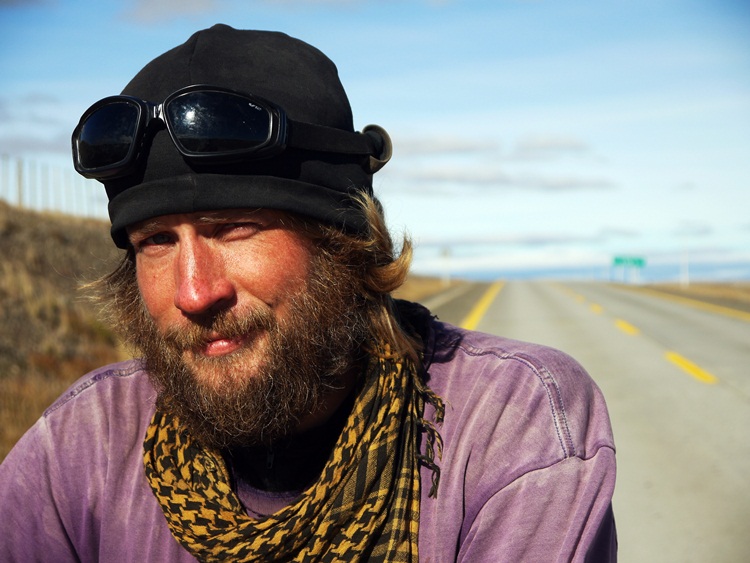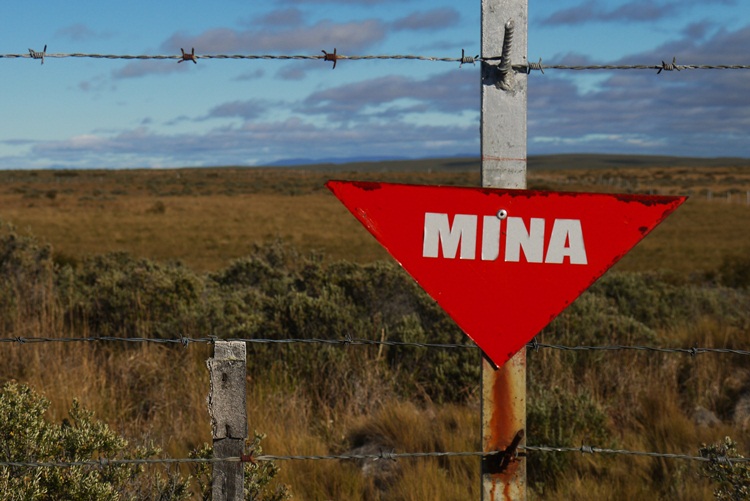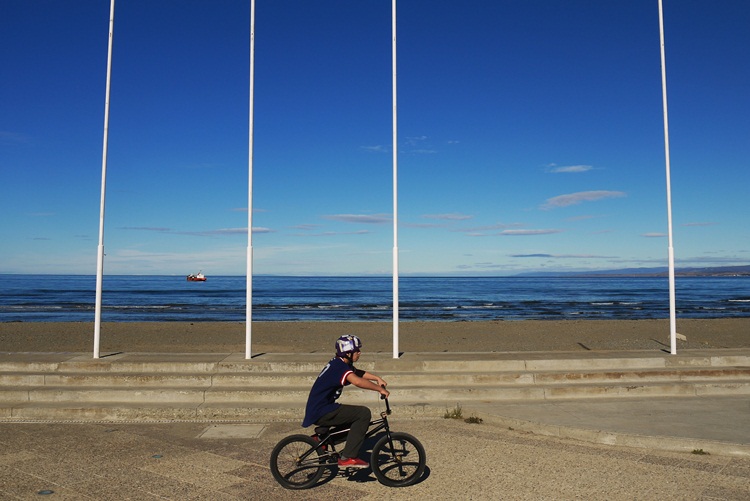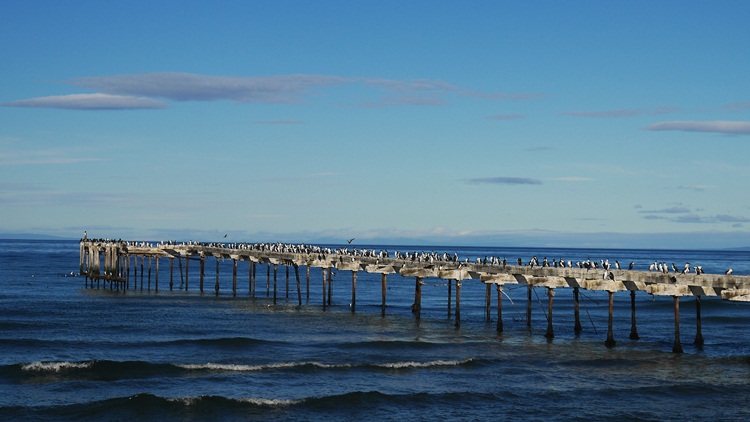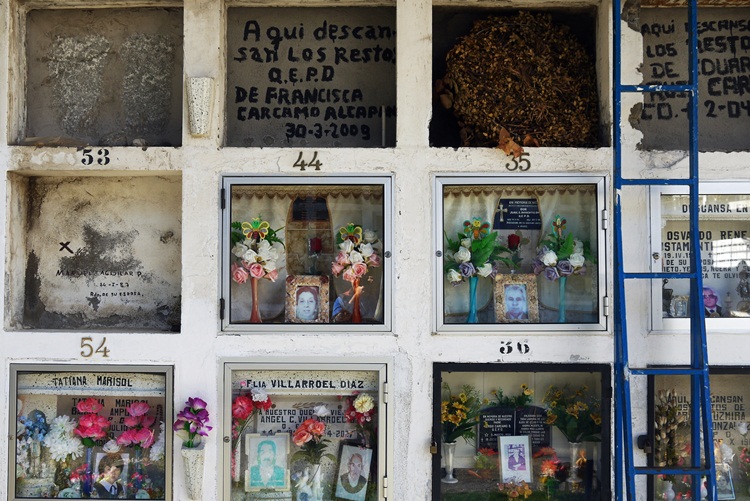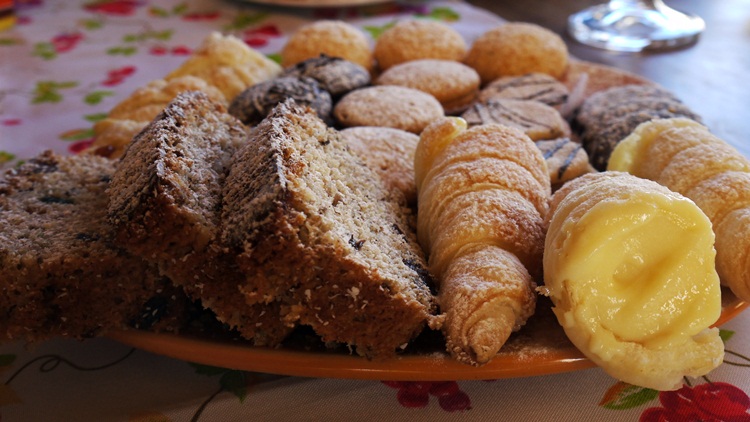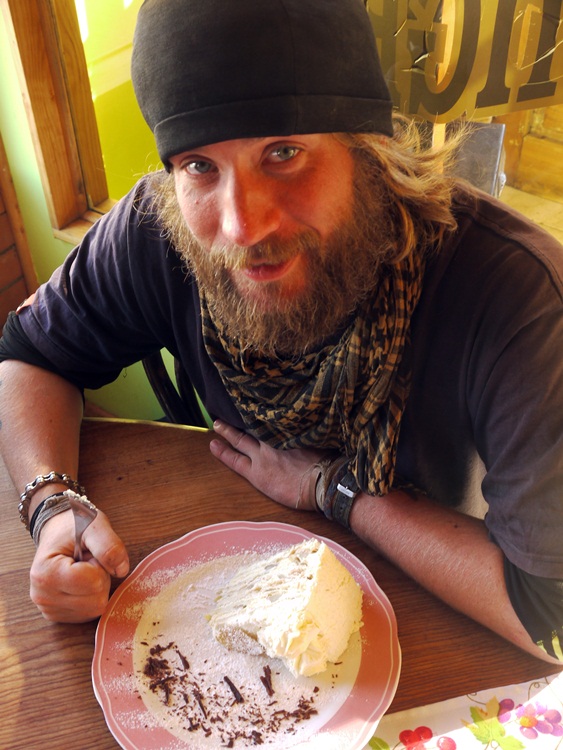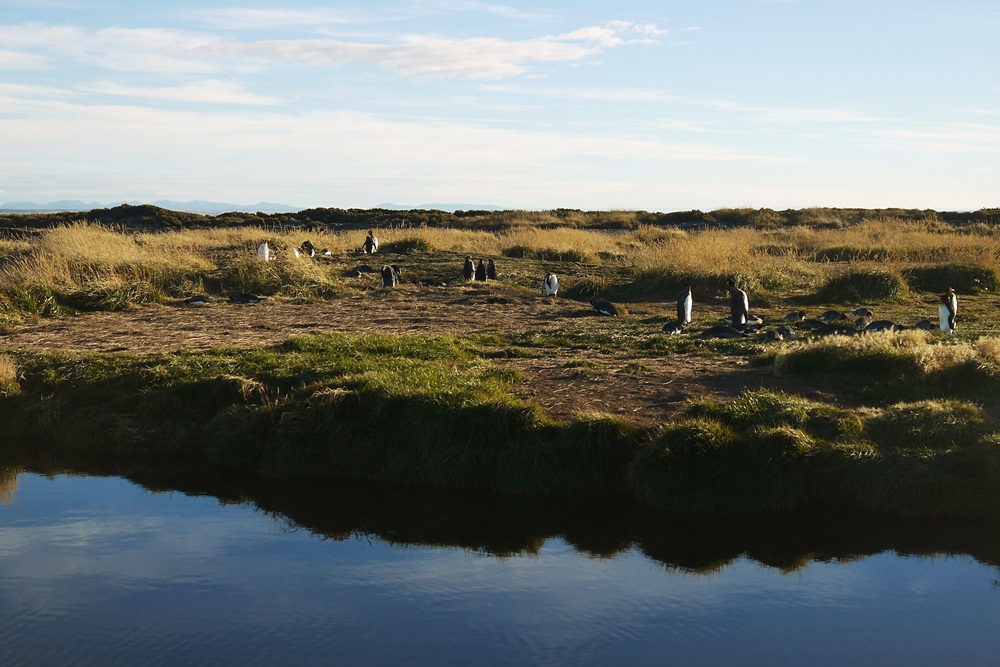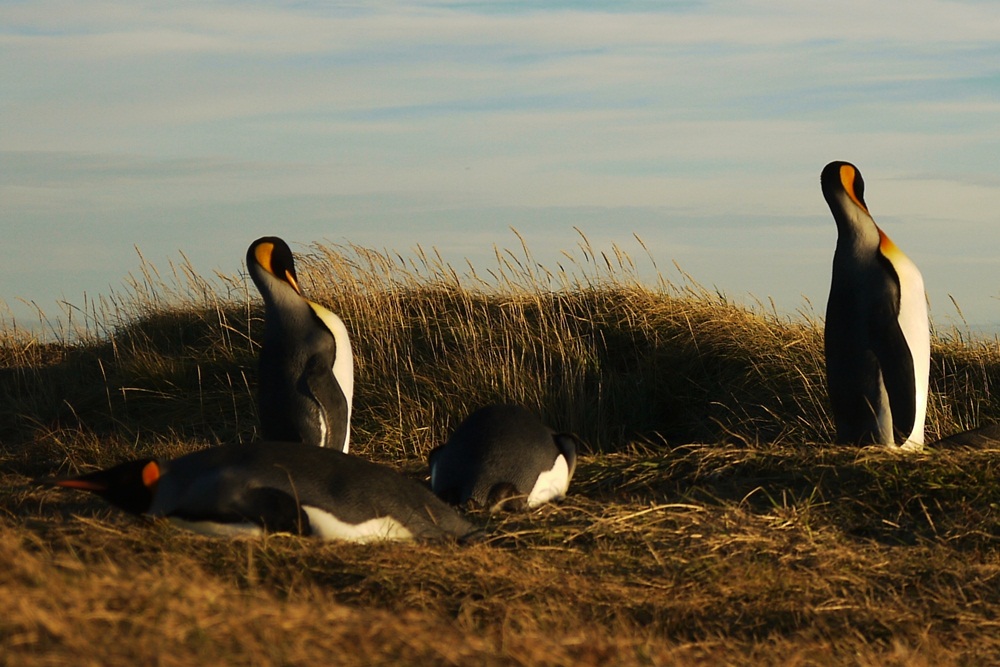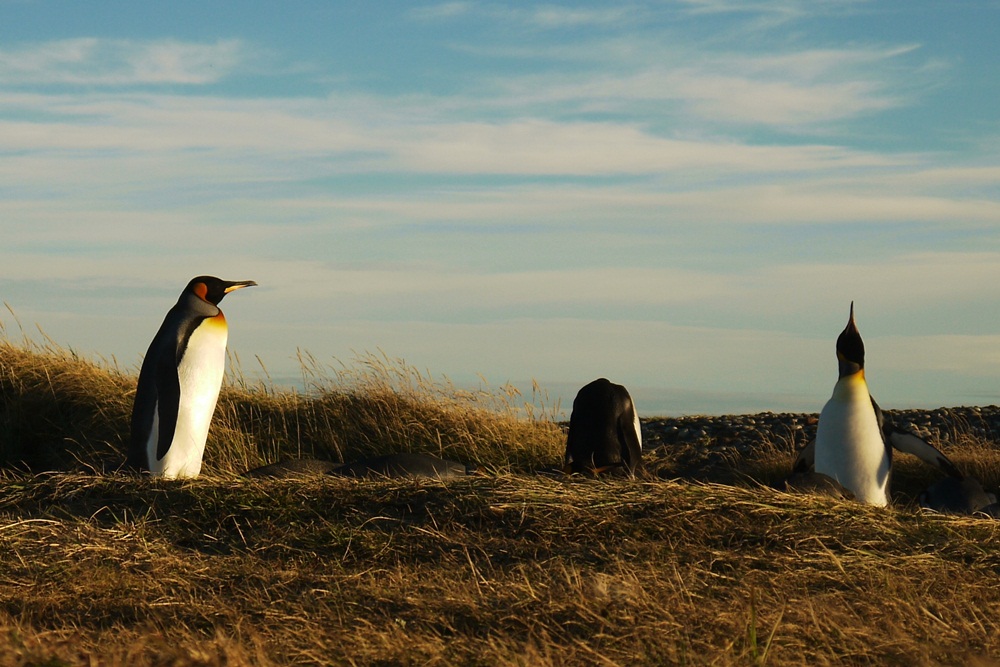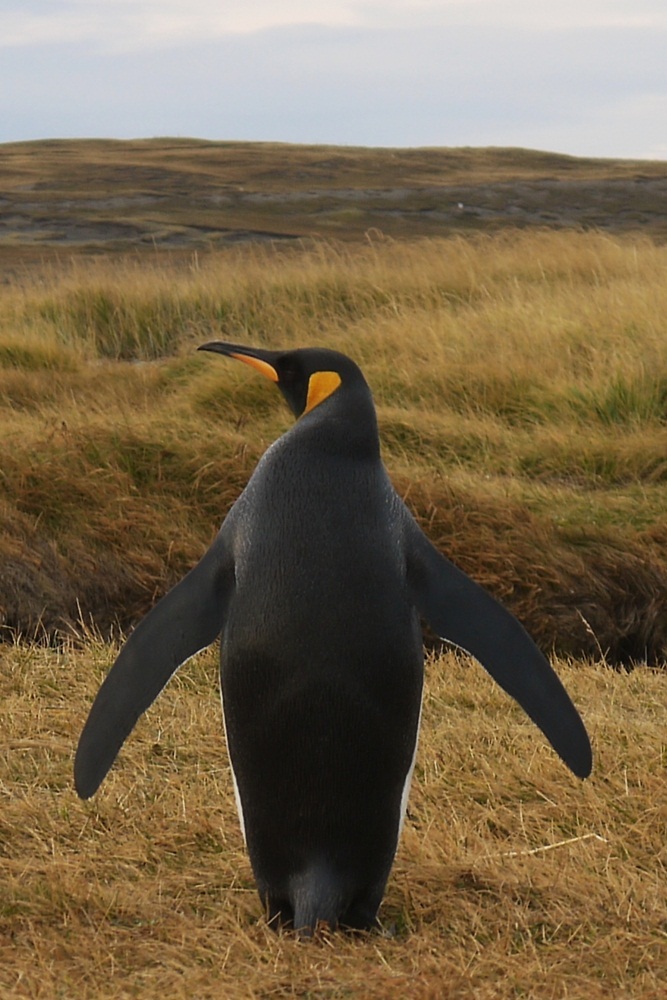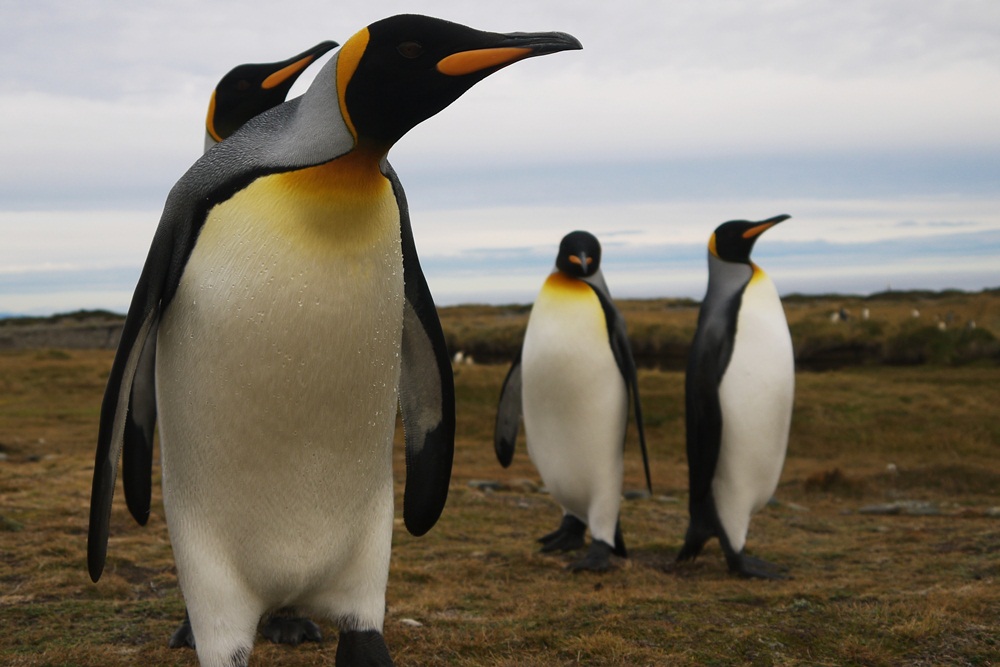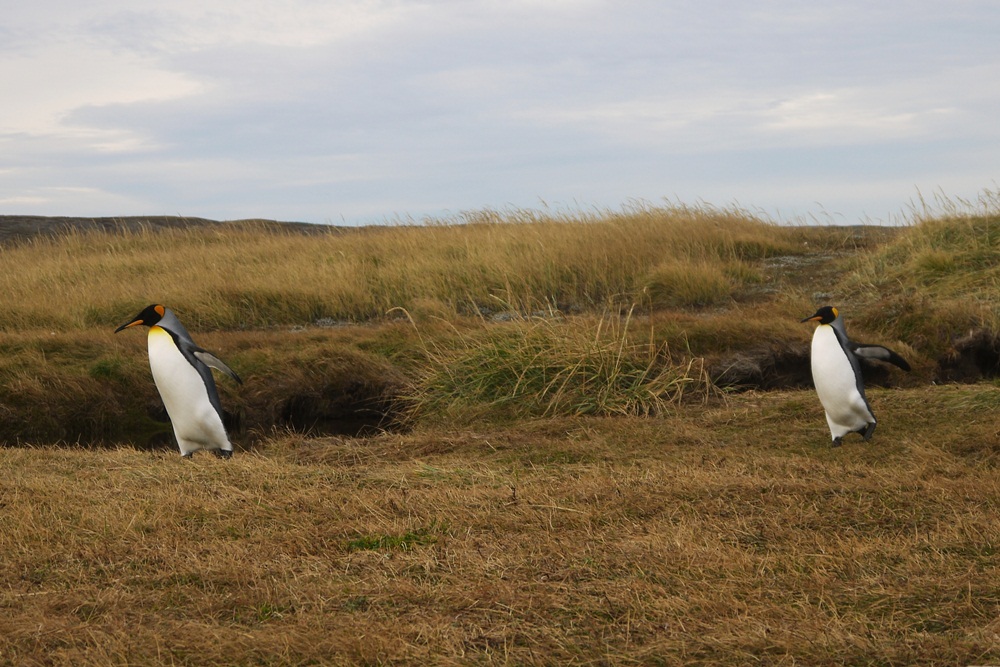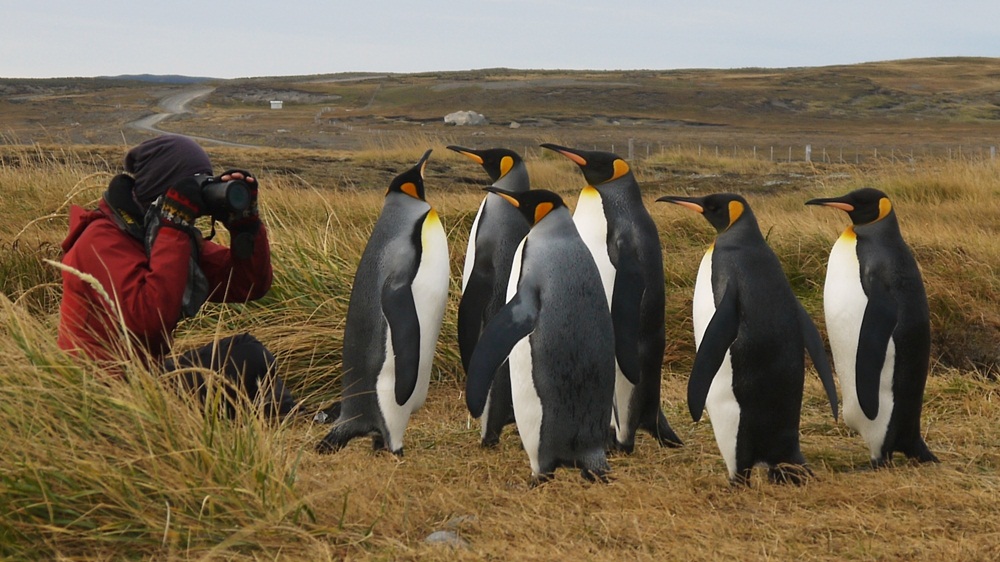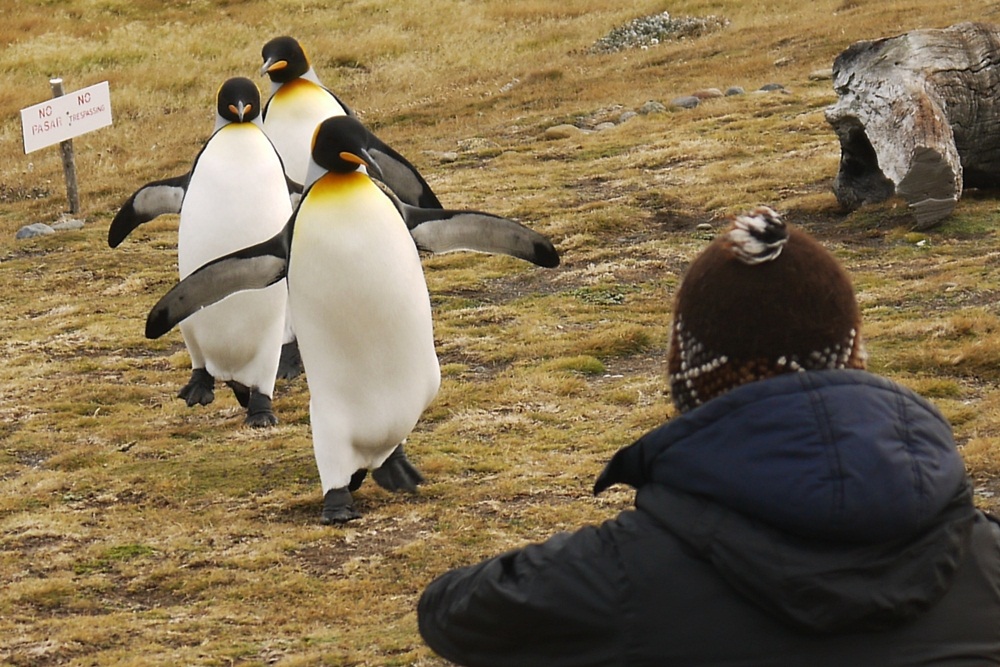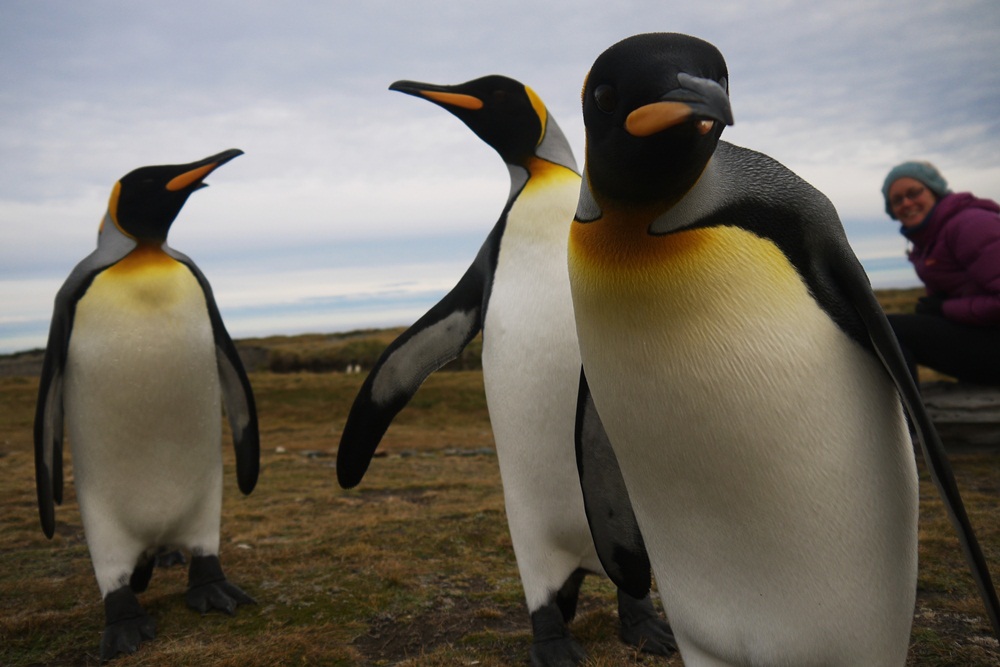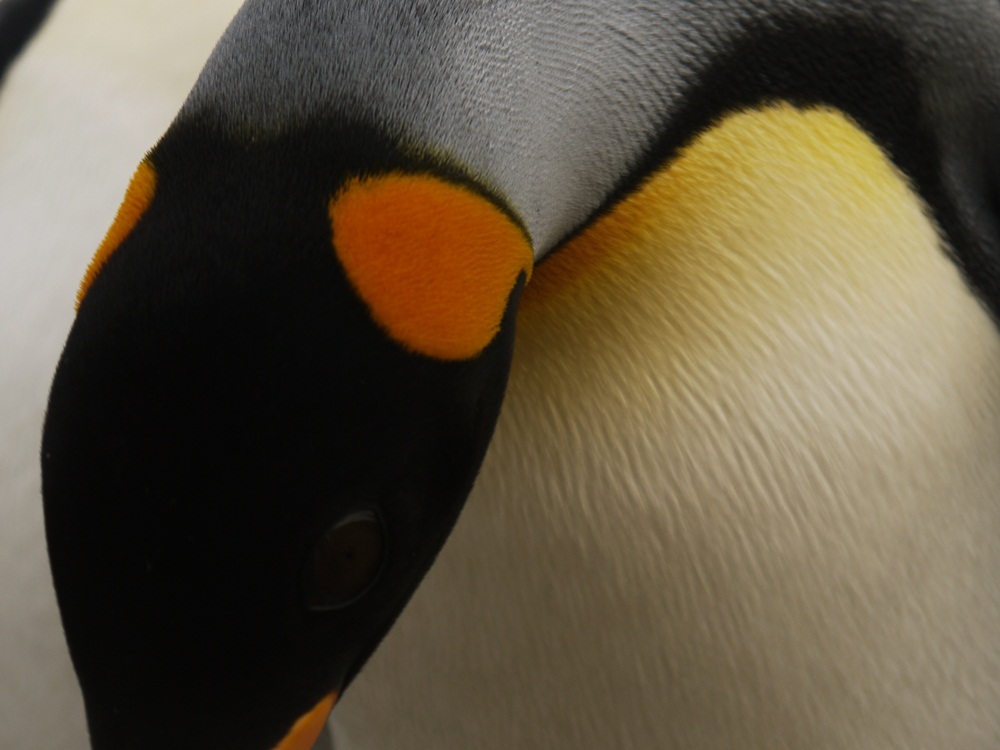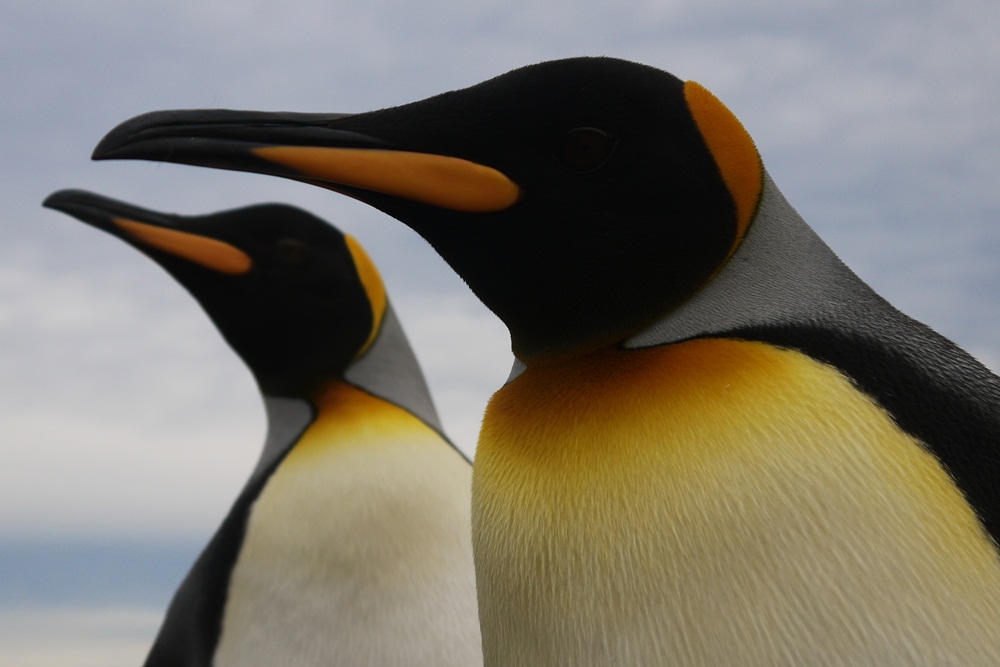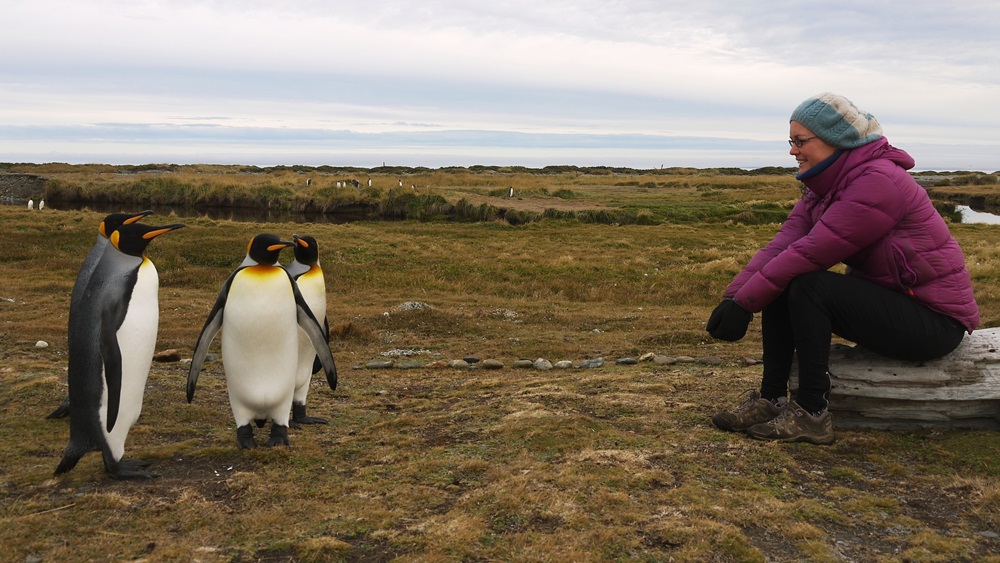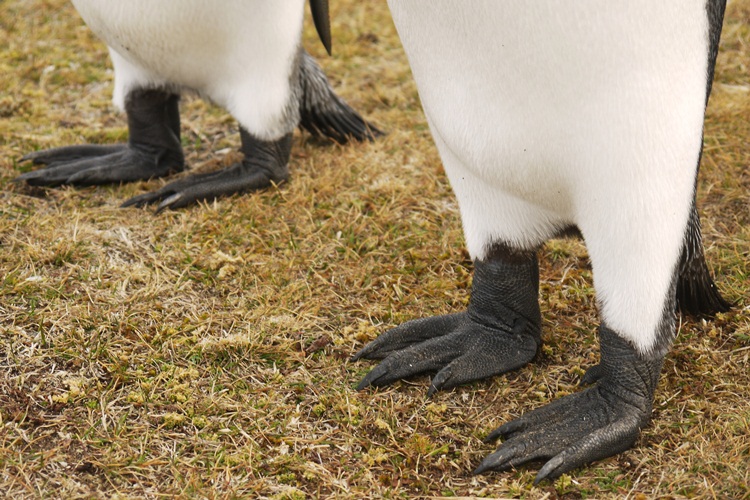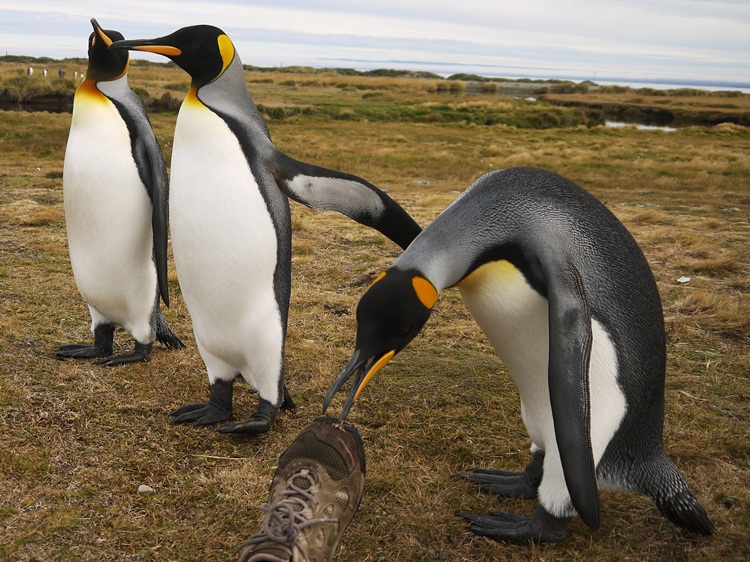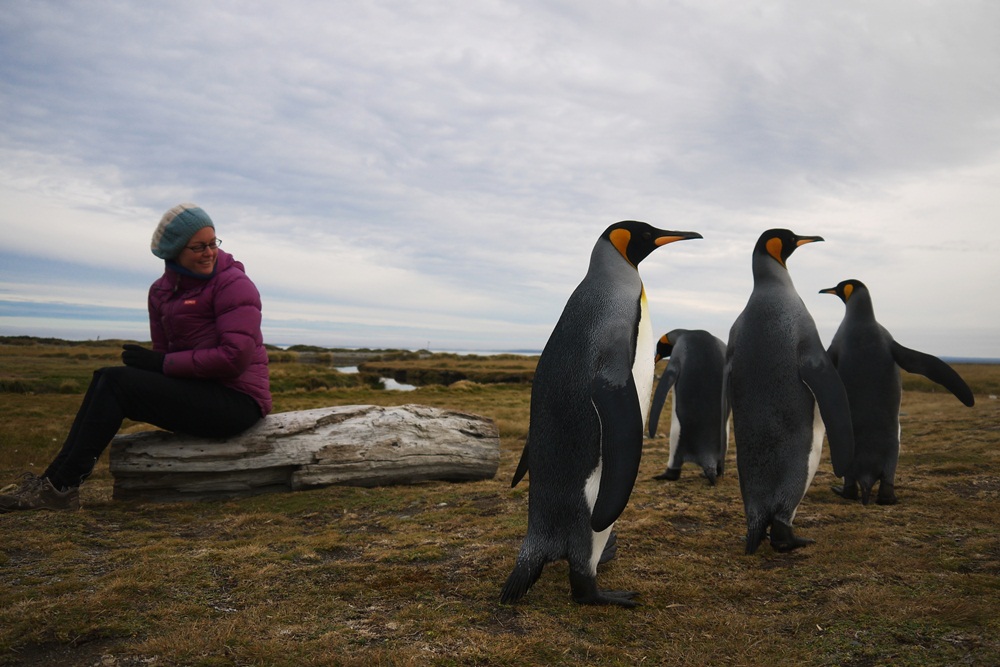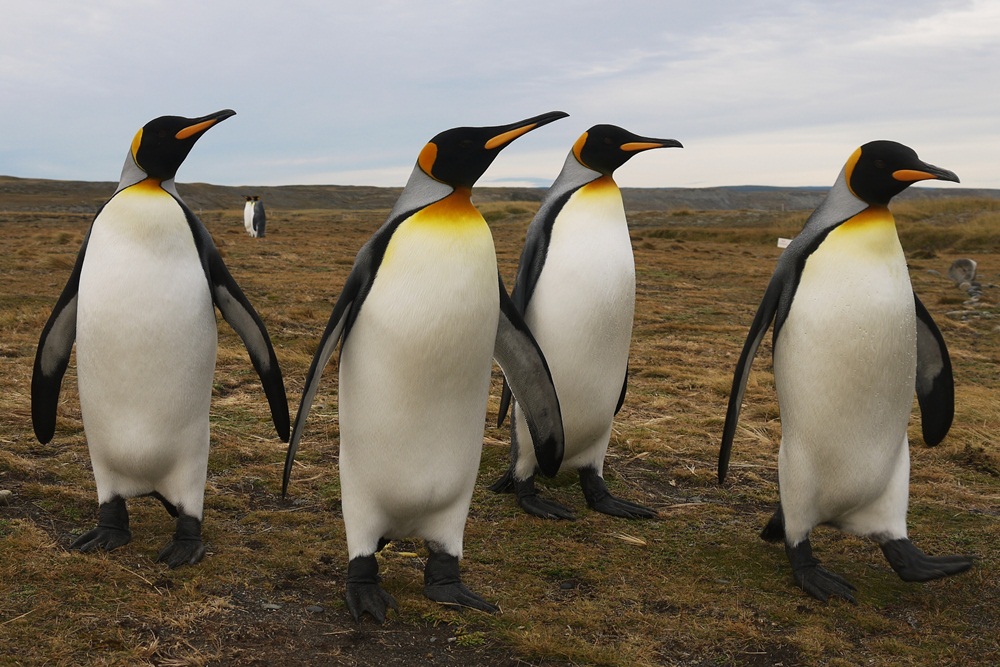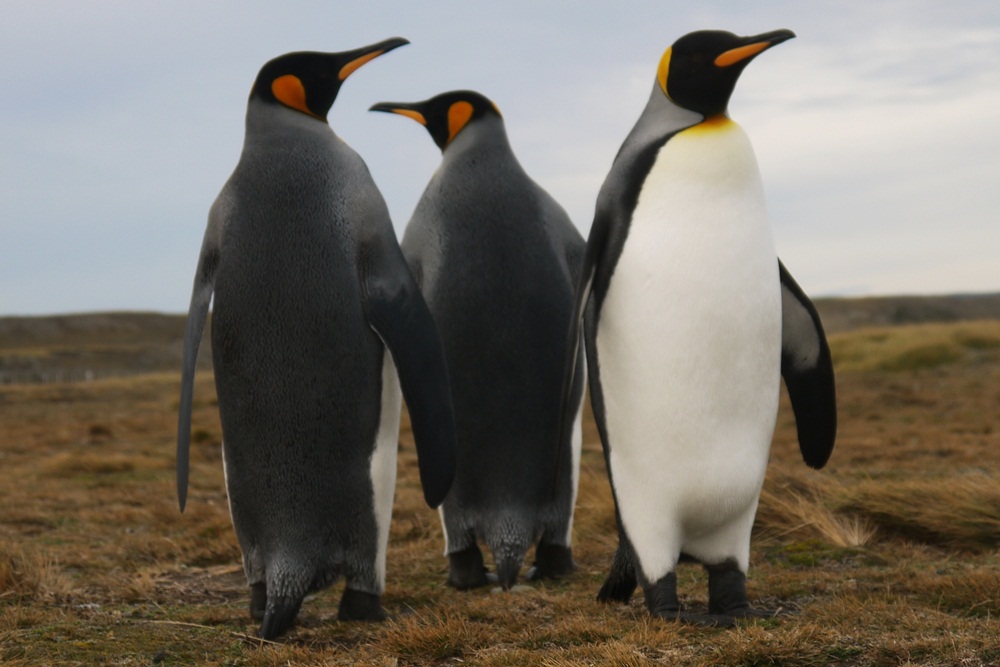A Chilean interlude
October 31st, 2013
Joined by our friend Anna – who we have repeatedly bumped into over the last year but had never quite managed to cycle with so far – we set off together from La Paz. The aim was to leave Bolivia briefly and enter Chile, hunting for volcanoes, salars and thermal baths through the Vicuñas and Isluga national parks .
Two weeks of riding in little-visited corners of Bolivia and Chile covered a wide spectrum of physical discomforts and absolute pleasures. Scraped, chafed, burned, steamed, scratched, sore, parched, blistered, windswept – and yet at the same time mud-bathed, elated, relaxed and awed; we enjoyed every minute of cycling in this remote and epic landscape.
Sarah

The ‘overflow’ Casa de Ciclistas in La Paz is at Mabel’s house; Mabel, stepmother to indefatigable casa host Cristian, also hosts cyclists in her very comfortable basement. We are received as family and really hope to see Mabel, Pablo and Yolita again.

Before leaving, we are lucky to spend time with some very hairy Alaskans. Max, Kanaan and Andy of “A Trip South” introduce us to Russian dumplings, excessive egg eating and the finer points of taming facial hair that is over a year old.

After the frantic road out of La Paz, we welcome the solitude that the desert brings on the second day.

Wild camping with Anna, we begin cooking together. Travelling with other cyclists obviously requires a certain amount of adapting to each others’ ways. We soon find though that on the most important topic (food) Anna’s appetite and hunger for good camp food matches ours and a beautiful new cooking team is born.
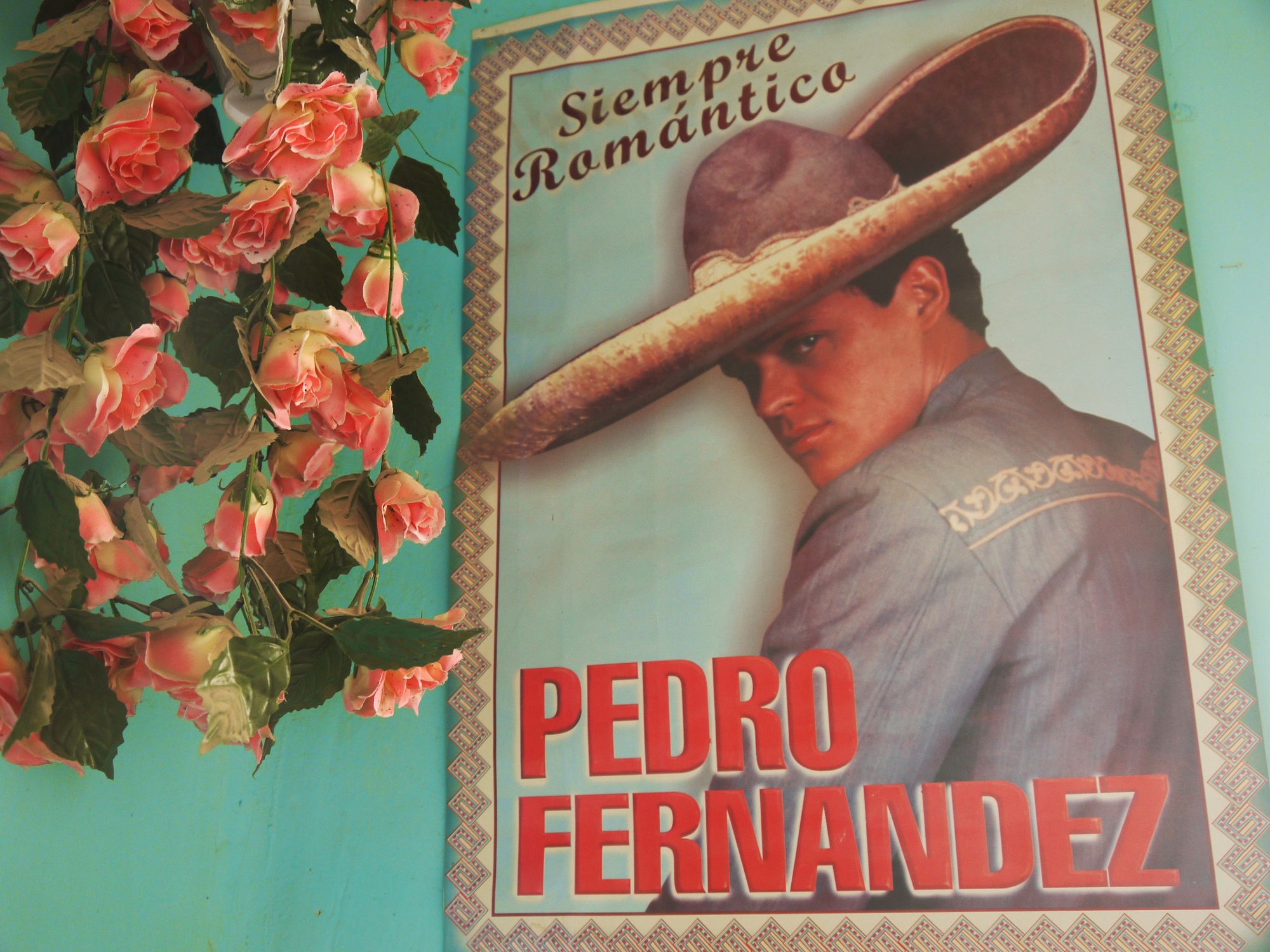
Just one of an eclectic mix of tasteful posters we get to peruse while having lunch in a shop in Curahuara.
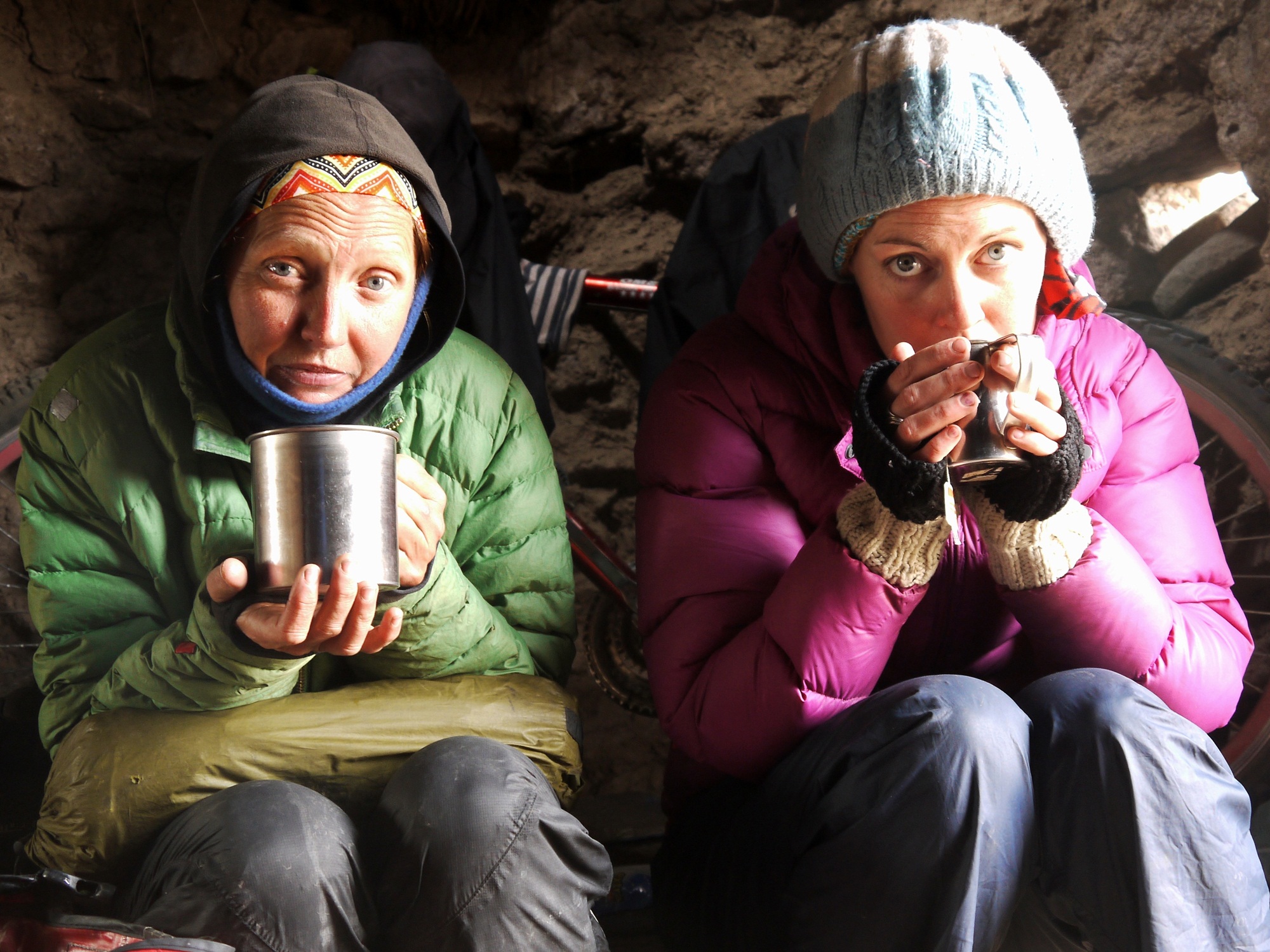
An icy downpour forces us off the road and into a disused shelter. The stove comes out and in a flash we are huddled over cups of tea until the weather clears…
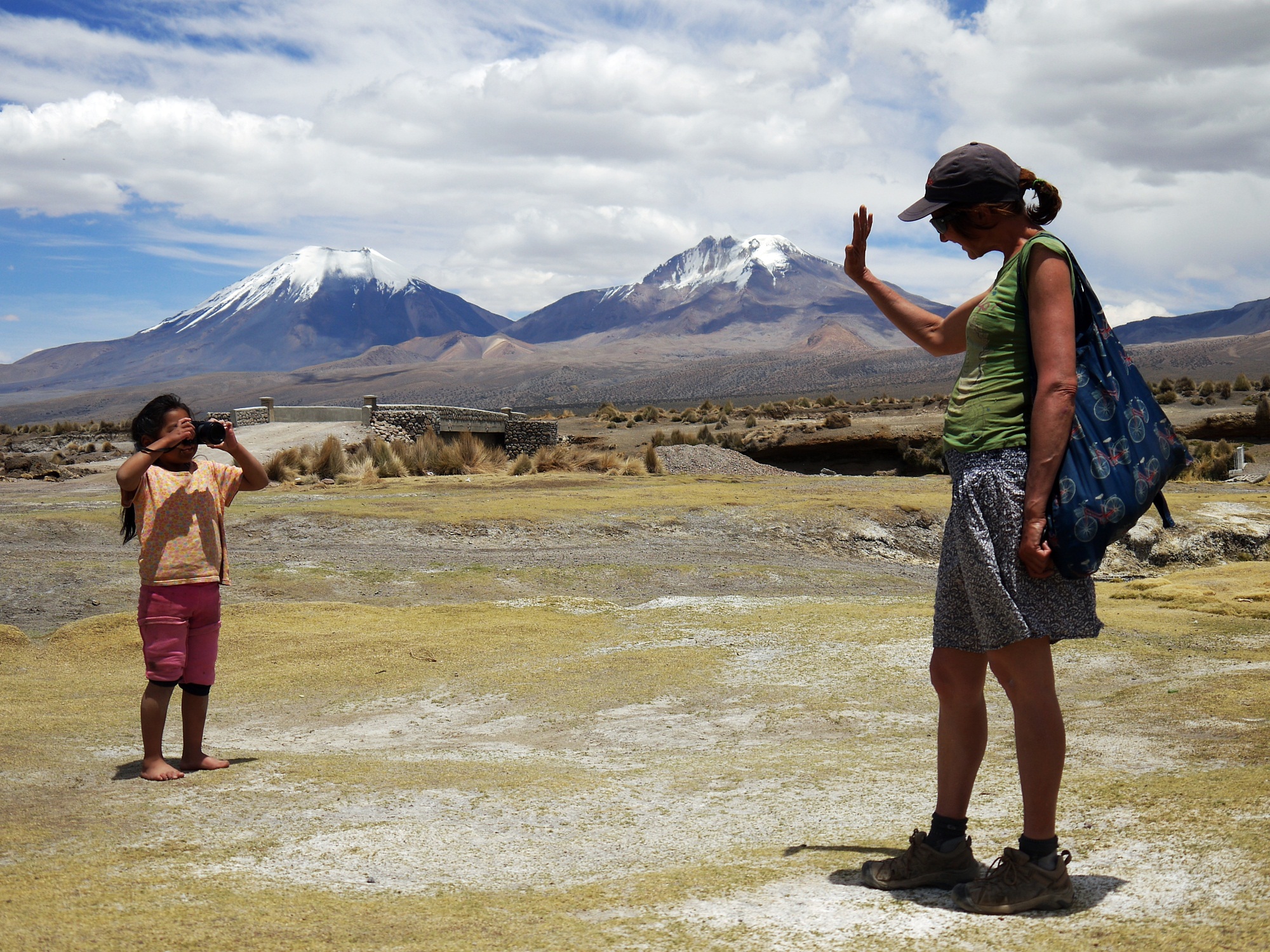
No photos please! Anna gets ‘papped’ with her own camera in the hands of Maria Luz, one of the residents of Sajama with a keen eye for photography.
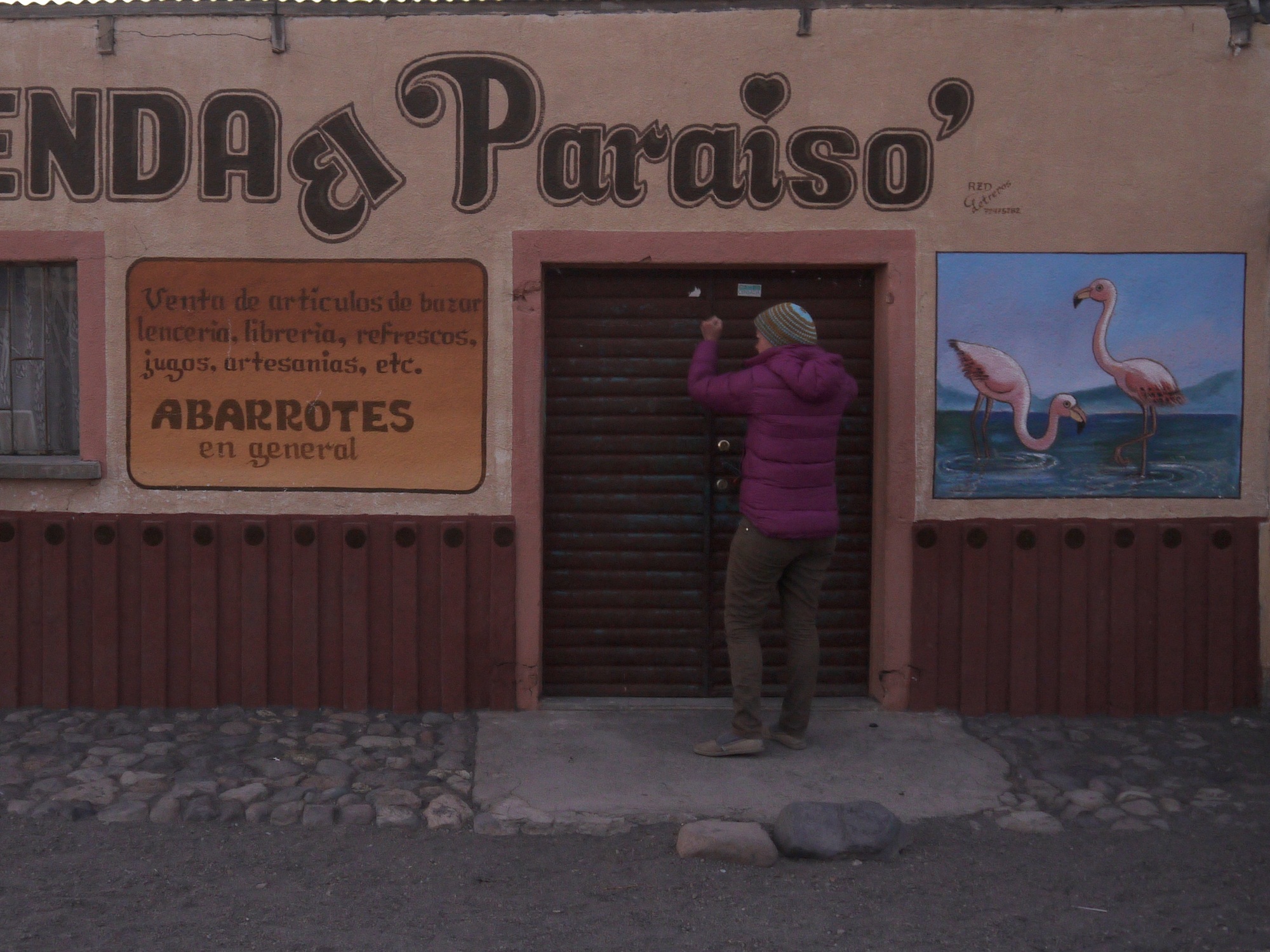
There’s not much going on in Sajama, and the handful of village shops are rarely open. We patiently knock, and wait, and hope…
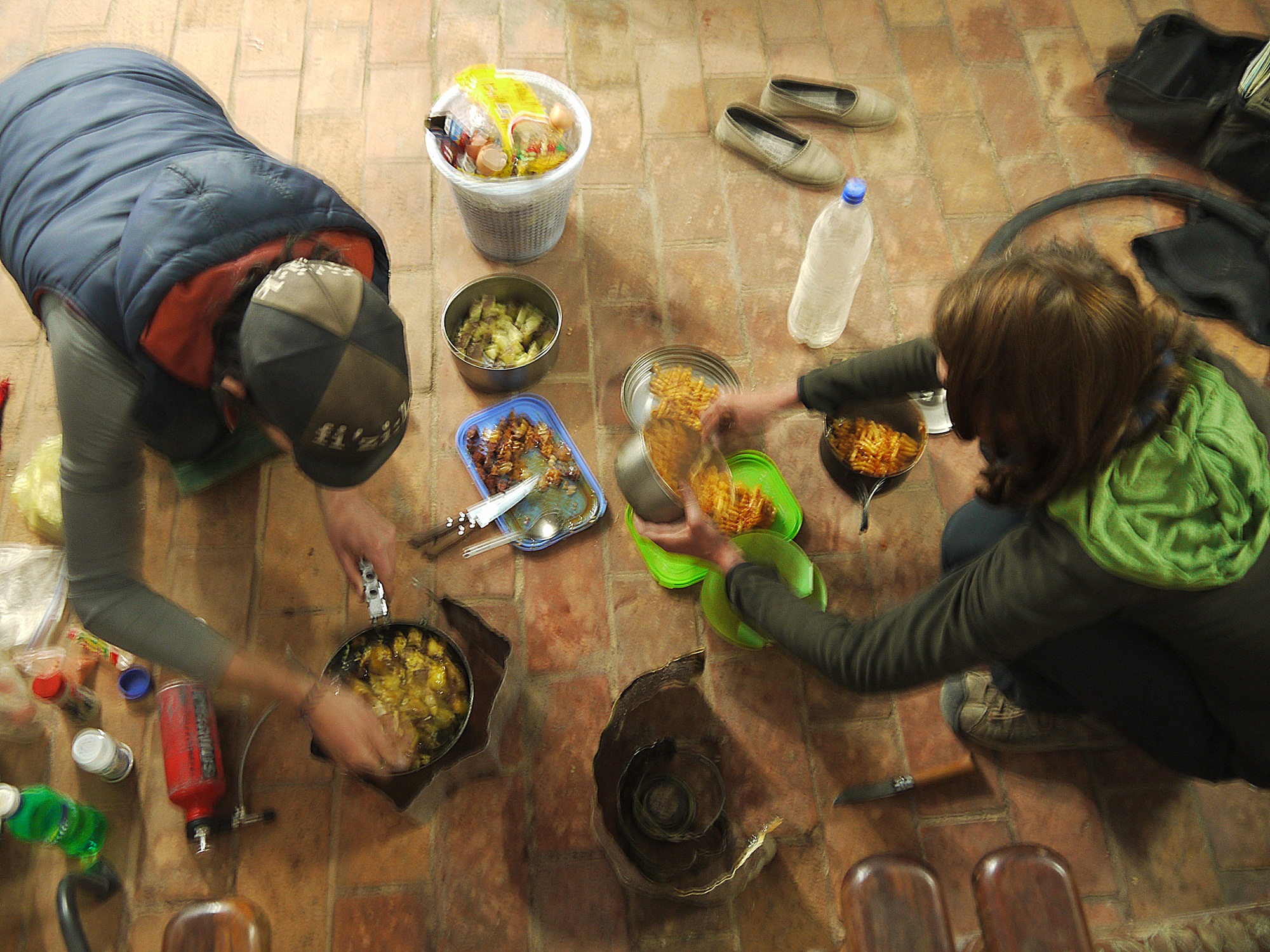
…supplies are short and we have to improvise but there’s still sufficient food to throw three cyclists into a cooking frenzy back in our hotel room…
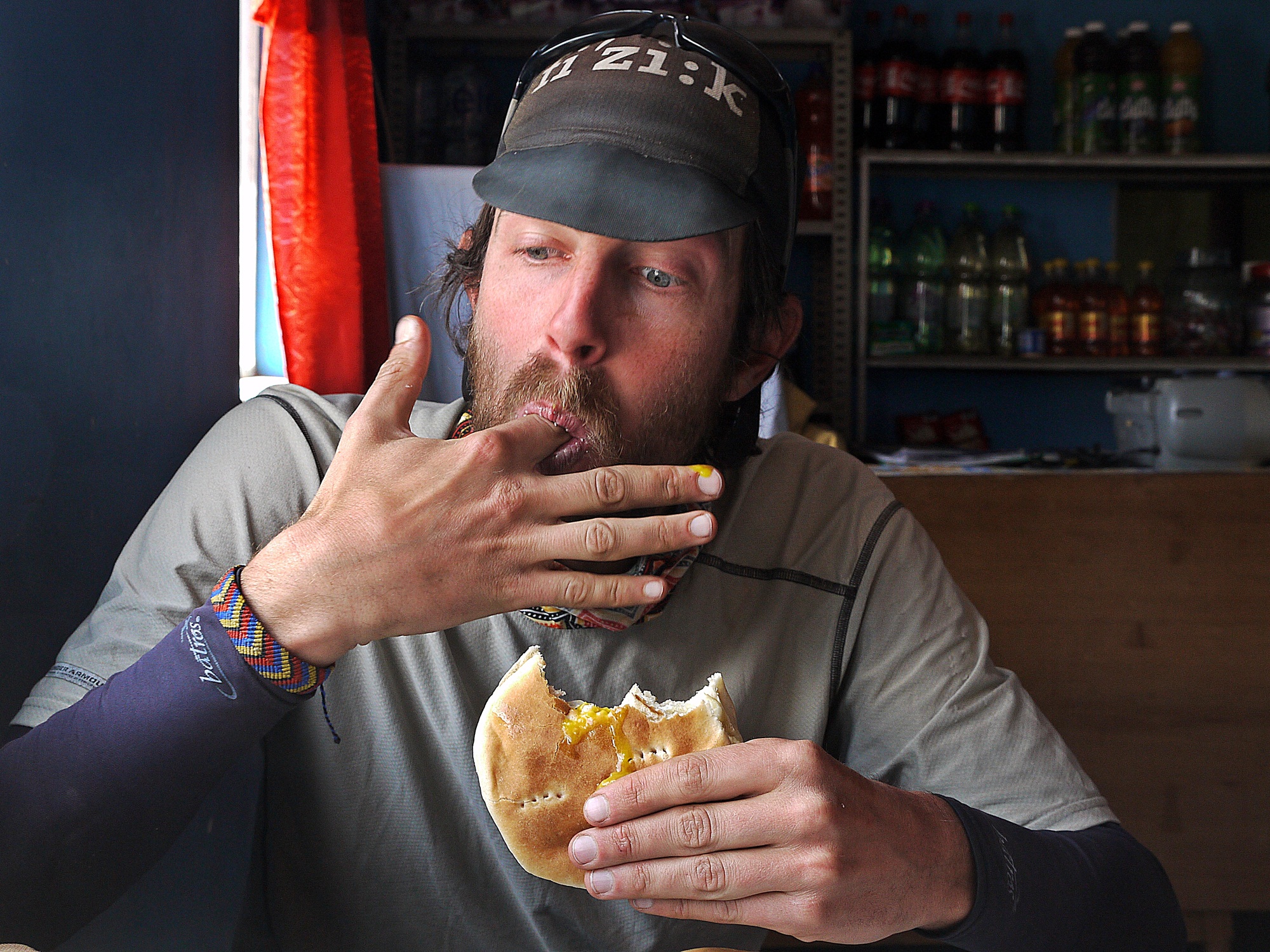
We are forbidden from carrying fruit, vegetables, dairy or meat into Chile and not expecting to encounter shops or restaurants on the Chilean side, we have prepared reluctantly for a five day stint of dried foods and basic meals. We strike gold however on the first morning – a roadside café offering delicious fried egg sandwiches…
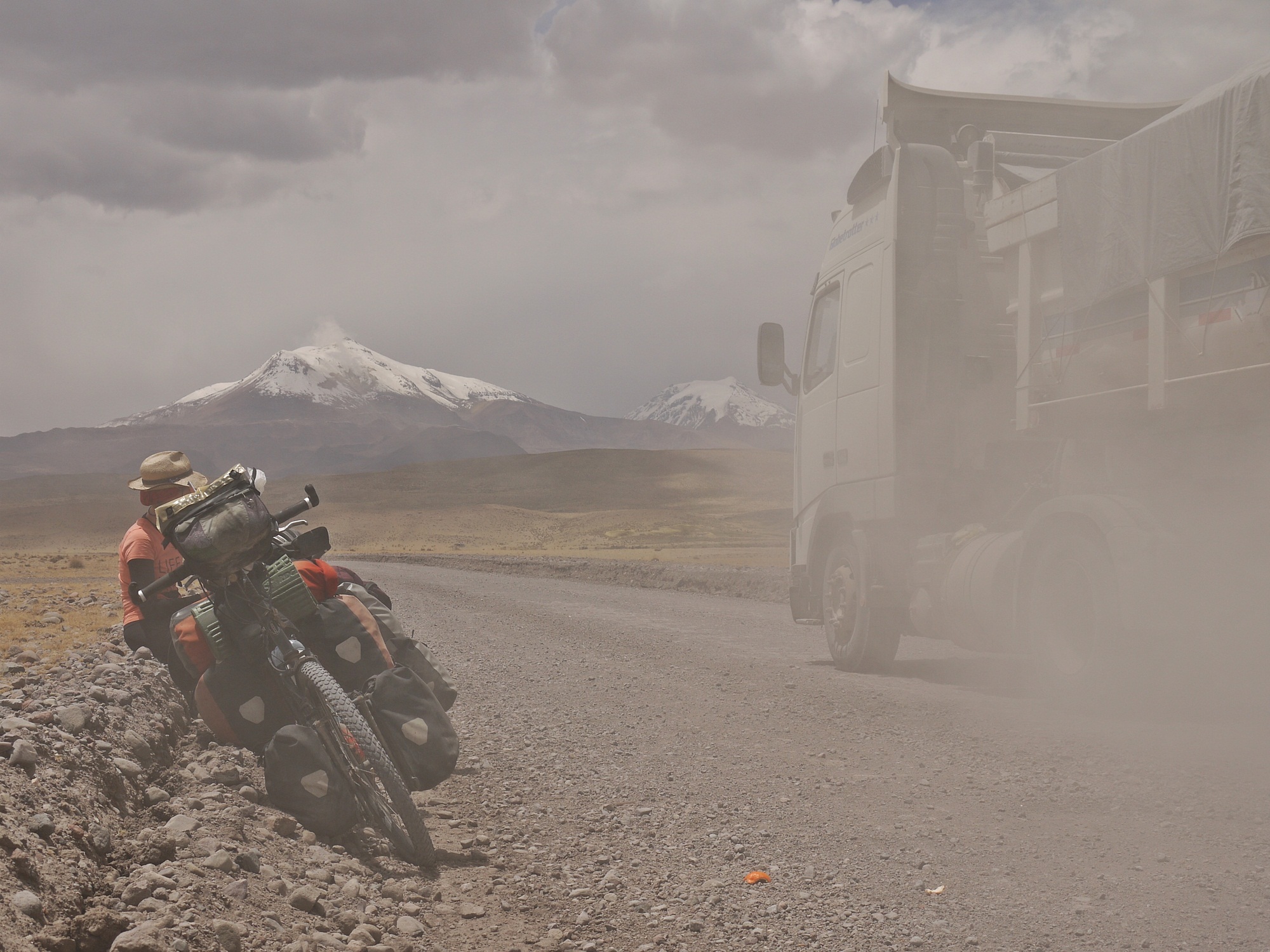
We share the road with a procession of trucks on their way to Arica on the Chilean coast. Despite being very courteous, the lorry drivers can’t avoid covering us in layer after layer of dust.

…and finding ourselves on a wide empty plateau in the early evening, we have to push 3km through sand and wind to find some shelter for camping.
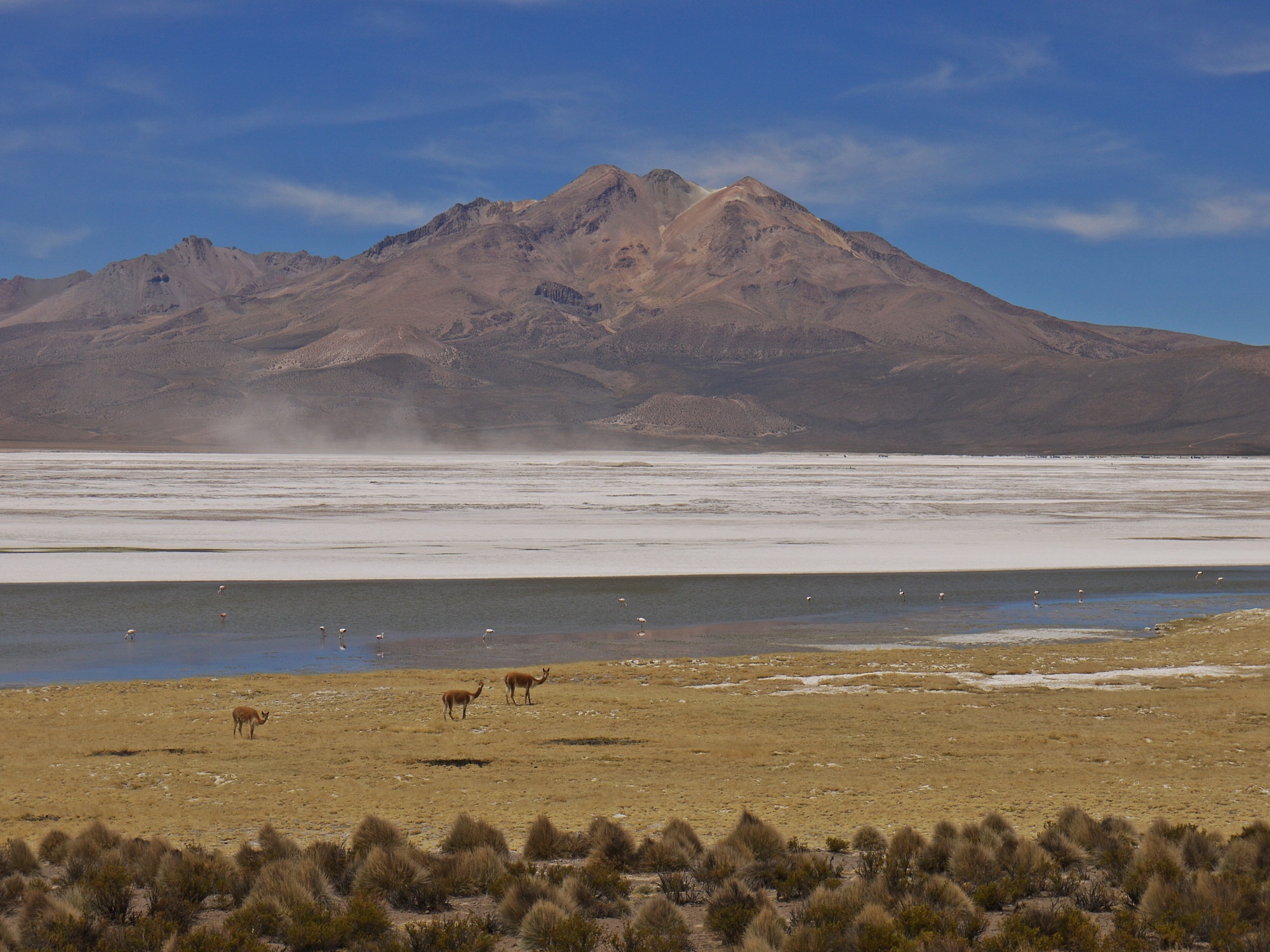
After a silent night of tranquil camping, we are just a short hop away from the edge of Chile’s Salar de Surire. A wide, bright, sparkling, deserted expanse of salt and a haven for vicuña and flamingos.
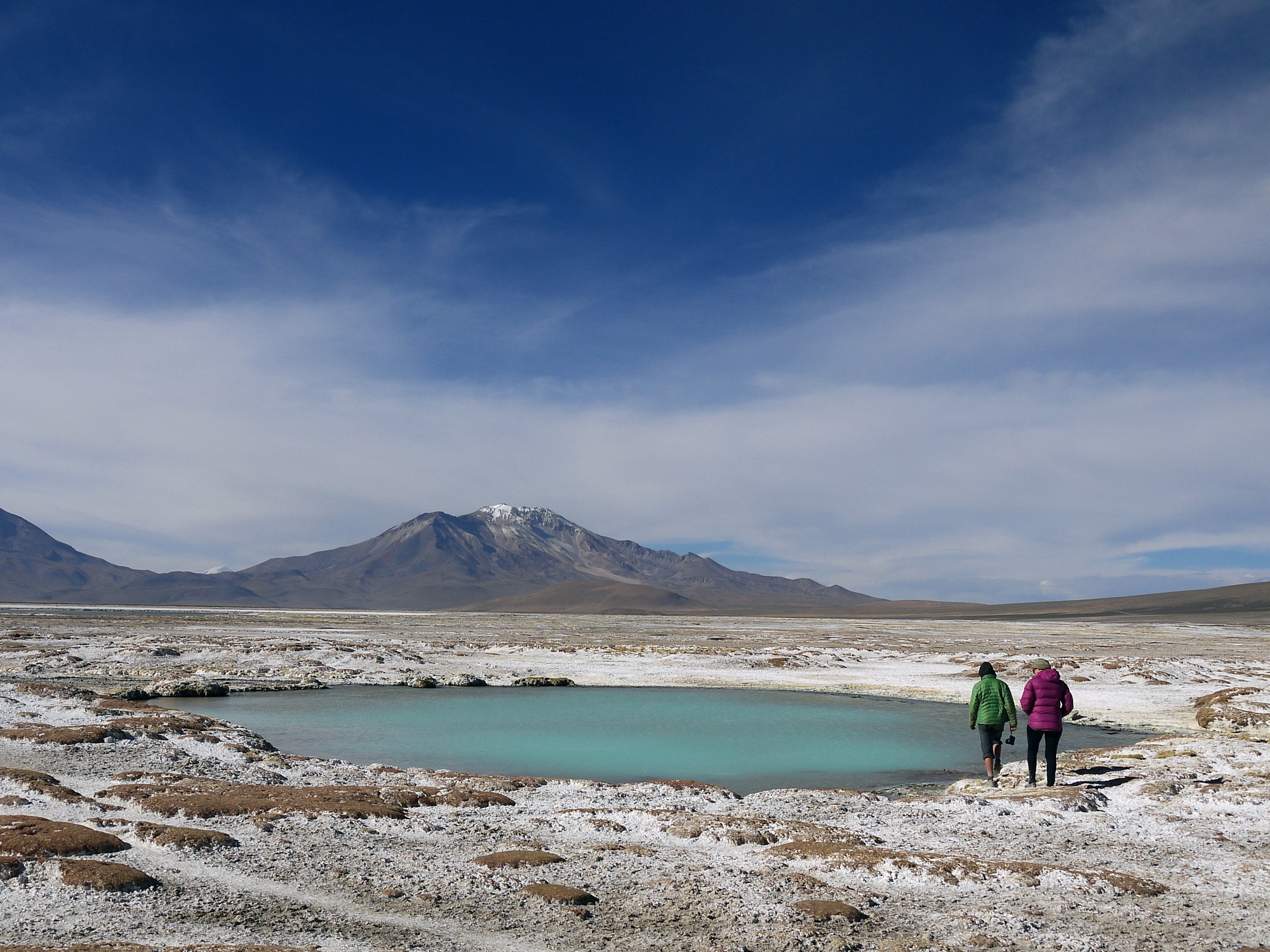
…contrast with the dazzling white salt and turquoise thermal pools. We arrive at the thermal waters at Polloquere…
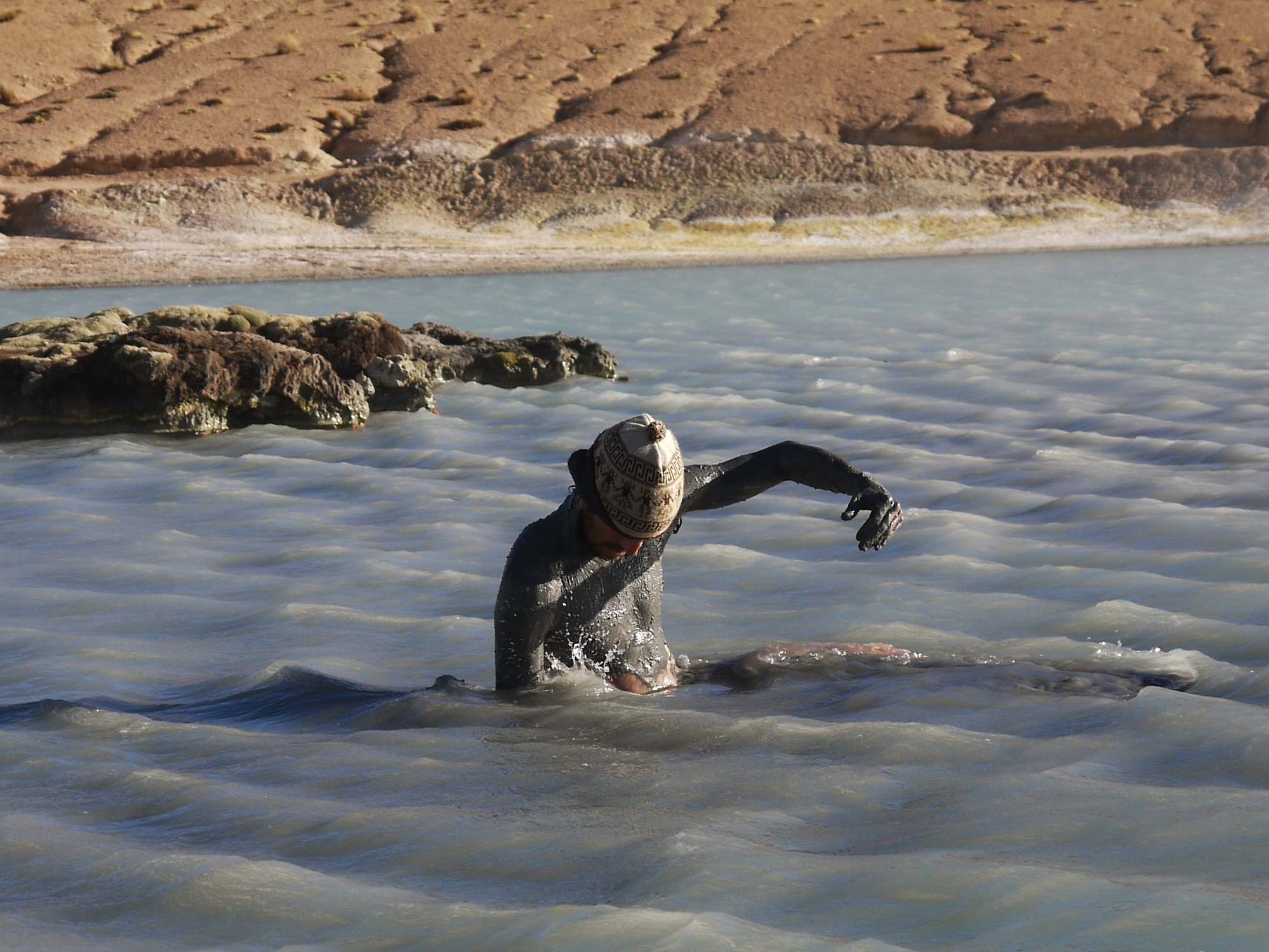
…and jump in. James quickly returns to his “creature from the deep” incarnation, last seen on Lake Tititaca…
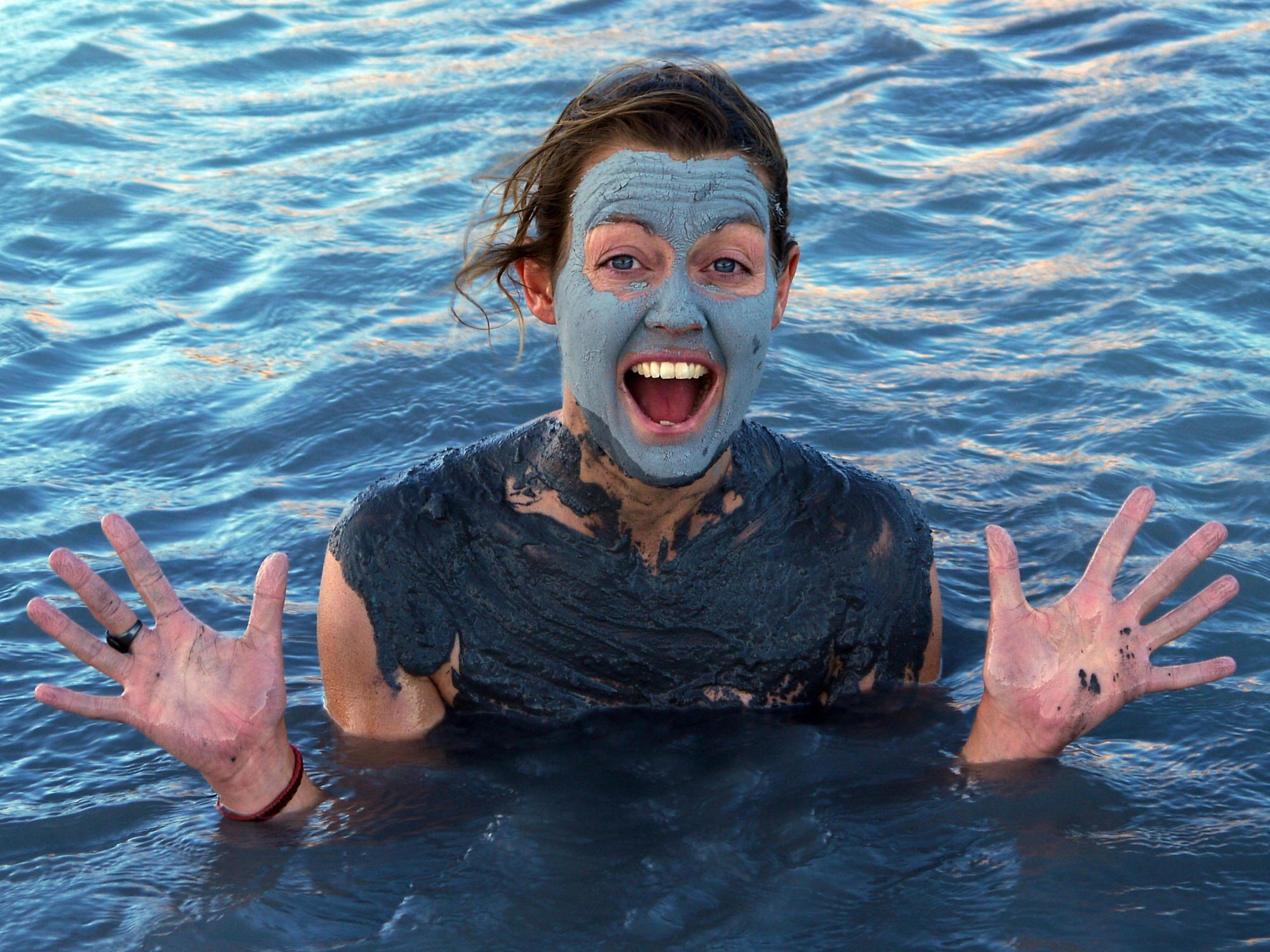
…and I scoop up the silky mud for a face pack. In the cold afternoon winds, the warm waters at around 45°C are bliss…
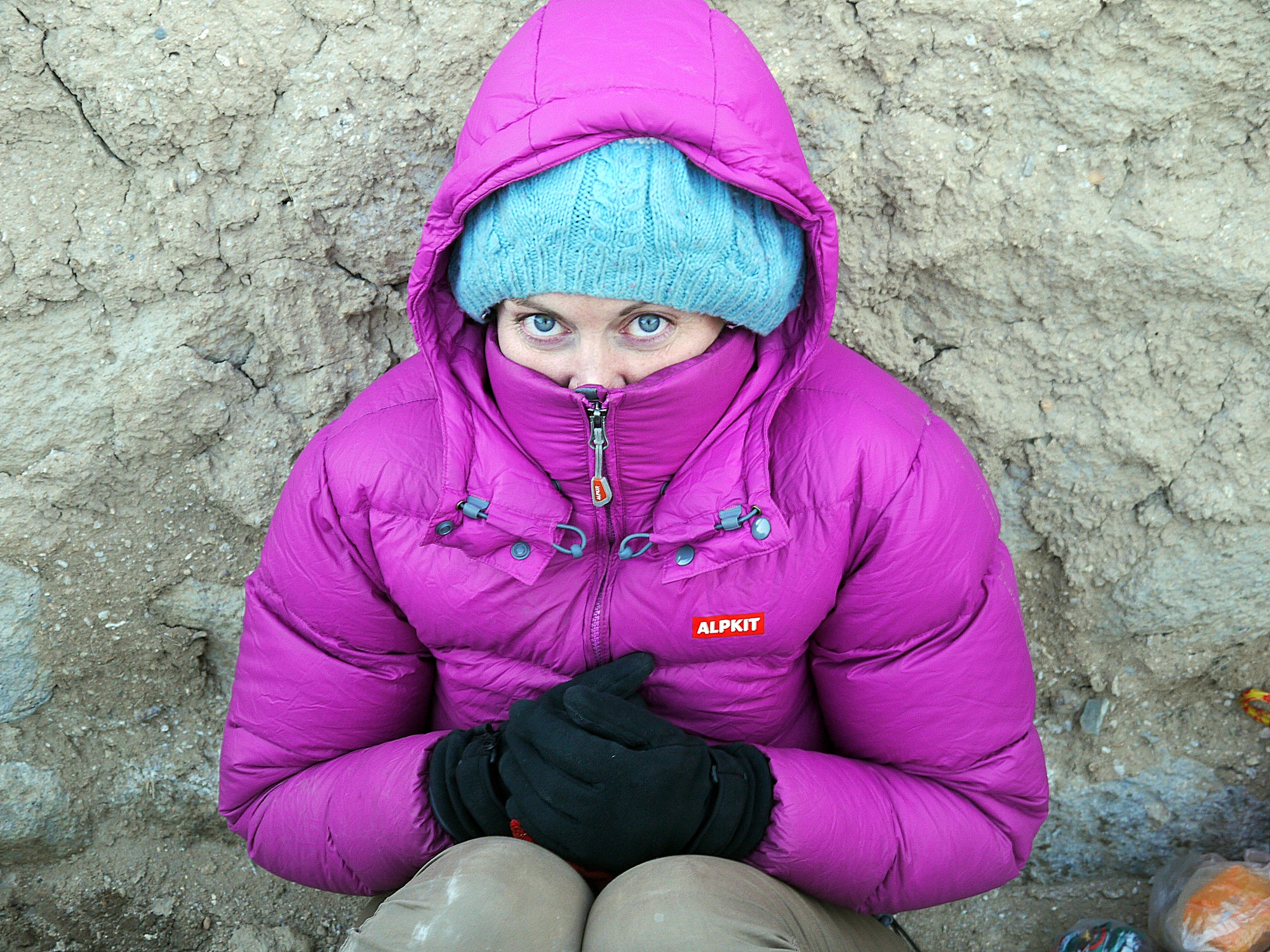
… but it’s a very different story out of the water. Getting straight into warm clothes is a race as the temperatures plummet. We layer up to keep warm…

Dragging ourselves away from a luxurious morning of mud wallowing, we begin our journey back towards the Bolivian border. With barely anything marked on our map and only having seen a handful of lorry drivers for days, we are surprised to find so many place names marked on this road sign…

Crossing back into Bolivia is quick and easy and soon we are back amongst the truckers as the sun sets over the border town of Pisiga.
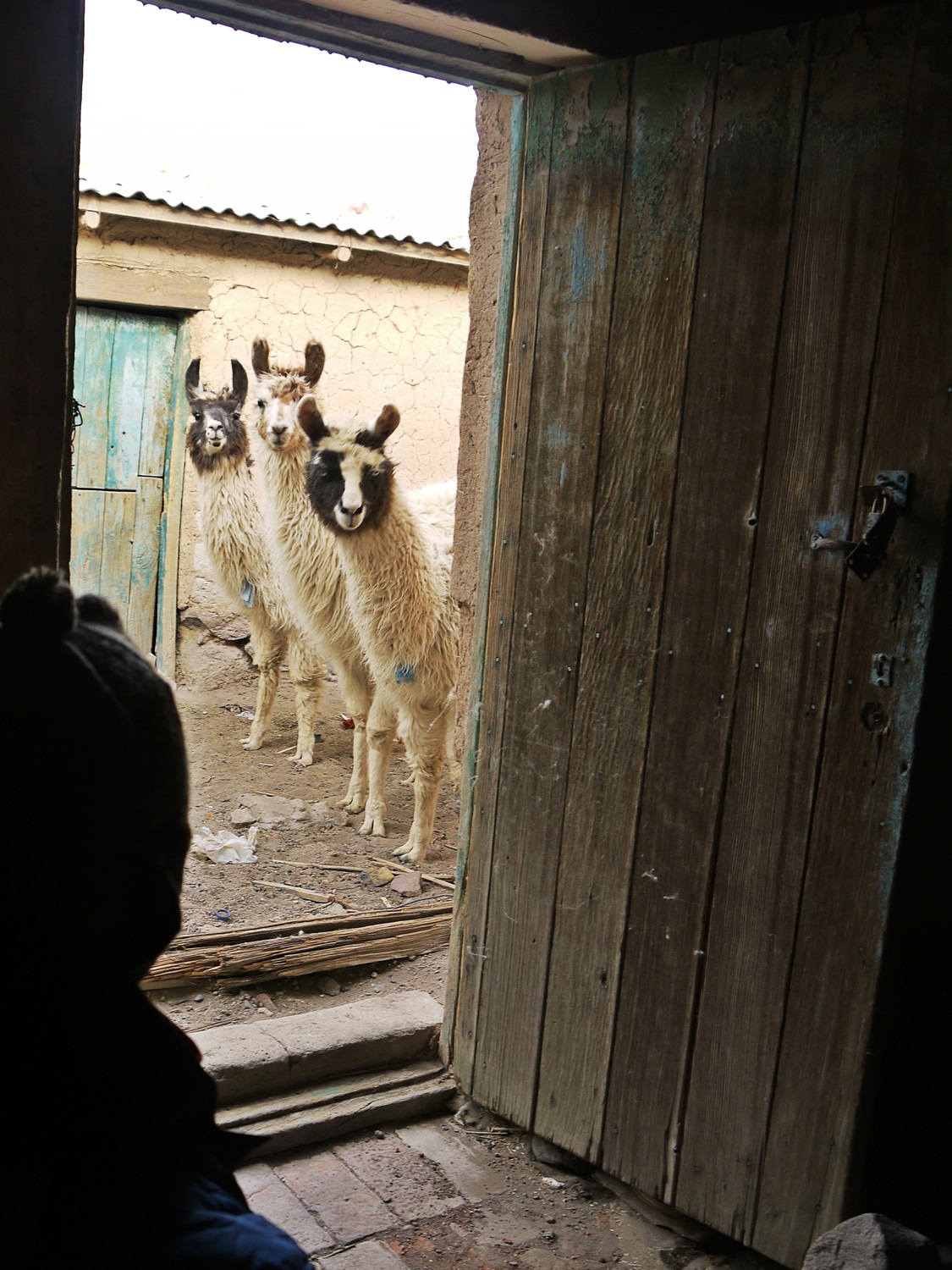
Keen to camp, we accept an invitation from friendly Miguel (who owns the local grocery shop in town) to camp with his baby llamas. They insist on overseeing every aspect of our routine, and welcome us appropriately back to Bolivia.
Anna also blogged about this section of our trip and you can read it here.
Route notes:
Bolivia:
Route: La Paz – Patacamaya – Sajama – Tambo Quemado
– Reached Sajama via unpaved back road which loops to north of Volcán Sajama via Ojsani and Tomarapi – recommended. Turn off level with telecom towers on hill, towards rock forest.
– Last shopping opportunity in Tambo Quemado on Bolivian side – we didn’t see a shop again until we crossed back into Bolivia at Pisiga, 5 days later.
– No fresh fruit, veg, meat or dairy products into Chile – they scan your bags to check. Peanut butter OK, honey and jam not!
Chile:
Route: Guallatire – Chilcaya – Enquelga – Isluga – Colchane
– From customs and immigration, back track a few hundred metres and take the turn on the bend signed to Guallatire – an unpaved, sandy road which climbs to a pass. 10km from customs to Chirigualla hot springs – we slept cosily inside the hut.
– Polloquere hot springs – approx 32km from Chilcaya. Follow dirt road around the east side of the Salar de Surire. At junction in corner of salar, keep right (left turn, uphill, goes back to Bolivia) – springs are on right after a couple of km.
– After springs, continue on this road to a well-signed junction – turn left towards Colchane.
– Food: roadside comedor 10km before Guallatire – also sells biscuits. Other than that, we saw no shops in Chile.
– Water: never carried more than a day’s supply – available from Customs post at border, carabinieri (police) at Guallatire and Chilcaya, and some freshwater springs on the pampa after the Cerro Capitán pass.
See our map for a route overview.
39′s the Magic Number
February 1st, 2014
Since I was a child, every year I watched the chattering swallows which had nested in our barn gathering on the wires before their autumn migration in fascination. What must be going through their heads, I wondered? Fear? Anticipation? Excitement?
Now, as our own southerly migration neared its conclusion and thoughts turned to the approaching winter, my head was certainly awash with all those competing emotions. A trip whose end had always been studiously ignored had become reduced to a countdown of just a few short months. Like my swallows, we gathered with friends at Daniel’s impromptu casa de ciclistas in Talca to plot what really felt like the final leg.
Maps were pored over intently and marked with arrows, distances and strange symbols. Beards were stroked furiously. Tips from friends down the road and half-remembered anecdotes from other cyclists’ blogs were met with studious scribbling. The warm late summer sun shone outside, but inside the two Patagonian “W’s” loomed large: Winter, and Wind.
After carefully keeping winter at our backs for the last two and a half years, now for the first time winter would be creeping northwards to meet us. If we wanted to avoid the Patagonian winter, then we would have to get to Ushuaia before the snow did. And, if we wanted to do that, then for the first time in a very long time, we had a deadline.
According to cycle touring lore there is nothing to see in Chile’s central valley – the real action, it is said, doesn’t begin until you hit 39 degrees latitude, where the desert finally gives way to the green lushness of the Chilean and Argentine Lake Districts. And so plans were hatched to make rapid progress south. Some opted to hit fast-forward by pedaling the tarmac treadmill of Ruta 5, while others elected to jump ahead by bus as time pressures began to bite.
And yet as we gazed at the map of Chile, we couldn’t help thinking we were missing something. In fact, probably the most obvious thing about this long snake of a country: its coast, all 6,435km of it. Surely we couldn’t ride through Chile without at least a taste of one of its most prominent features? Added to that, we hadn’t seen the sea since the Colombian Caribbean 15 months earlier – probably the longest land-locked period of our lives. Deep down, our islander genes were undoubtedly craving the sight, sound and smell of the waves.
We also wanted to see something of everyday Chile and meet normal chilenos, conscious that our route further south would take us through some of the most tourist-saturated and uninhabited parts of the country. “They’re the British of South America” we had been told, conjuring up intriguing images of Neighbourhood Watch, orderly queues and fish and chips by the sea. And so off we headed on a less-than-direct route towards the magic 39th parallel, finding on our way a welcome dose of sea air and warm Chilean hospitality.
James
Leaving Talca, we head west towards Constitución. By late afternoon the rain has set in and we are soaked and searching for shelter. Rosa spots us from her doorway, and within minutes we are drinking hot tea and tucking into her pan amasado (homemade bread), while she insists on making us up beds for the night. As much as we love our tent, beds are wonderful things – especially when you aren’t expecting to sleep in one.
…and gather for the obligatory pre-departure shot. Thank you Rosa, Soledad and family for making us so welcome!
This coastal strip used to be covered in ancient forests, but sadly these are long gone and replaced by depressing stands of sterile conifers. Nevertheless, forestry brings much needed work for people like Rosa’s husband Elias, and we dodge the logging trucks as we roll on past sawmills.
Beneath the idyllic surface however, this is a a region still struggling with the aftermath of 2010′s earthquake. The resulting tsunami washed away whole villages, leaving many dead and even more homeless.
Many houses which survived remain covered in plastic sheeting, while new, blue homes have been built for some of those who were left homeless.
Pausing in a gateway for a mid-morning snack, we are beckoned over by a friendly farmer who offers us a supplement…
Beyond Cobquecura, the road turns to dirt and the traffic slows to a trickle, putting a smile on our faces. This is rural Chile: forgotten back roads…
…and smallholdings where the wheat is still harvested by hand. It feels a world away from the gleaming, mechanised agrobusiness of the Central Valley just an hour inland.
We camp on a beach with some chilenos, and in what we are fast-learning is the Chilean way, within minutes food appears – delicious strawberries…
…best enjoyed with another sunset. Strangely, all thoughts of Patagonian winter seem to have vanished.
The next morning the rollercoaster continues, eventually bringing us to the Itata river. Keen to avoid a 40km detour inland to the nearest bridge, we try our luck in finding a boat to take us across. We stop at a house, where we meet Raúl. A quick dash around the village and he finds a boatman who will take us across. “But first,” he says, “why don’t you have lunch with us?”
Of course, it would be rude to refuse, and soon we find ourselves sitting down to lunch with 12 members of a Chilean family we have never met…
Of course, one hour turns into two, and then three – and by the time we finally drag ourselves away we have long missed our lift across the river. We push our bikes along the beach towards the river mouth anyway, hoping to get lucky…
…which we do. Alejandro, a fisherman who is drag netting at the river mouth cheerfully rows us across, explaining that he has done the same for a few cyclists before us.
Here, the fishing boat marooned in a sea of construction says it all – Dichato was one of the villages worst affected by the tsunami.
Evening finds us in Penco, where we go in search of the bomberos (firemen), who invite us to camp in their garage and make a fuss of their cat Bonito – which we duly do.
One final beach camp brings some respite, along with a delivery of deliciously artery-clogging sopaipillas (fried bread) from friendly camping neighbours.
And then the latitude ticks over the magic 39 degrees as we finally reach Villarrica and the Chilean Lake District. Our excitement is short-lived however, as childhood memories of holidays in the English Lake District come flooding back. Green, lush…and very, very wet. Looks like the waterproofs will be seeing a lot more action from here to Ushuaia.
Lakes & Gates
February 24th, 2014
In my experience, when given the choice between a lake and a gate, cyclists would normally always opt for the lake. Throughout our trip, pedalling past beautiful lakes has brought us peace and contentment. The two mighty lakes of Atitlán in Guatemala and Titicaca in Bolivia spring immediately to mind, but there have been countless lakes along our route to relax by and enjoy.
Gates on the other hand have always represented a temporary or permanent obstacle in our path; an annoyance. Either we have been completely unable to pass or, in deciding to tackle the gate, we have had the onerous task of unloading our bikes, heaving them over the gate and loading them back up again – not much fun with two bikes and ten bags between us.
On this leg of the journey however, it was to be the reverse. The lakes, although pretty, were hidden from us behind a succession of wet and grey days and instead it was the series of gates that were the real pleasure along the road, tempting us along towards the Carretera Austral.
Sarah
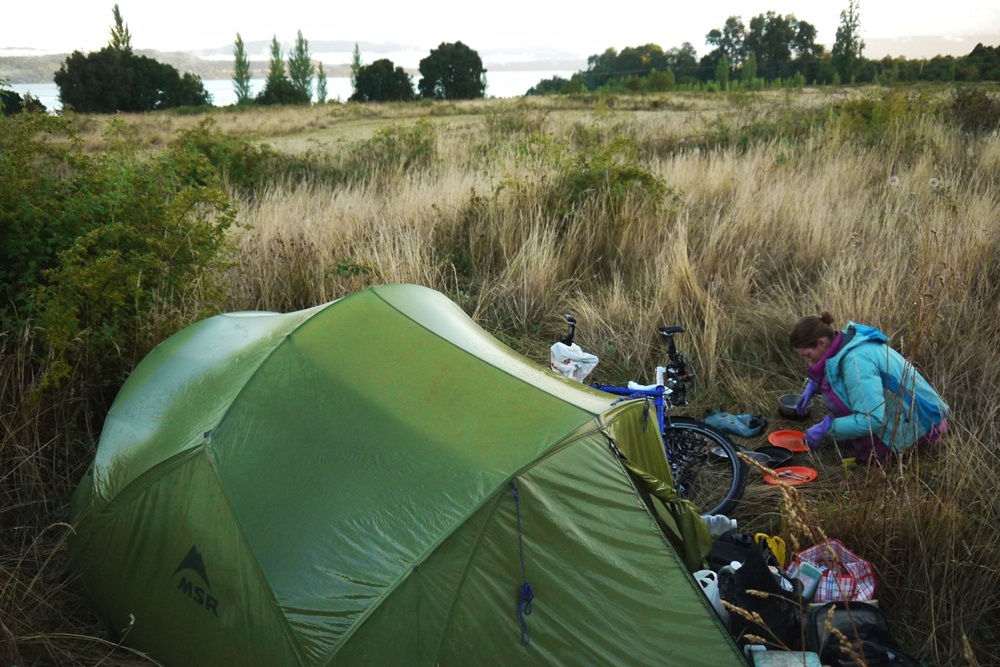
Leaving the northern Chilean coast behind, we are off to a bad start, arriving at Villarrica, portal to the Chilean lake district in the middle of torrential downpour. Unlike our beloved English Lakes, there isn’t even a fascinating pencil museum to shelter in and so we pitch a soggy tent in a soggy field…
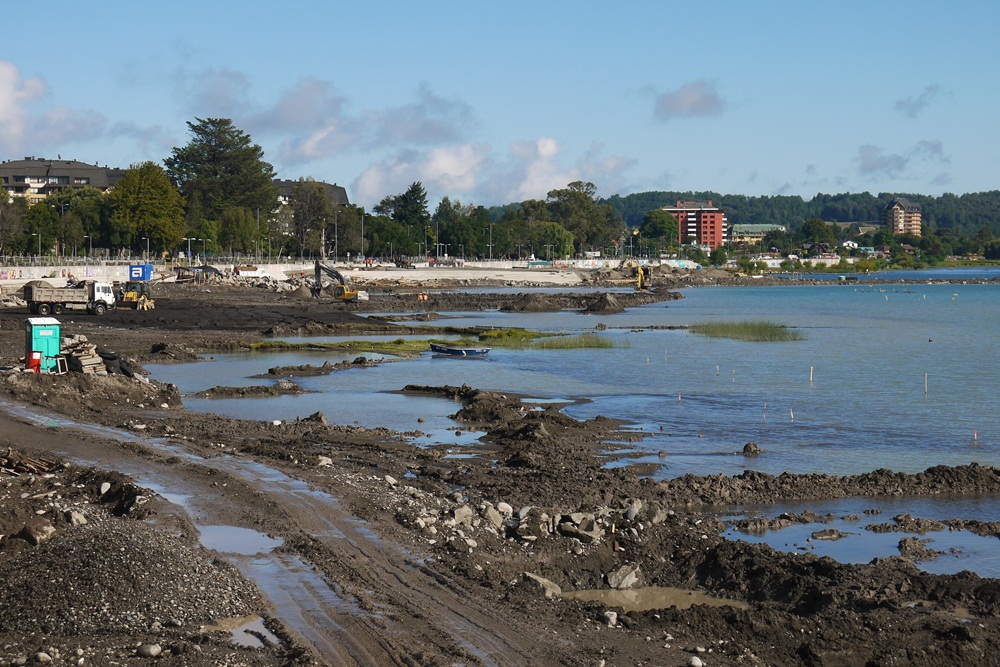
…and wake up to breakfast on a building site. Villarrica sees the potential in tourism and is in the midst of building an artificial beach for its visitors.
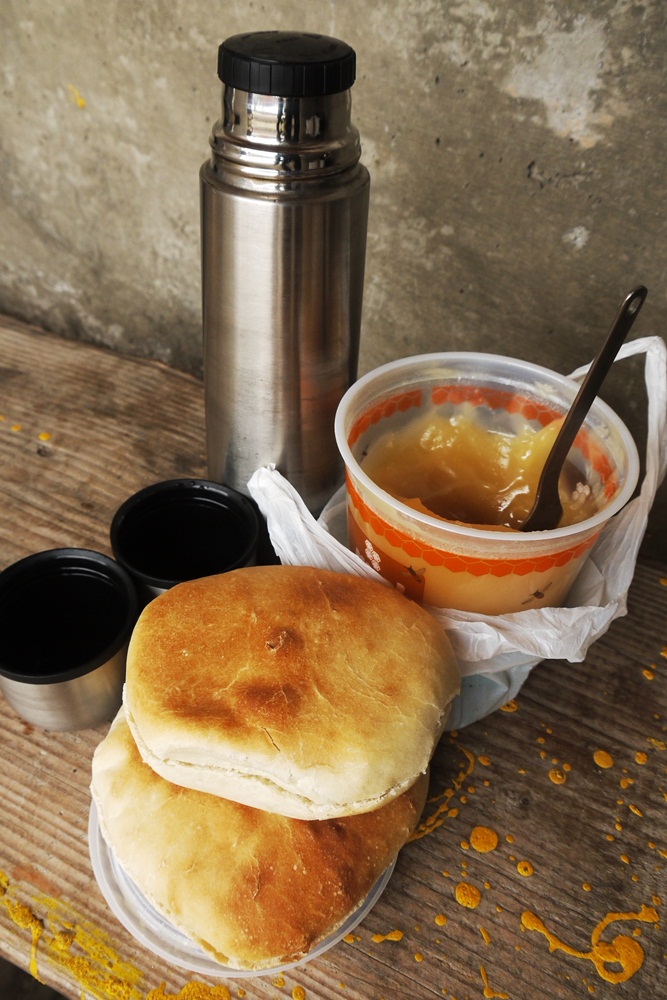
Another highlight of bike travel in Chile is stopping for warm bread straight from someone’s oven. Pan amasado can be found in nearly every village in Chilean Patagonia and this particularly warm, fluffy and comforting batch couldn’t have come at a more welcome time. Straight from the oven with fresh local honey and a cuppa from the flask. Perfect.
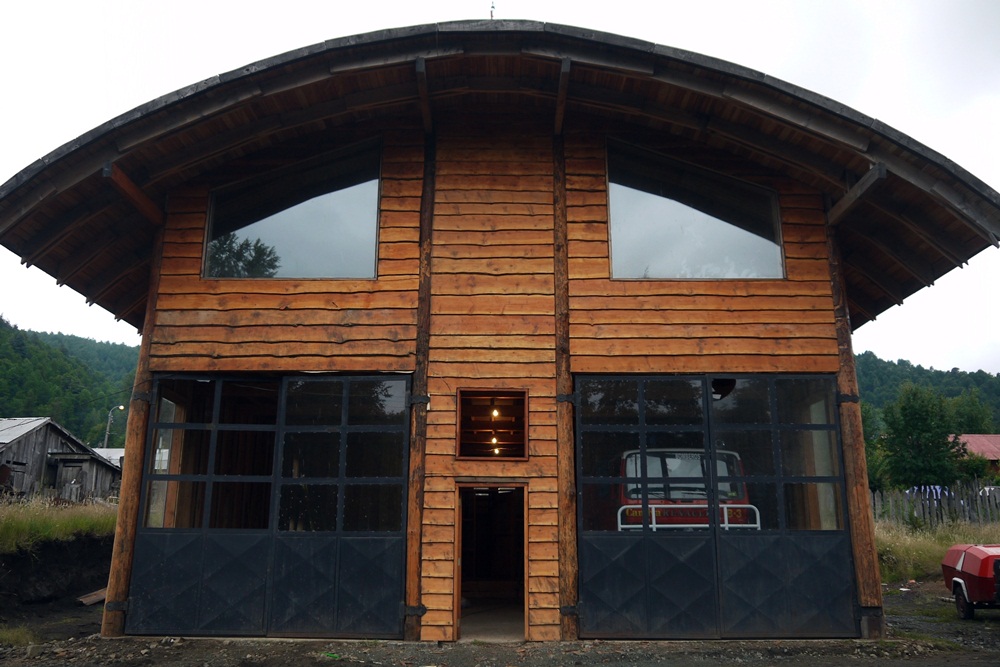
Rain again stops play. We are forced to postpone our ferry crossing at Puerto Fuy because the weather is so bad but it leads us to ask for shelter at the cosy new fire station in the village.
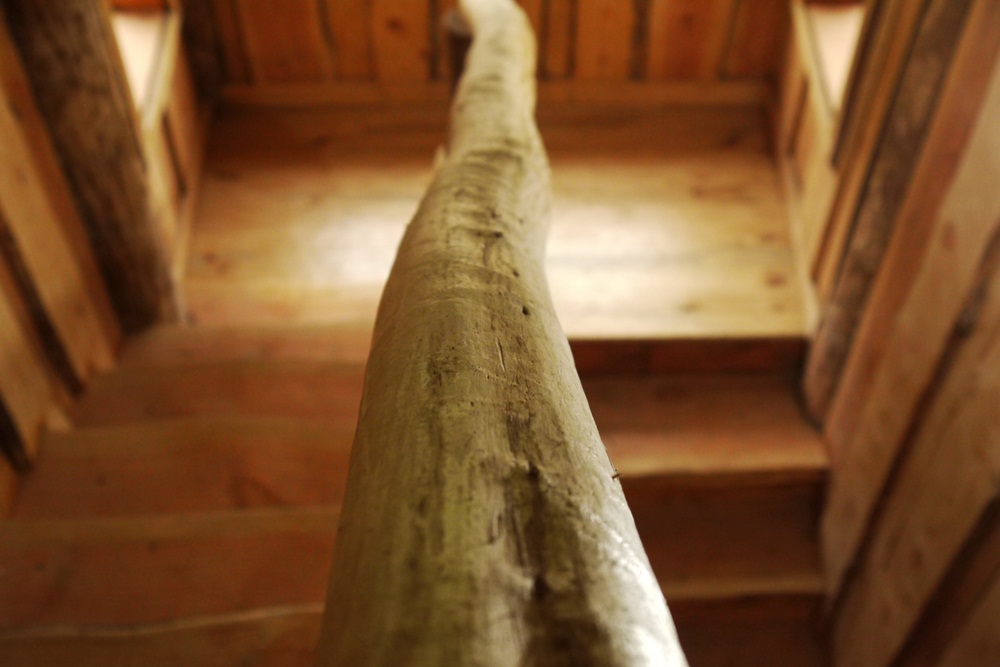
Beautifully constructed from local pine, it’s not quite finished yet, but the attention to detail and craftsmanship are evident.
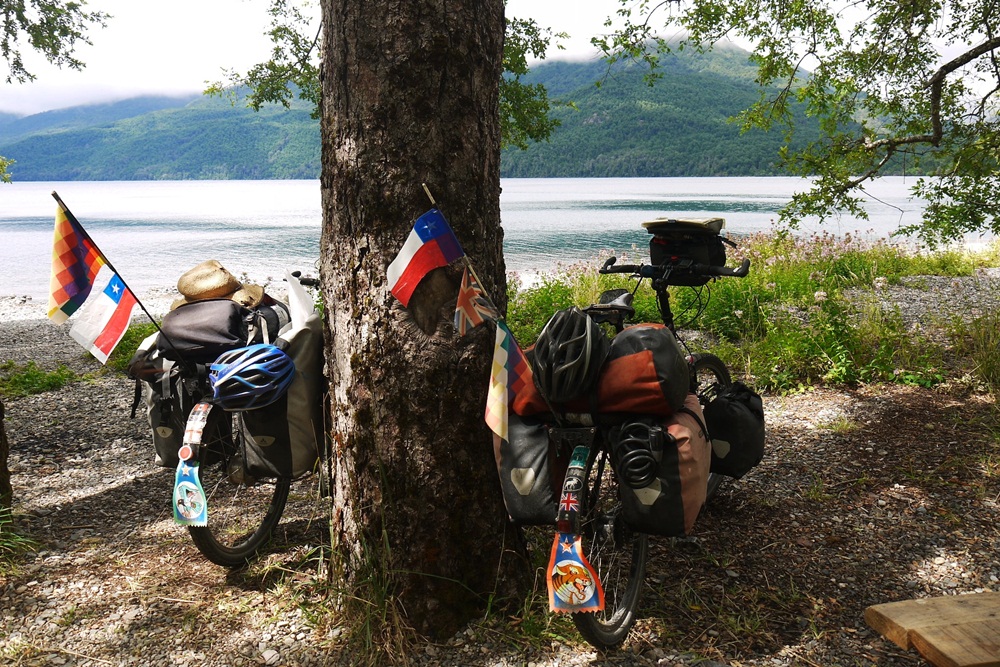
The ferry takes us from Puerto Fuy across Lago Pirihueico and back into Argentina. When we arrive at idyllic Lago Nonthué just across the border, the sun finally shows itself…
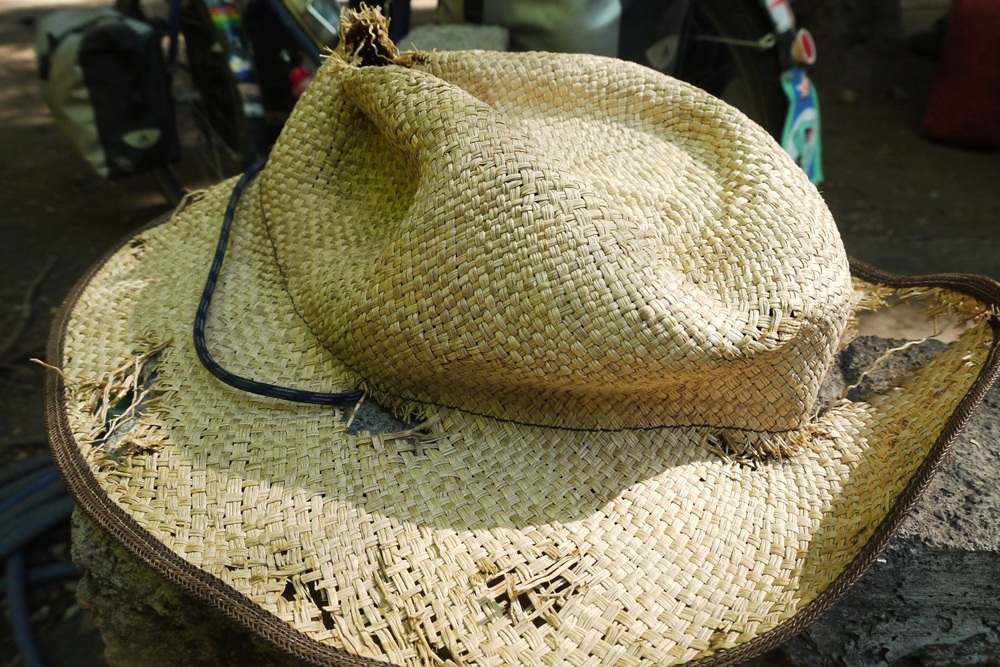
…where it is time to say goodbye to my faithful but battered old hat, with me all the way from Cuenca in Ecuador (May 2013).
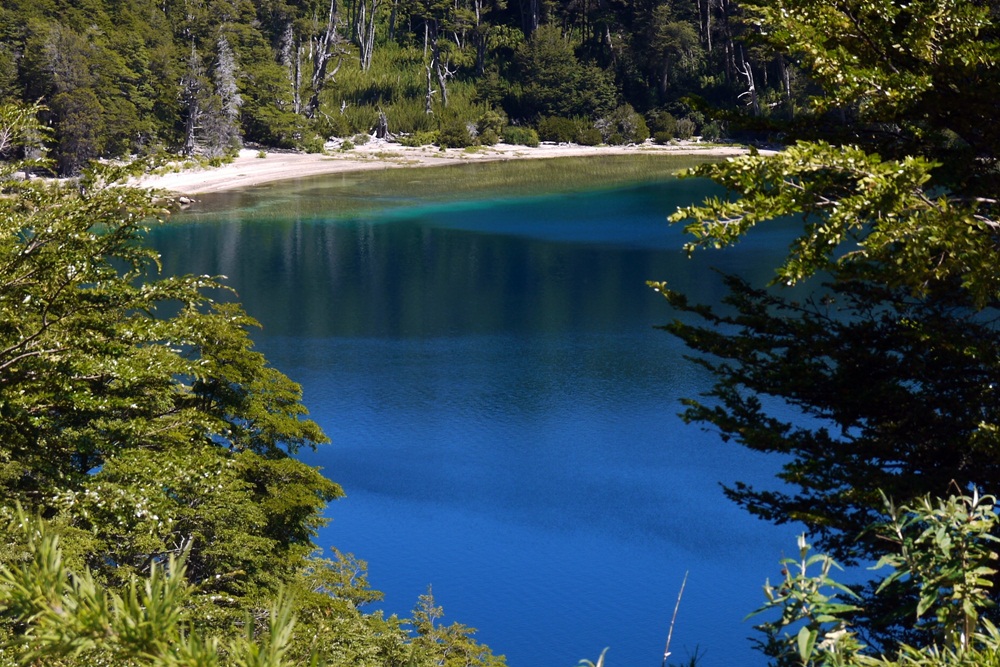
…until crystal clear Lago Espejo (Mirror Lake) convinces us to stop riding early and jump into the water.
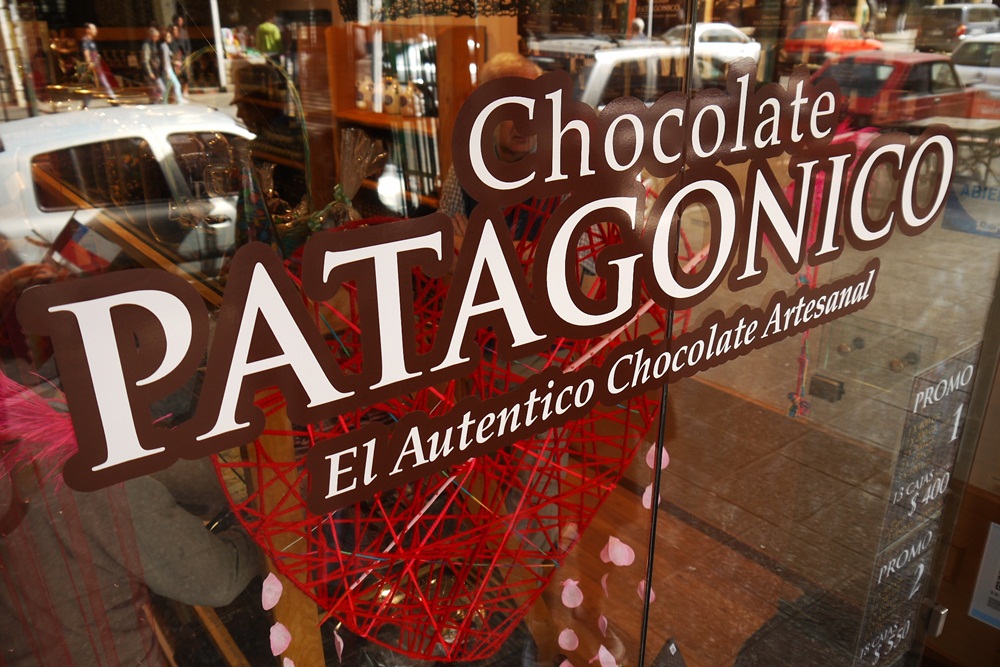
But there is an uglier side to this area – chocolate shop Swiss-style towns like Bariloche sometimes make the lake district feel like it’s a bit of a circus…
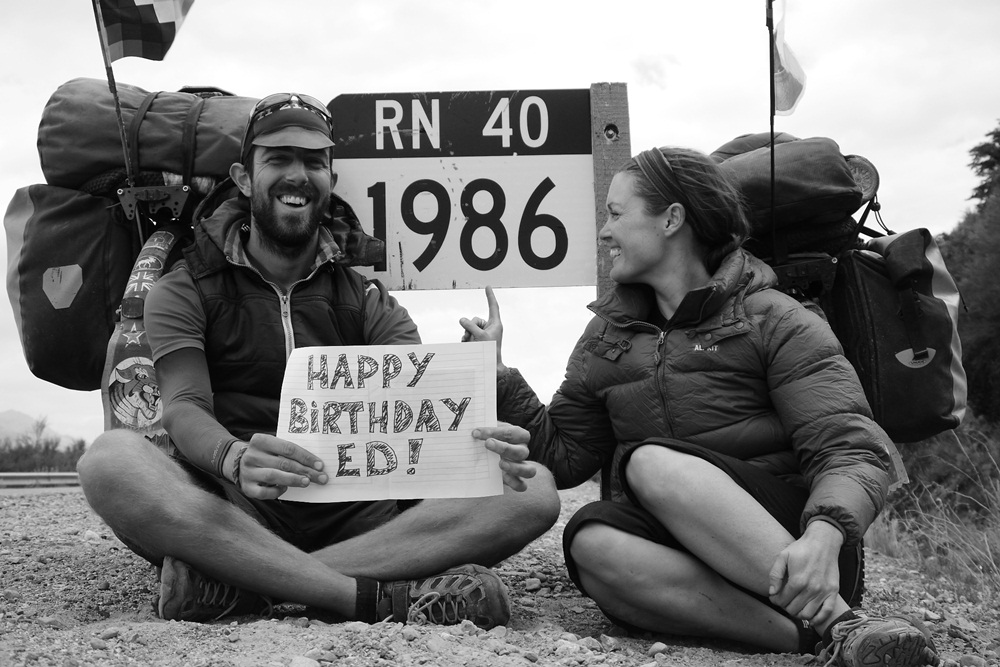
Back on the road, we are heading for the less-visited towns of Esquel and El Bolson, stopping along the way to “create” a birthday card for James’ brother Ed. A handily placed road sign with the year of his birth, a hastily prepared poster, a tripod and hey presto we’ve got ourselves a card!
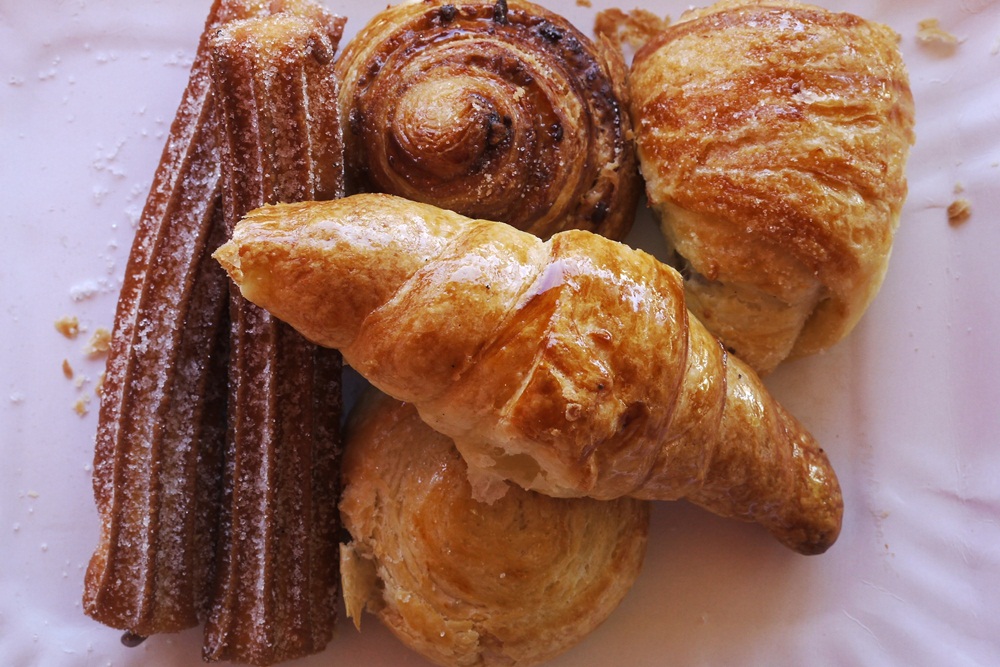
…true to form, we seek out the bakery. Facturas are mini pastries to be found in every Argentine bakery in Patagonia. The quality varies but in Esquel we hit the jackpot.
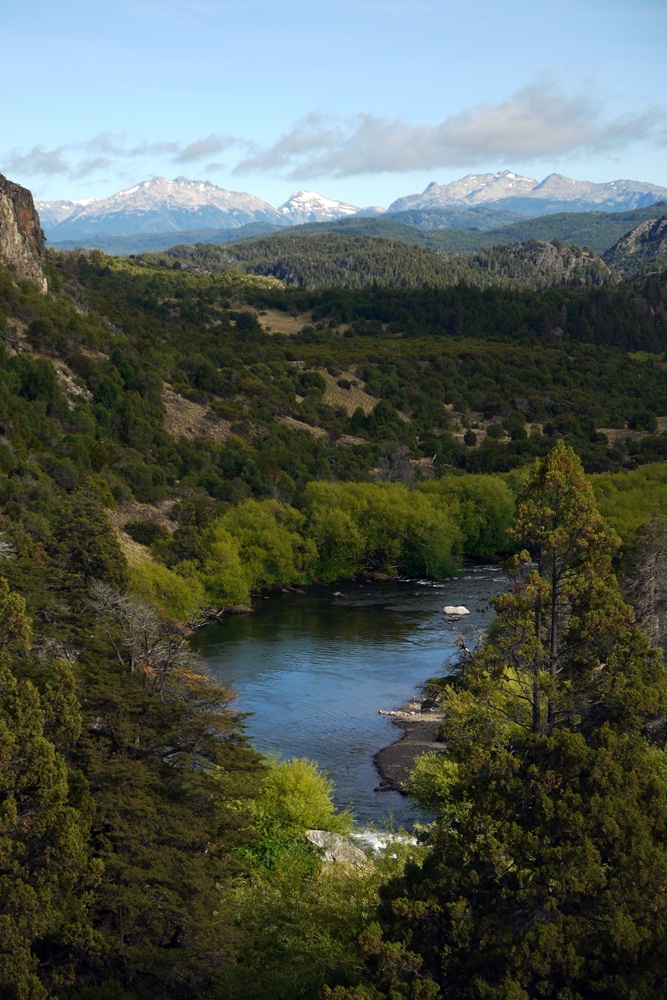
Time for another detour and we choose a route to avoid roadworks at Futaleufu, the traditional border crossing for the Carretera Austral which takes you back into Chile. Keen to avoid the gravel, dumper truck mayhem we have been hearing about we used Skyler’s Off Route blog to plan a more picturesque and fun-filled route.
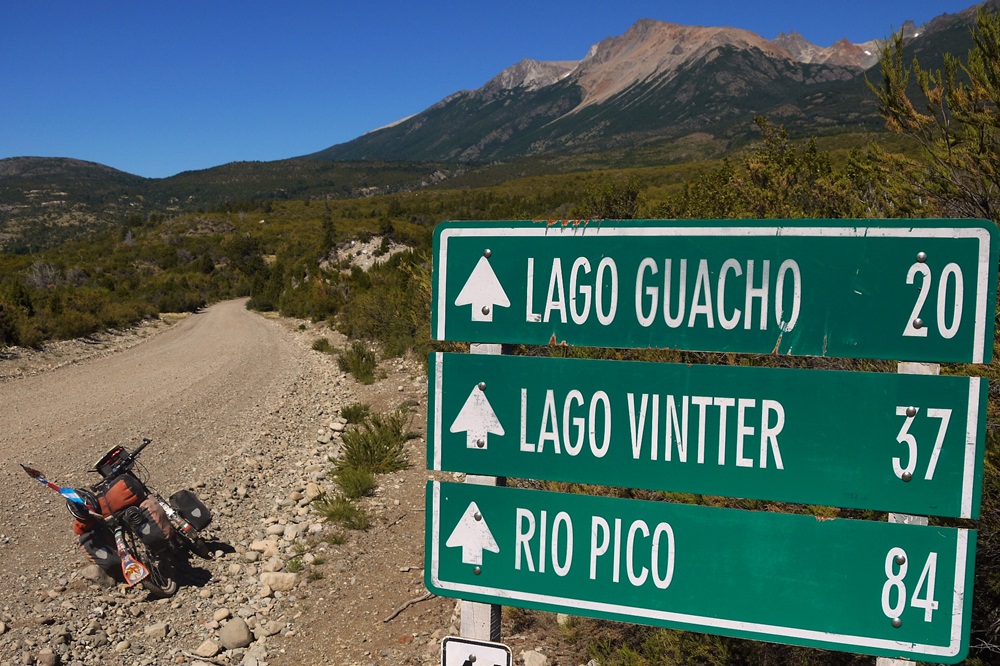
It’s a route that takes us along dirt roads, past forgotten lakes and through plenty of gates to our destination of the Chilean border crossing at Lago Verde, just a day’s ride from the fabled Carretera Austral at La Junta.
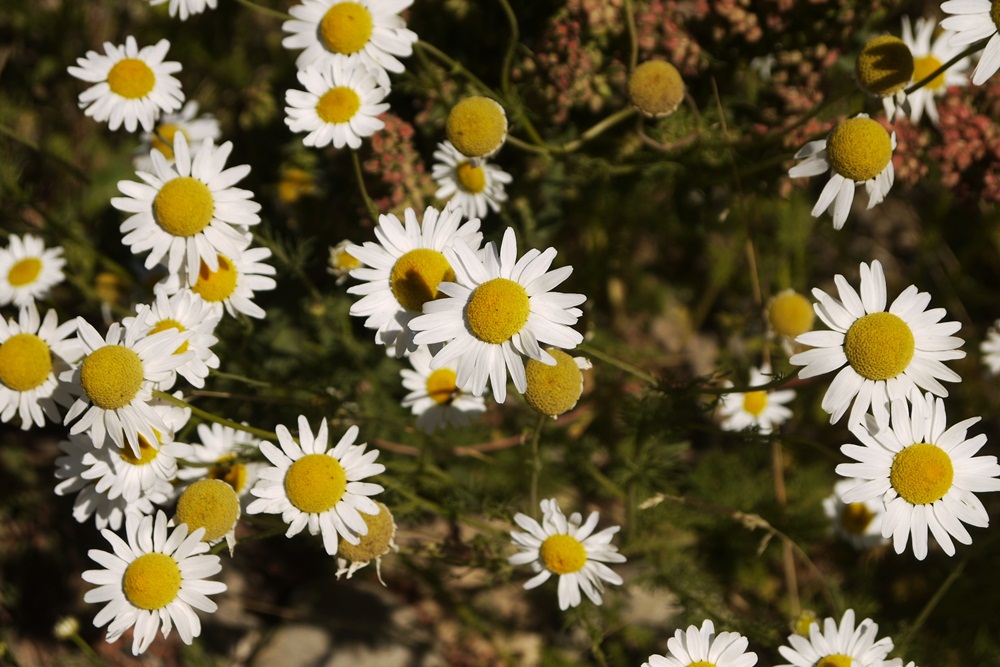
…and pretty little daisies which, I learned after all this time in Latin America are called margaritas. I will never look at a tequila cocktail in the same way again.
We reach Lago Vintter on a stormy day. The wind blows caps onto the lake and all of sudden we feel we are by the sea.
At the end of that zig-zag lies a village that used to be known as Las Pampas and is now called Doctor Atilio Oscar Viglione. Thankfully our generous host that evening has a much more manageable name: Aldo. Head of the local police Aldo wastes no time in taking us in, giving us a bed, plying us with tea and then providing the tastiest indoor bbq I think we will ever eat.
Saying goodbye to Aldo, we start on one of the most enjoyable days we’ve had in a long time. We only clock up 30km, slipping and sliding across rivers and through gates but it’s challenging, remote and beautiful…in all the right doses.

The stunning Lago Verde awaits with a prime camp spot but before we get there, refuelling is needed…
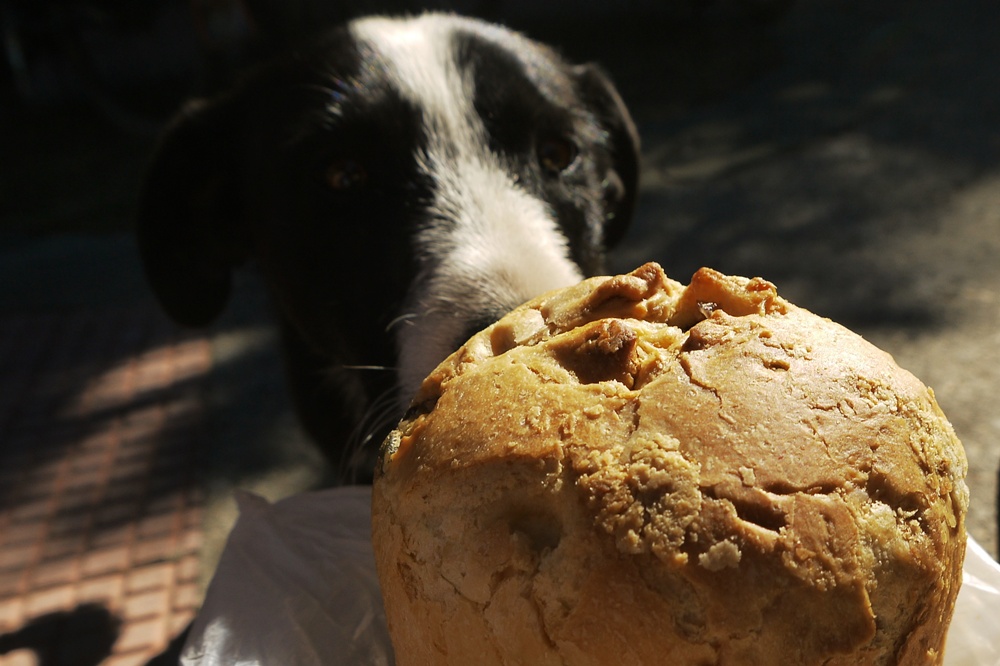
…Aldo has slipped a homemade cake into our panniers and this local hound knows just as well as we do that it’s a tasty snack. What he realises much later to his dismay is that cyclists don’t share!
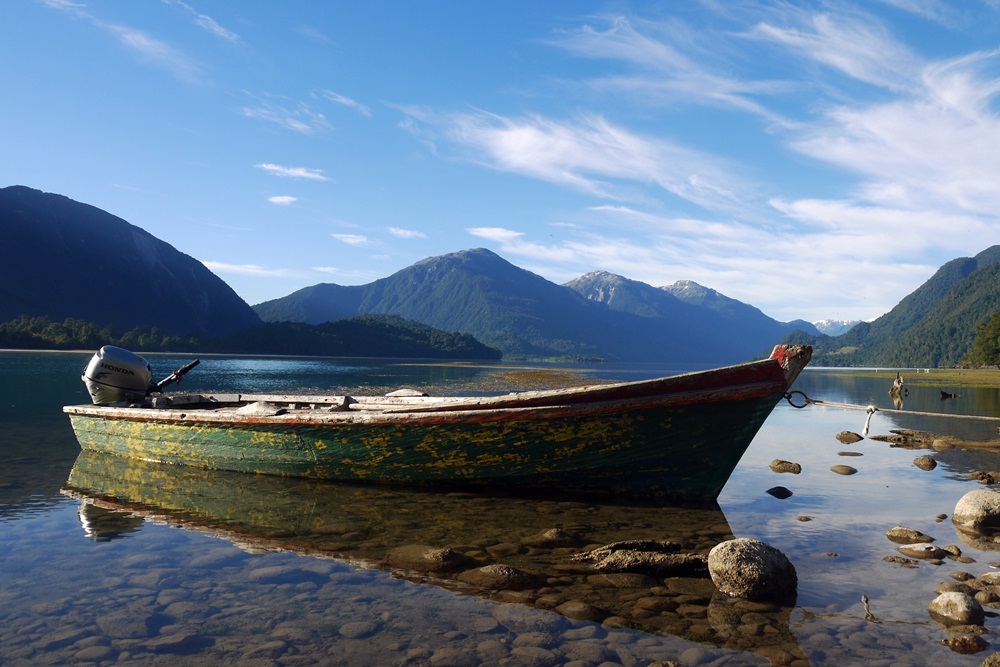
…and our final camp spot before we hit the Carretera Austral? Why at a lake of course: this time, the serene Lago Roosevelt.
La Carretera Austral
March 15th, 2014
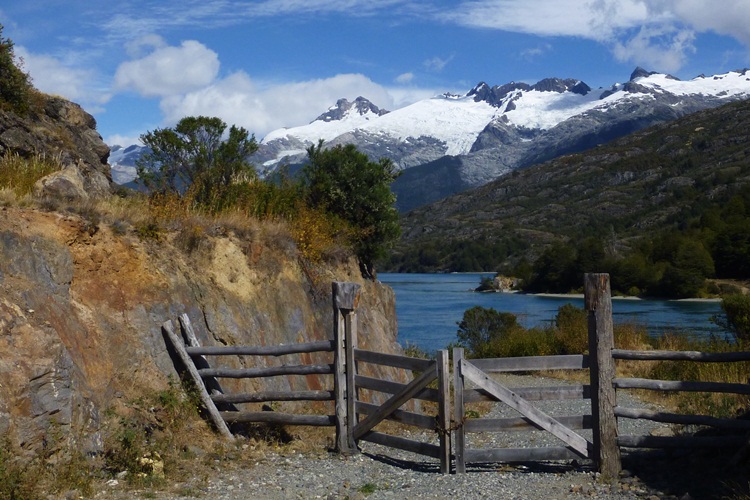
La Carretera Austral: undeniably beautiful but – to coin an Al Humphreys’ book title – “There are Other Dirt Roads”…
It’s almost impossible to write anything about the Carretera Austral without lapsing into full-blown cliché. This, after all, is another of South America’s iconic rides, the much-touted “best dirt road” on the continent, stretching 1000km into the wild heart of Chilean Patagonia (see, I’ve done it already). And on paper, it had all the ingredients we love rolled into one: dirt, isolation and unspoiled natural beauty. So why then did I ride into Villa O’Higgins at the far end of the Austral feeling, well…slightly anti-climaxed? Relieved to have got it out of the way rather than re-invigorated and inspired?
At the time I put it down to a simple case of travel fatigue, as my gaze inevitably turned inwards and the senses began to shut down towards the end of a long trip. After all, the Austral did have some undeniably special moments: our first glimpse of the turquoise Lago General Carrera in the morning sun, following the roar of the Rio Baker towards Cochrane, or simply camping wild night after night in perfect silence. But still, as beautiful as it was, something was missing.
I thought back to some of the dirt roads we had ridden further north in South America, in Colombia, Ecuador and Peru; the ones we already talk about as the “golden days” of this trip. What made them so special? I realised that a large part of it was the lack of hype factor. If we had stumbled across the Carretera Austral in the way we stumbled across many of our favourite roads, then it would have been a different experience. Instead, we already had a clear idea of what the Austral was going to be like in our heads before we set foot on it – and that’s pretty much how it was: predictably beautiful. No surprises, good or bad.
Of course, that’s no fault of the Carretera Austral. It shouldn’t really have come as a surprise that riding one of the most hyped routes in the world, along with half the cycle-touring population of South America, would be something of an anti-climax. You’d have thought that we’d have worked out what makes us tick by now. And I think we have – but the trouble is, it’s actually quite hard to swim against the current and completely turn your back on these “must-see” routes. Try telling another cyclist that you’re not going to bother with the Carretera Austral because “it’s a bit clichéd” and watch their eyebrows go skywards.
But ultimately I’m glad we rode the Austral. Partly because it showed us an undeniably beautiful part of Chilean Patagonia. But also because it re-affirmed to me everything we’ve learned about how and why we love to travel. Our best moments on this trip have been the least-expected ones, not the “don’t miss” ones. That doesn’t mean we deliberately side-step the “must-see” sites – in fact, we’ve seen almost all of them along our route. It’s just that, on their own, they leave us unfulfilled.
We’ve realised that for us, surprise is the magical travel ingredient. The best part of travelling is to be surprised – and definitely not just by landscapes, but also by people and places. Take away this element of surprise and travel becomes little more than a predictable tick-list. Does X Wonder of the World look like the photo? Yes, tick. Next…
So where does that leave us as travellers? In a clique of tedious traveller-types obsessed with a quest for “authenticity”? Maybe, but I hope not. The world might be becoming more homogeneous by the day, but surely it remains too diverse, too rich in these moments of surprise and discovery to be reduced to a list of “1000 places to see before you die”? By all means go and see them. Ride the Austral. But then throw away the guidebook, pick a place you’ve never heard of, and go and explore.
And the best thing about travelling by bike? That it makes it so easy to break free from the tick-list approach to travelling, to just throw a dart at a map and go. Because for every Carretera Austral, I guarantee there are a hundred other dirt roads out there waiting to surprise you.
James
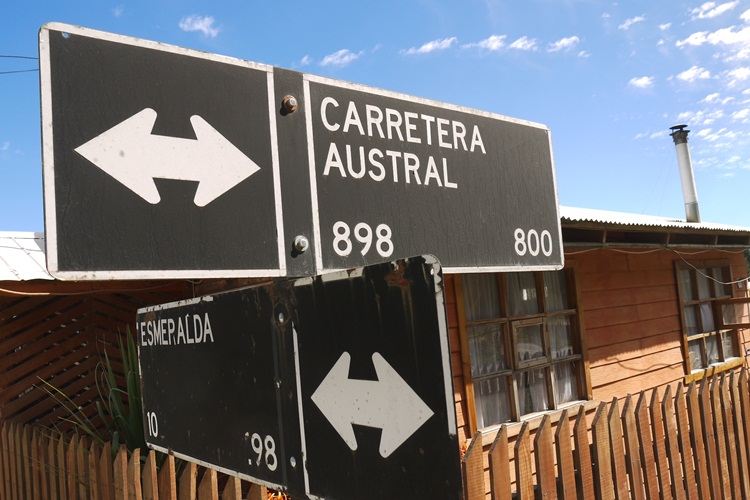
We join the Austral at La Junta, after a beautiful and remote border crossing from Argentina via Las Pampas and Lago Verde (highly recommended). After two days in which we’d seen less than five cars…
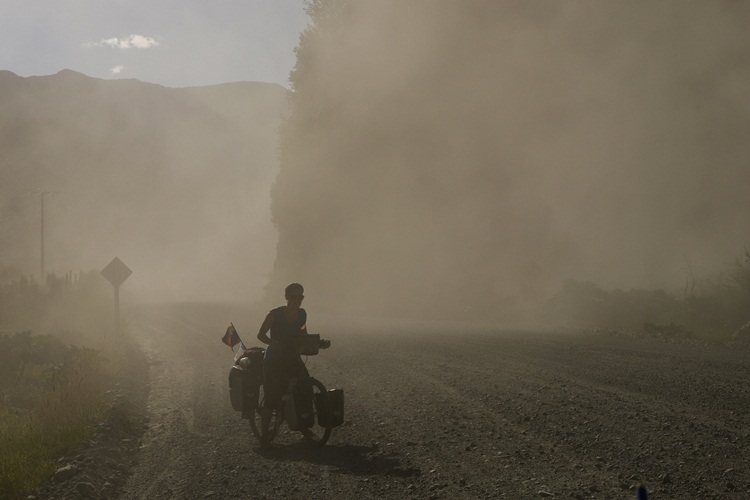
…the Austral is a shock to the system: racing, honking traffic which leaves us caked in dust. This is definitely not the dirt road of our dreams; this is a dirt highway where it seems that goodwill and patience towards the streams of pilgrim cyclists has run out long ago.
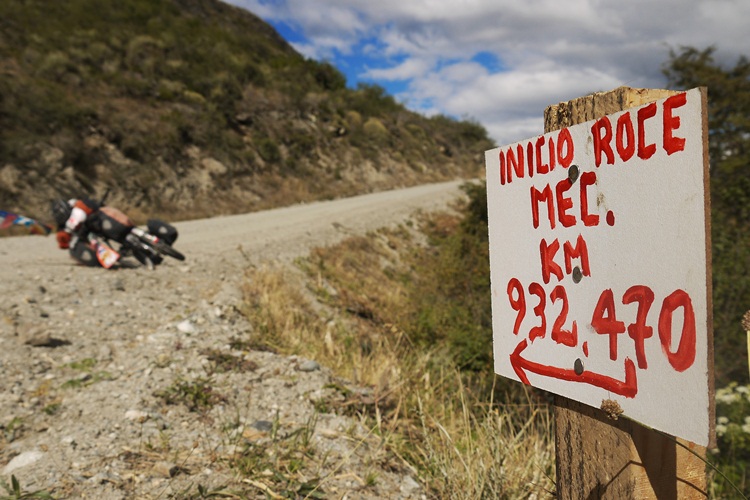
In fact, much of the middle section of the Austral around Coyhaique is now paved, and undoubtedly all of it will be before too long. Until then, meticulous roadside notes detail the never-ending task of keeping the road passable – or maybe lay the blueprint for the asphalt to come.
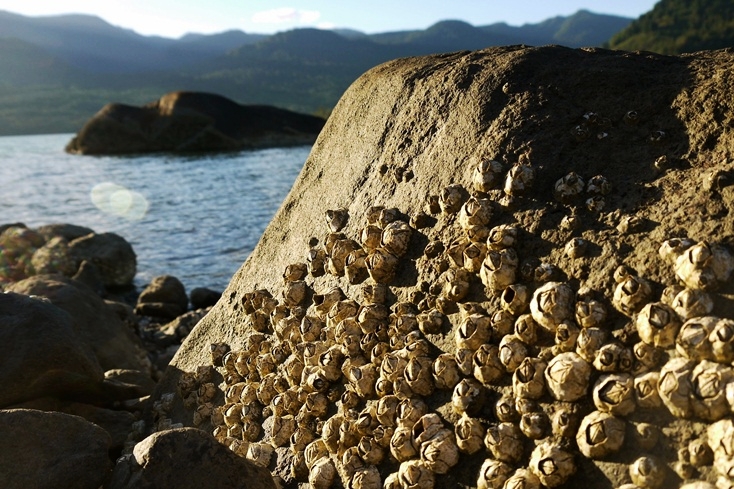
…duly noting the clues that this is actually a sea loch and so tidal. We pick a grassy ledge set back above the beach, and watch the dolphins swimming in the bay while we cook dinner. Idyllic. As we drift off to sleep, I utter the immortal line: “Listen to the dolphins, they sound so close”. Which is because they were – in fact they were probably swimming laps around the tent by this point…
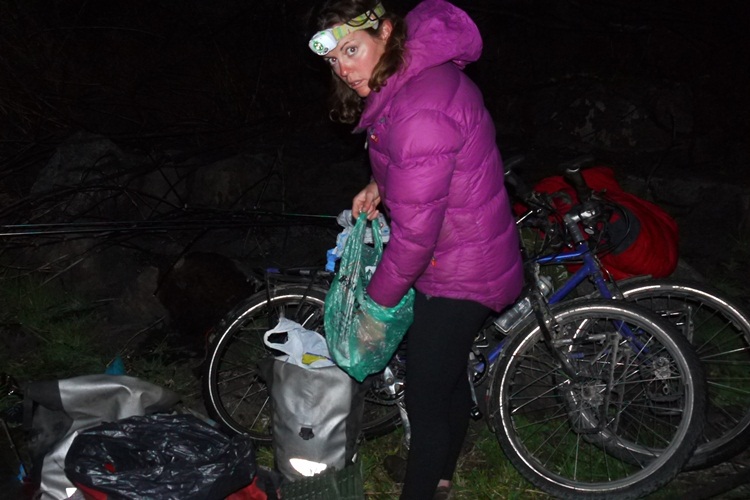
…because by 2am, we awake to find our sleeping mats (and all our other possessions) bobbing gently in 20cm of rapidly rising salt water. It seems we might have mis-judged the tides. Luckily, we manage to rescue everything before it floats off into the Pacific and re-pitch our tent on higher ground. We shiver into our soaked sleeping bags and hope for a sunny morning.
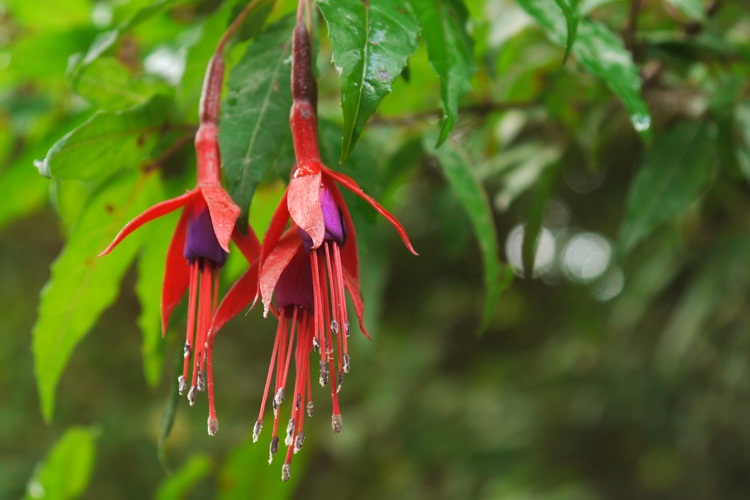
Of course, we wake to lashing rain. A tough climb up and over the Cuesta Quelat keeps us warm though, and finally the rain stops and the fuchsias come out in all their magnificence.
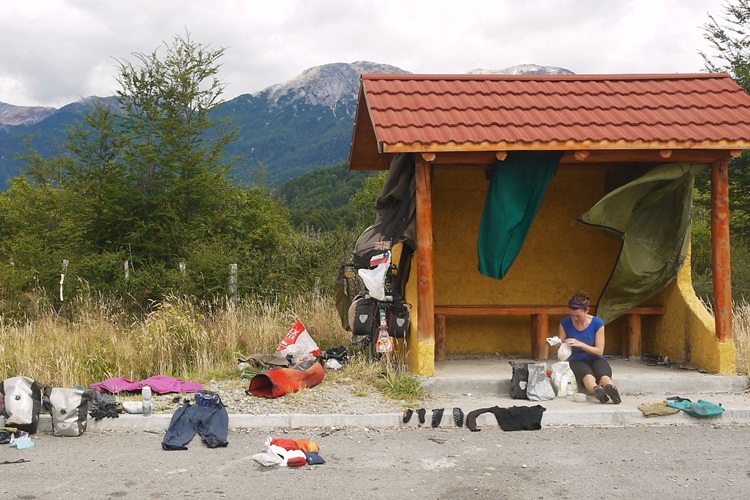
Next morning the sun peeks out, the wind blows, and we convert a bus shelter into an impromptu laundry.
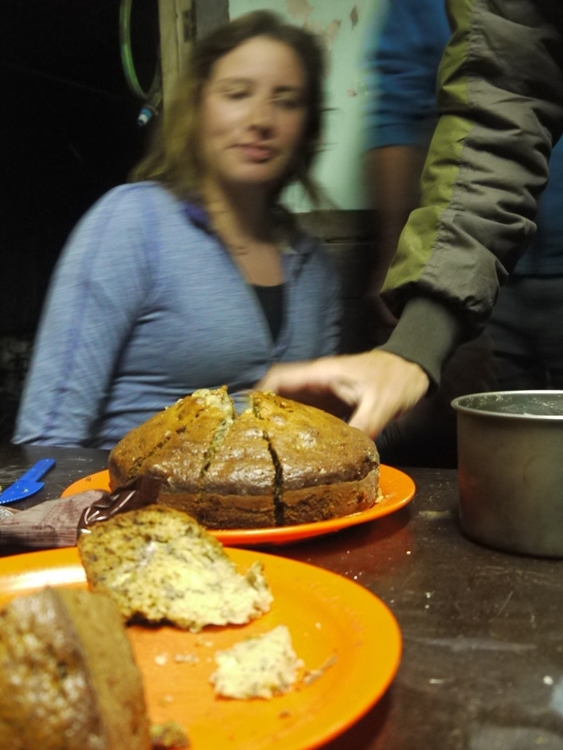
…and Stephanie from Quebec bakes a delicious cake in anticipation of the arrival of the Alaskan posse. Eventually birthday boy Andrew and Kanaan roll in – apparently after a rare interlude on bikes. It’s been a long time since we saw them back in La Paz, and we catch up on all things eggs and check on progress with their English pronunciation lessons (conclusion: a hopeless cause).
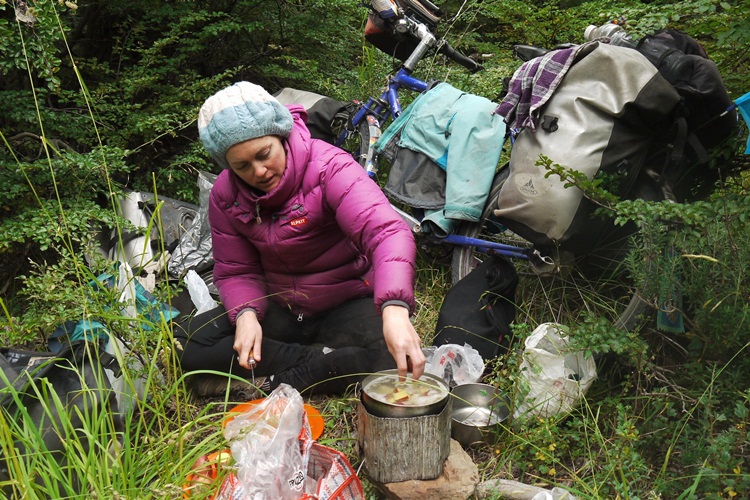
In Coyhaique, we camp on the lawn of Jeff and Loreta, new friends we met up at Lago Verde. They receive us with open arms and hot food, and it’s hard to tear ourselves away…but eventually we do, and it’s back to more rustic camp spots in the bushes like this one.
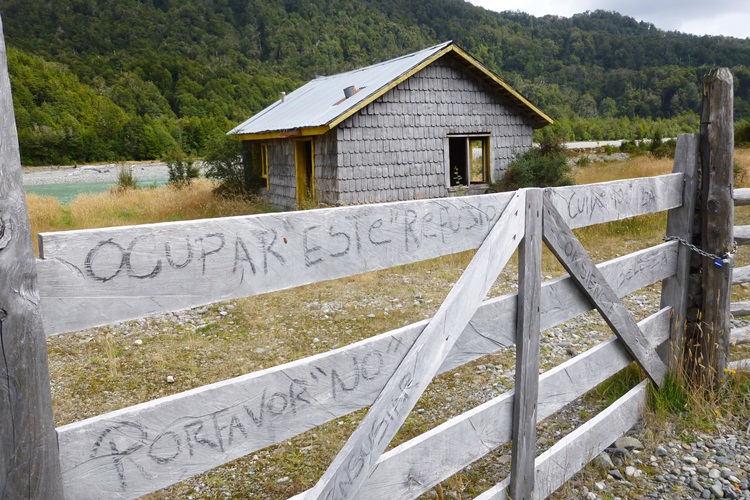
The Carretera Austral is littered with abandoned houses and sheds like this one, many of which have been adopted by cyclists and walkers in dire need of a roof for the night. I like the fact that in Patagonia, these places are self-maintaining, cared for and respected by the people that use them: “If you use this refuge, please don’t leave it dirty” is inscribed on the gate.
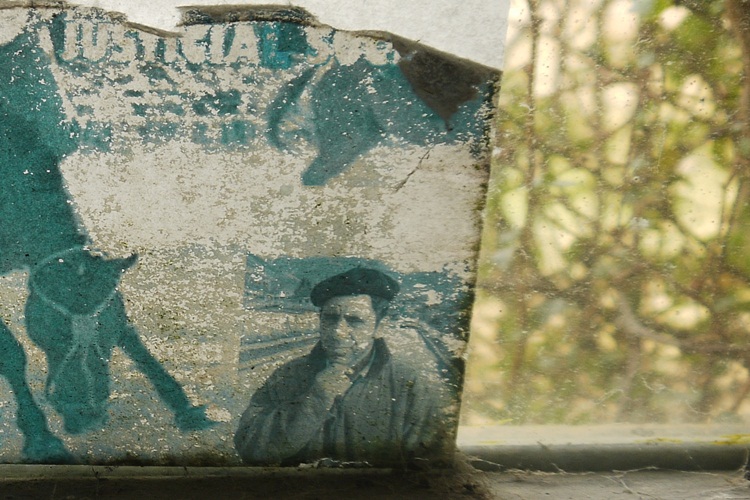
…and inside a faded sticker of a gaucho from a local rodeo competition alludes to its past life as a home.
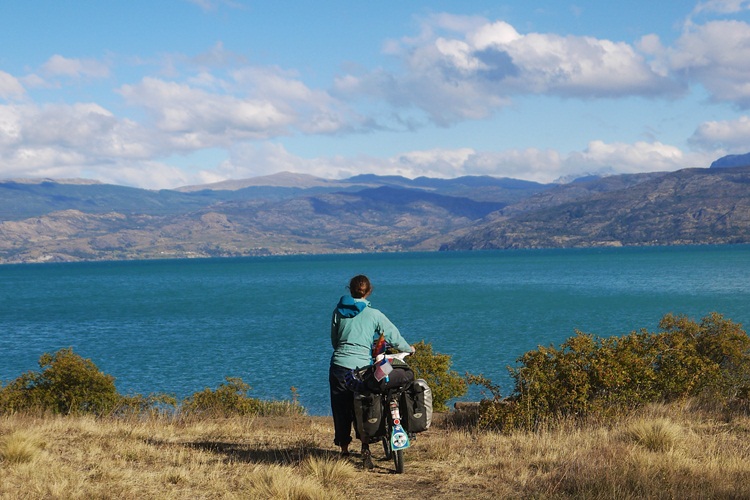
…but if that’s not yours, then just head down to the nearest bay for a picture-perfect camping spot.
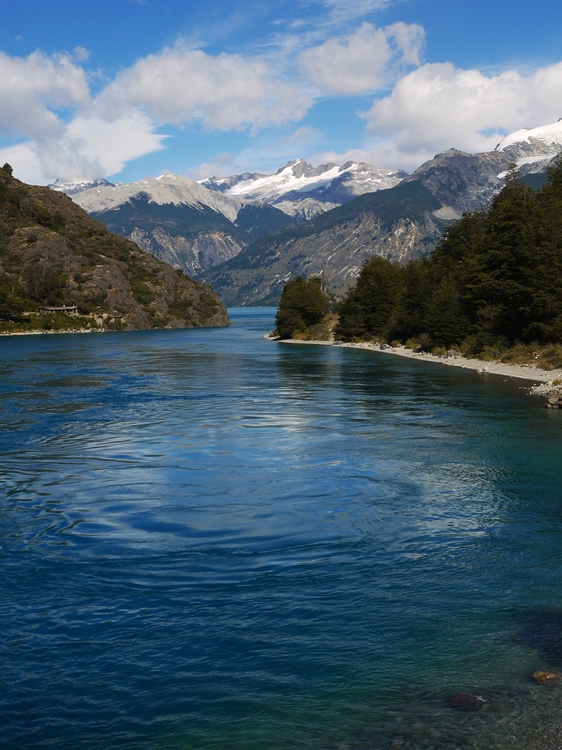
This is the pristine Patagonia I always dreamed of; turquoise rivers and snowy peaks. Maybe only its remoteness has kept it this way for so long…
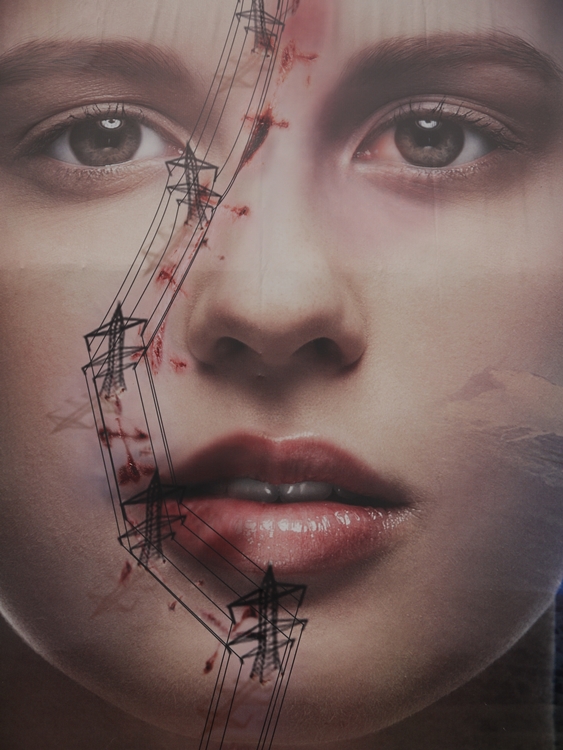
…although of course, it’s only superficial perfection. Patagonia is an immense store of natural resources, not least of all water, and there have been long-standing efforts to dam Patagonia’s rivers and create a series of hydroelectric plants. Thanks to the efforts of pressure groups like Patagonia Sin Represas, the latest proposal was recently thrown out…
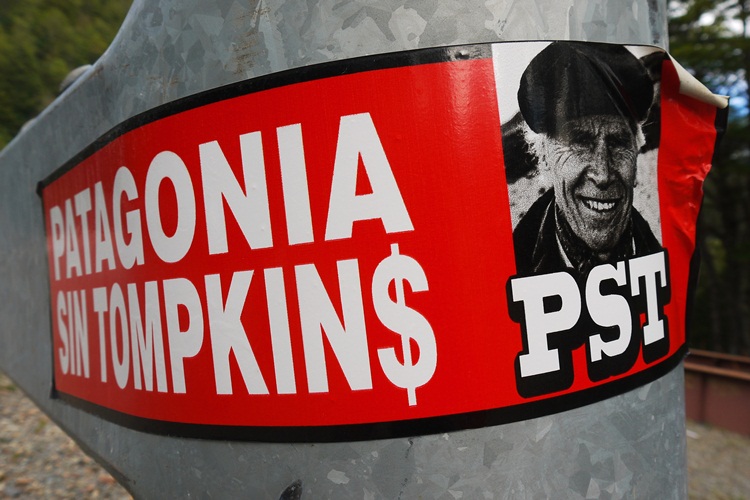
…but no doubt there will be many more to come. It’s become a classic battle of locals against outsiders, with the conservation efforts of North American millionaires such as Doug Tompkins (founder of the North Face and Esprit clothing brands) viewed with intense suspicion.
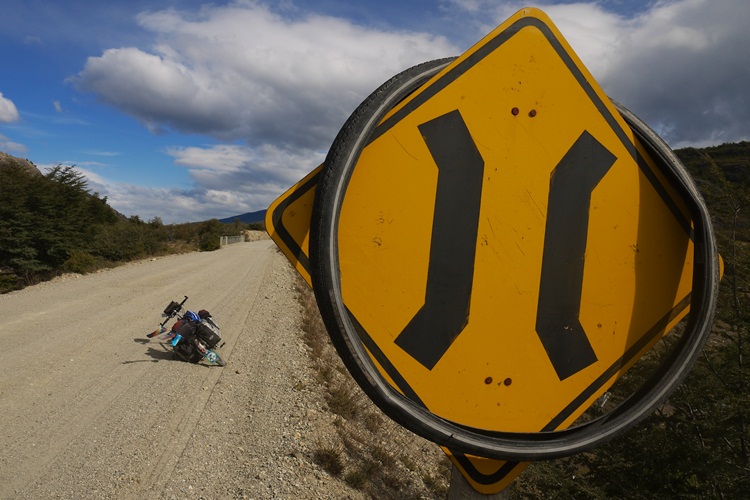
From Cochrane, the traffic slows to a trickle. This is the true dead end of the Austral, with exit only really possible by a combination of boat plus bike/foot/horse. Signs of cyclists are everywhere – from roadside fire rings to discarded spare tyres, left hanging optimistically on road signs.
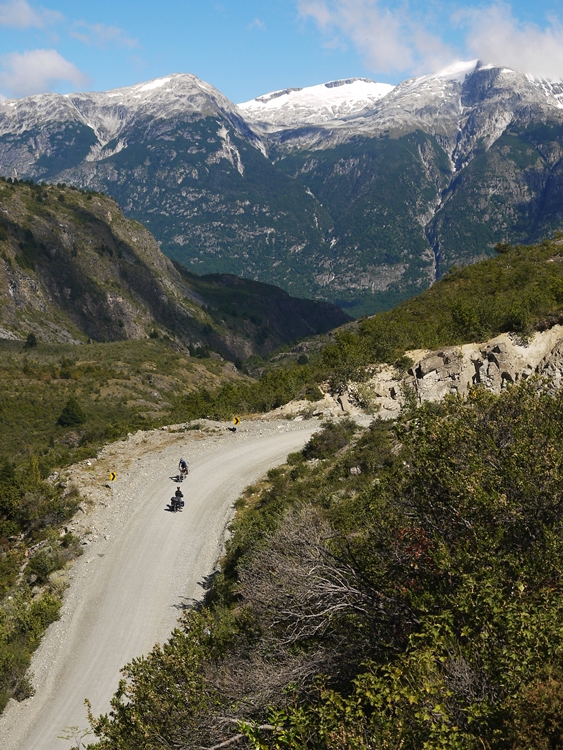
There’s still a trickle of northbound cyclists coming the other way. We meet Mark and Katia halfway up a pass, bearing messages from our friends further along the road (“Hurry up!” was the general gist) in a kind of cyclist pigeon post. As always, we compare notes and swap tips on camping spots and where the next meal might come from – and then it’s onwards, the cycling version of ships passing in the night.
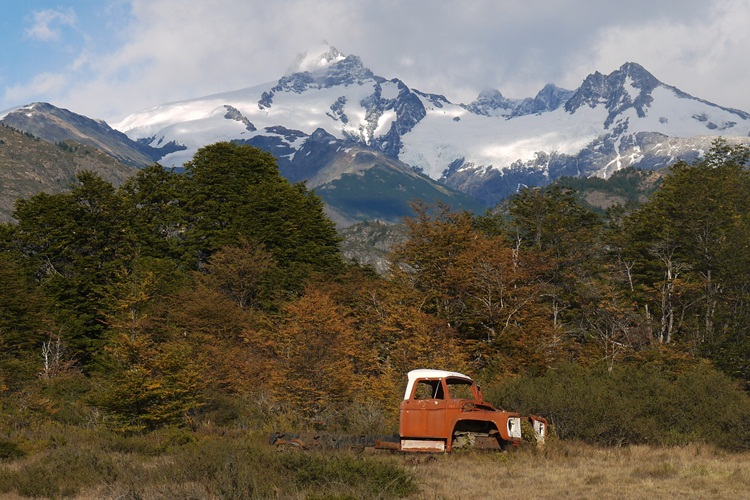
This final section is the Austral at its wildest, and feels like a glimpse into its early pioneer days.
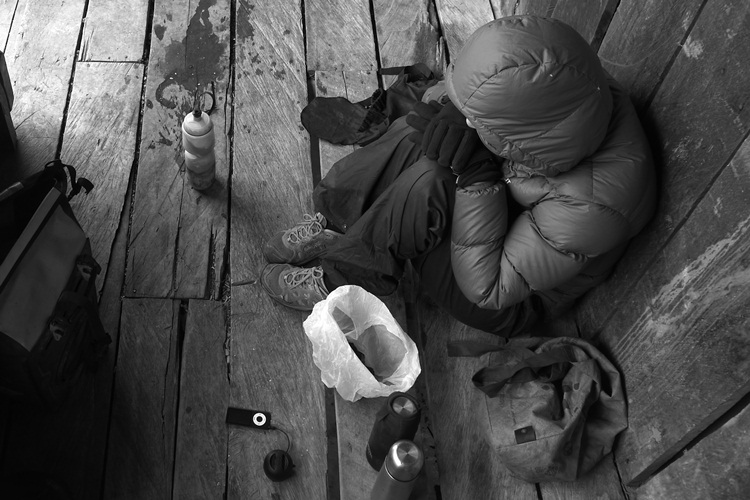
…including onto us. Our lucky run of good weather finally comes to an end, and we are treated to some more typical Patagonian days: grey skies, hanging clouds and driving rain. We ride heads down, stopping when we find shelter to make hot drinks and food.
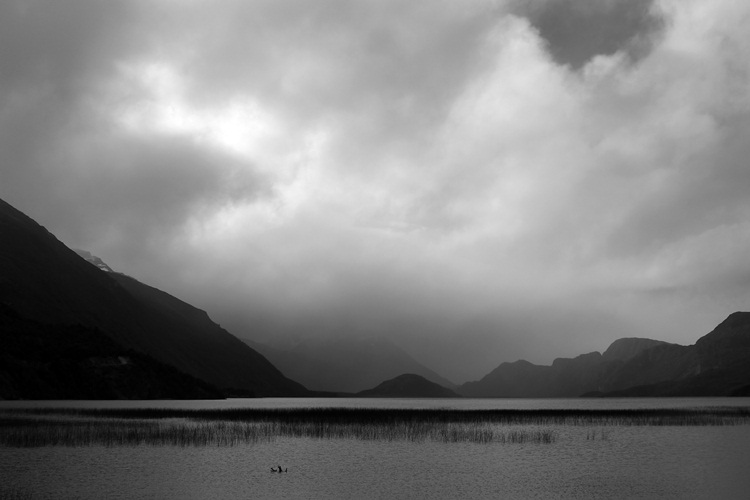
Just as we reach Lago Cisnes, the rain eases. We stop on impulse, just a few kilometres short of Villa O’Higgins…
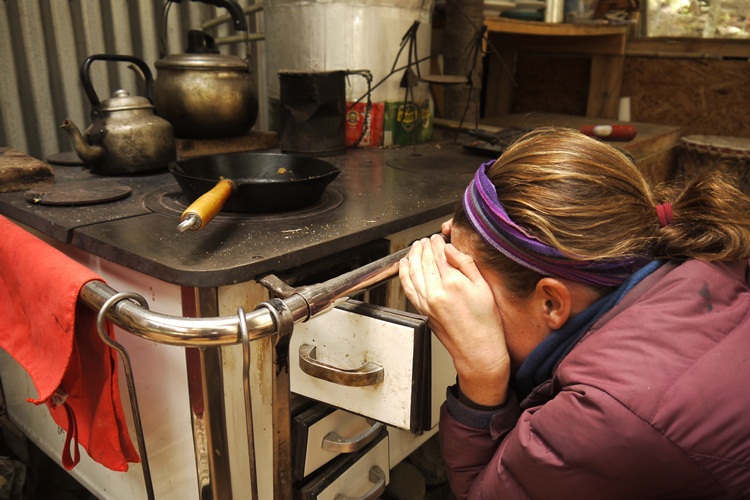
The next day we reach O’Higgins, where we swap the open fire for a stove at the excellent Tsonek Eco-Camp. This is how organised campsites should be: a cosy communal kitchen…
Band of bikers
April 5th, 2014
For the stretch between the end of the Carretera Austral in Chile, all the way to the island of Tierra del Fuego (some 500kms) we barely ever cycled alone. Part of a merry band of bikers, we enjoyed the social riding – the endless banter, the clash and blend of personalities, and of course the food…always the food.
Sarah
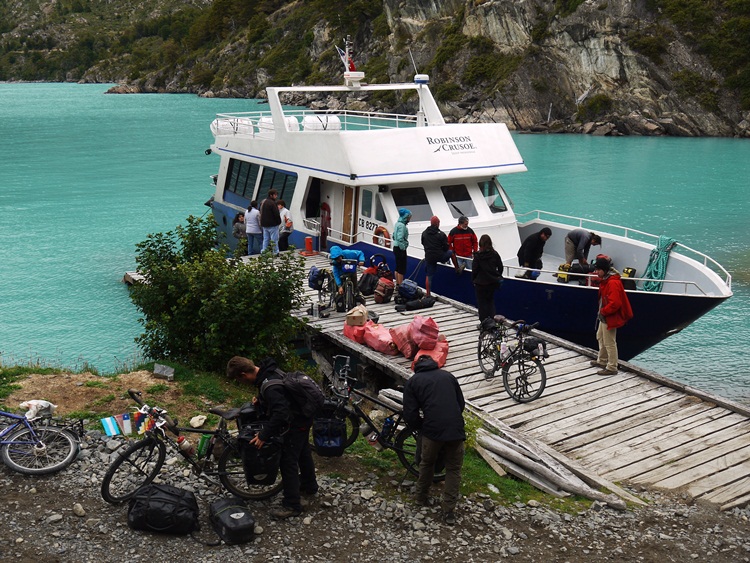
The end of the Carretera Austral is in reality a very dead end, exit to Argentina only being achievable for cyclists and pedestrians. Even for them it’s a bit of a challenge: first a ferry across Lago O’Higgins, then a hike and bike for around 25kms, then another ferry across Lago Desierto and finally you’re in Argentina. We are two of ten cyclists on one of the final ferries of the season.
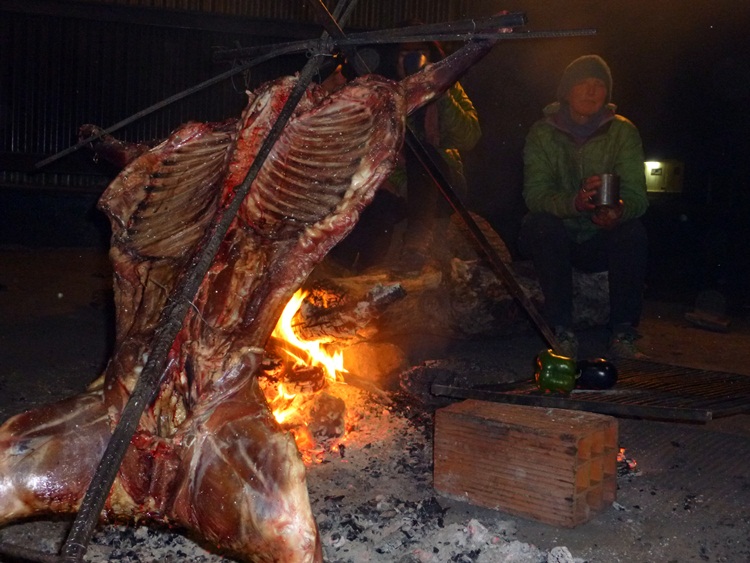
All tired out, we reach El Chaltén and Flor’s amazing casa de ciclistas. Luck would have it that they’re roasting a whole lamb on a traditional Patagonian asador that very night, and so we feast unexpectedly and catch up with old friends – Anna…
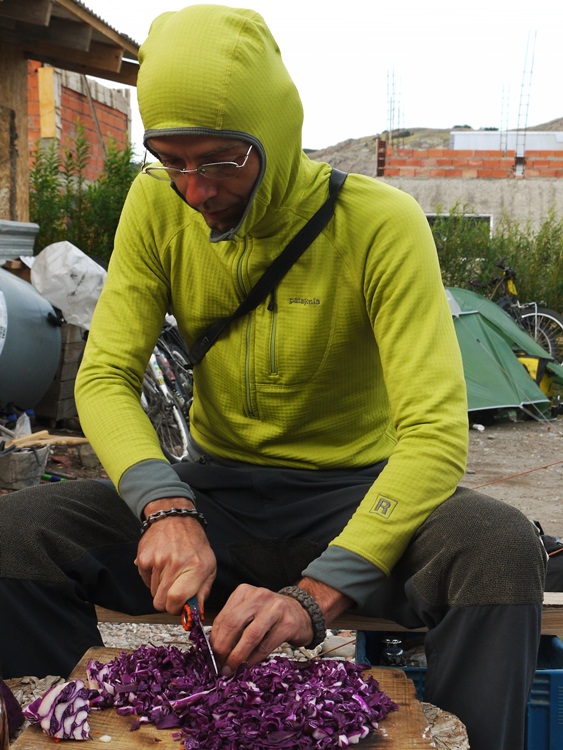
…and Raul. So begins a cooking frenzy that will go on for a whole week – at any one time ten cyclists gather in Flor’s tiny kitchen trying to outdo one another with fresh gnocchi, Argentine buñuelos, stuffed apples, flapjack, Scottish cranachan and more.
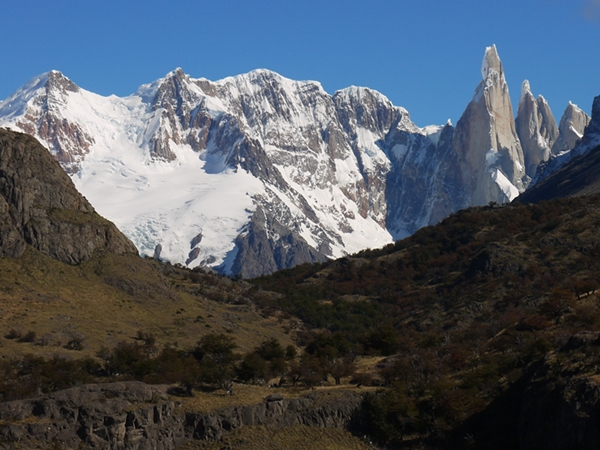
It’s hard to tear ourselves away from the cozy house but the Fitz Roy range, looming directly over town is a good distraction…
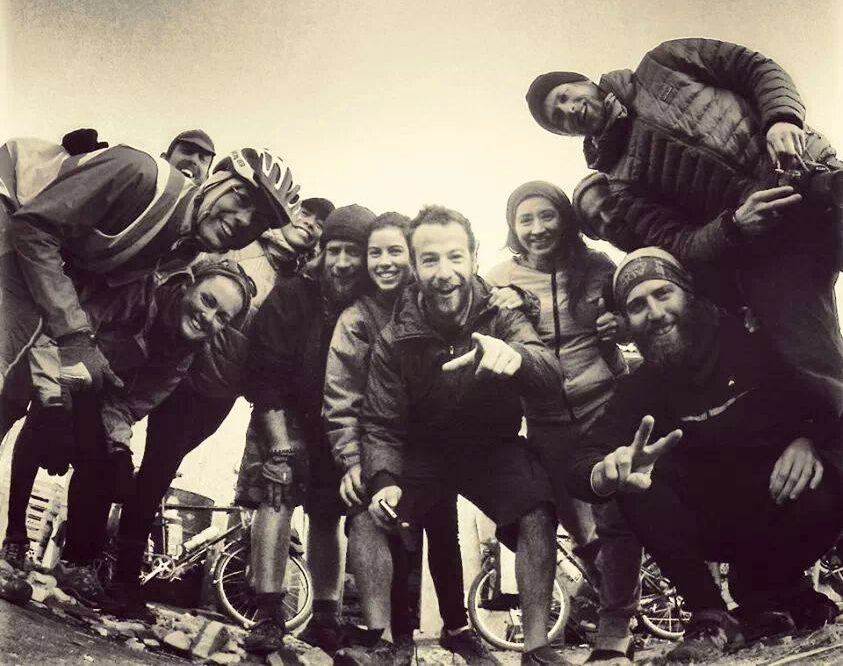
The party gathers for a final group photo (courtesy of Tatan) before thanking Flor profusely for her boundless hospitality…
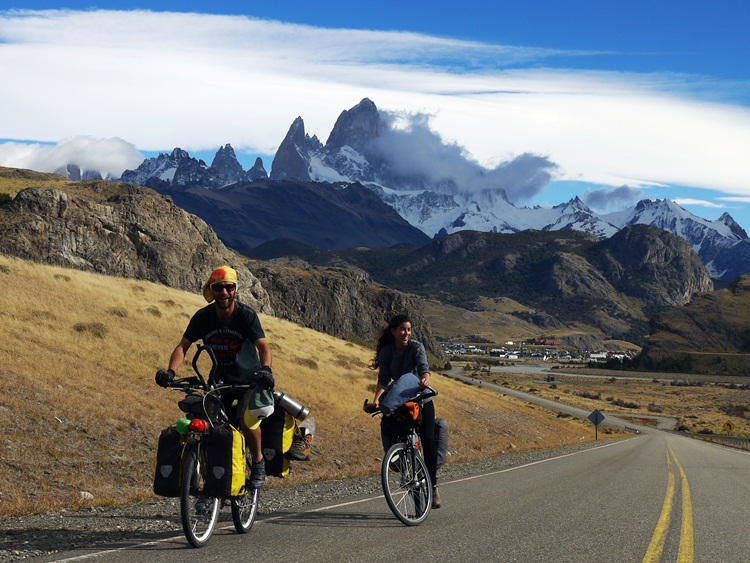
…and we zoom out of town with a delicious tailwind. Tatan and Candela (from Argentina) lead the way…
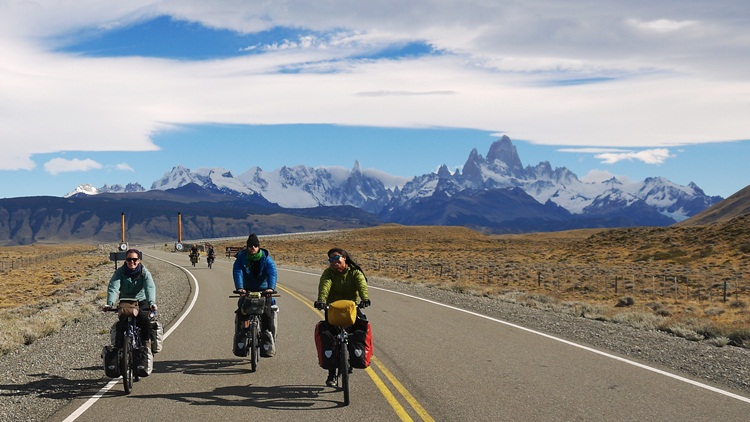
…followed by myself Lee and Heidi, loving the effortless cycling and chatting away. There’s a distinct air that everybody (all ten of these southbound cyclists leaving Flor’s at least) is coming to the end of their trip…
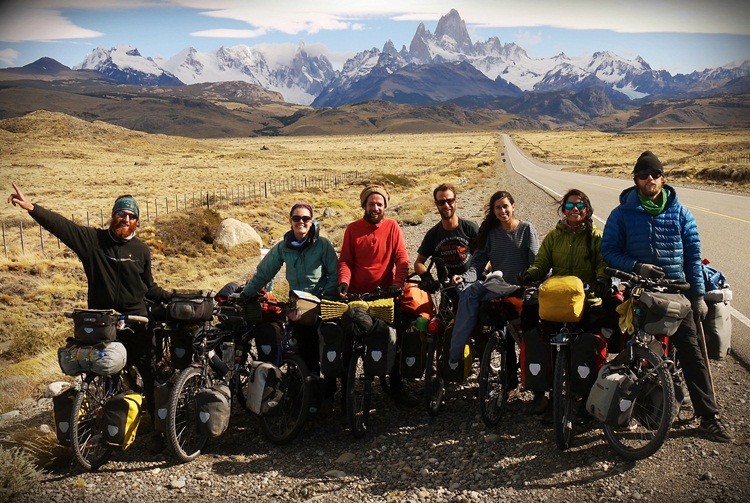
…we can’t help stopping for group photos and babbling on with excitement, mixed with anxiety, anticipation and lots of in-jokes.
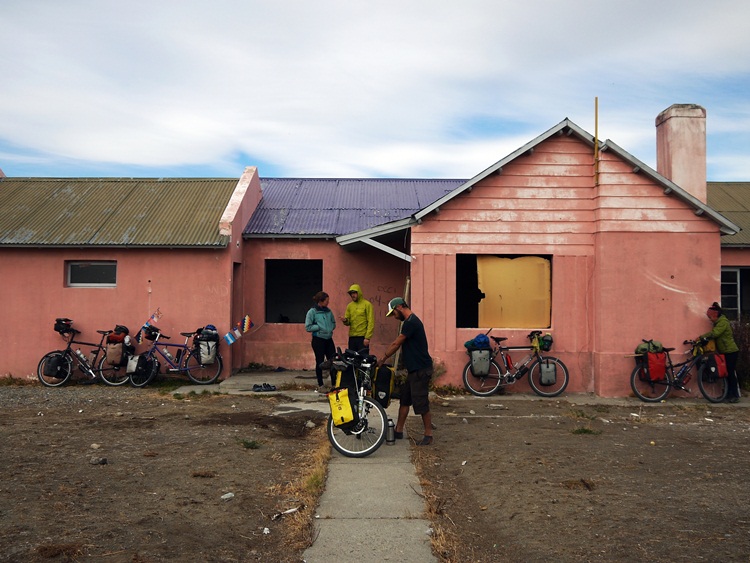
A day’s ride from El Chalten with that favourable tailwind (we covered 90km in just under four hours) brings us to the fabled “Pink House”…
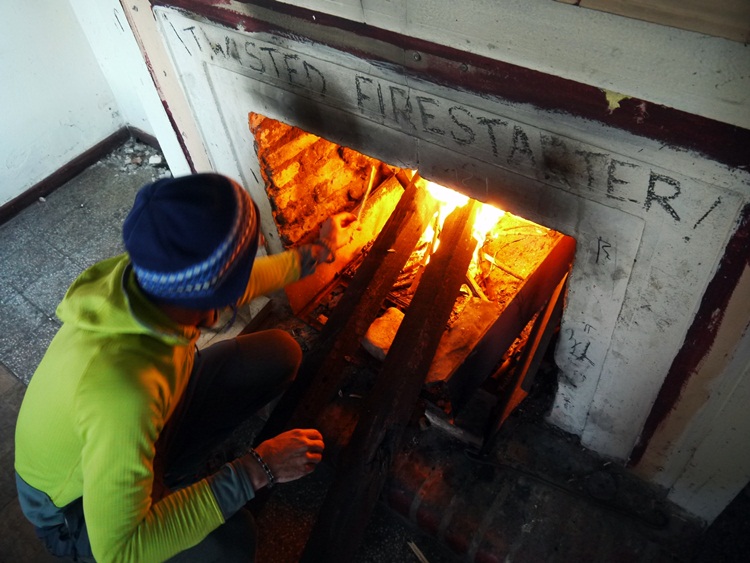
Raul stokes up a roaring fire and we huddle around the warmth, happy to be out of the wind for the night.
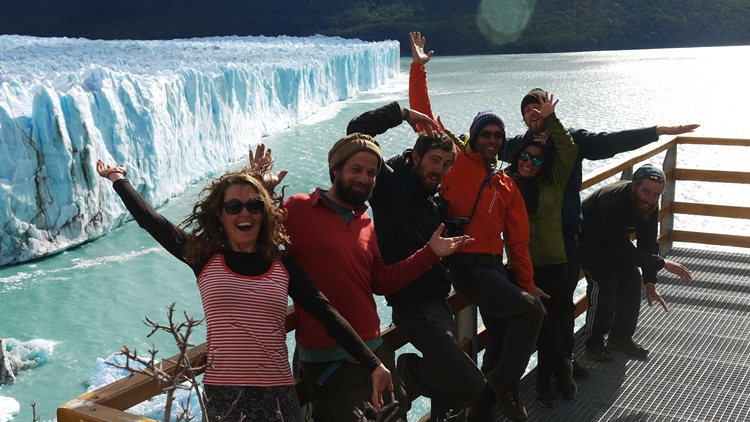
Believe it or not, all these cyclists (plus one who didn’t make it into the photo) managed to fit into just one hired VW Golf to get to the national park…
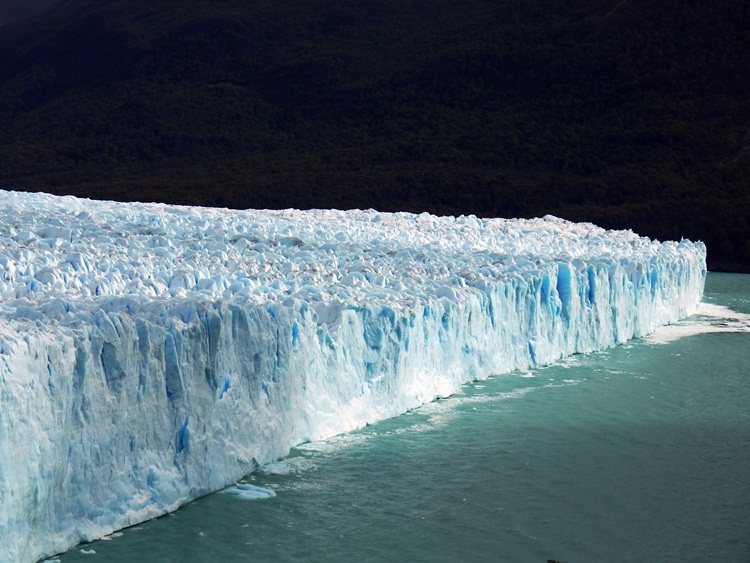
…but the uncomfortable journey was worth it – watching the stunning glacier calve into the lake below…
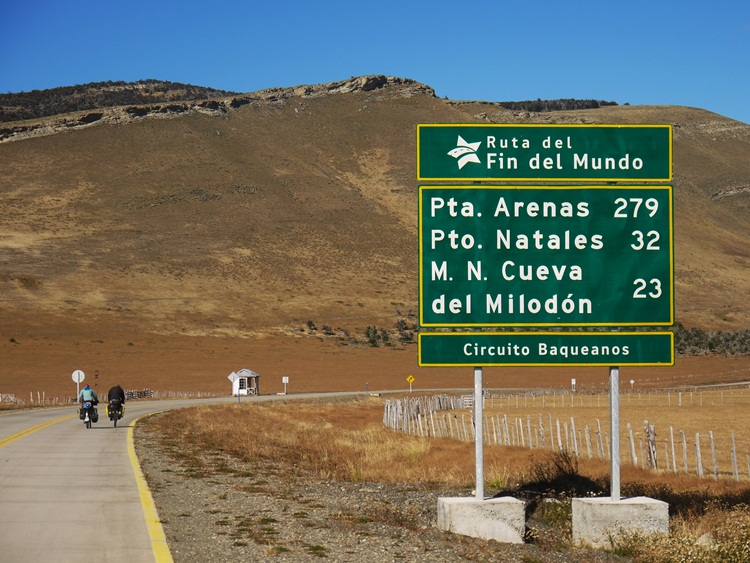
Back into Chile and we feel the end is near – even the road signs say so: we are now following the “Route to the End of the World”.
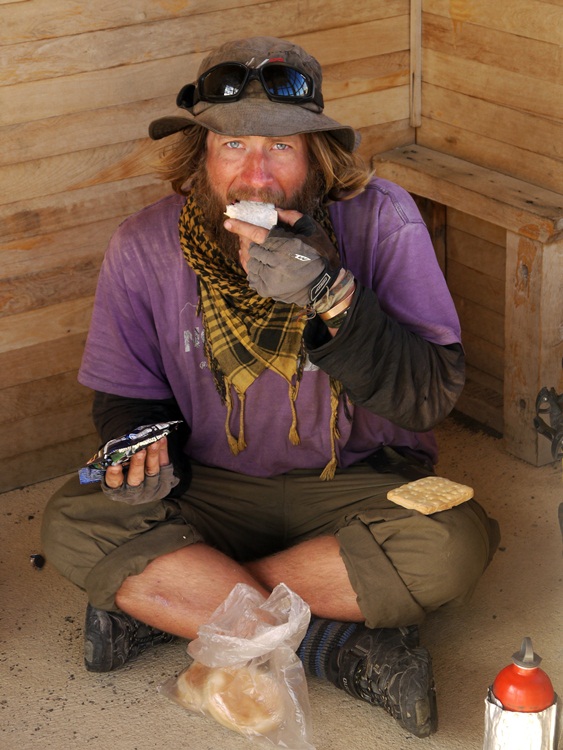
We ride with Andy – fellow Brit and self-confessed hot chocolate addict. Lunching in bus stops we appreciate them anew, as things of beauty: well built, warm and better than most of the Central American hotels we stayed in.
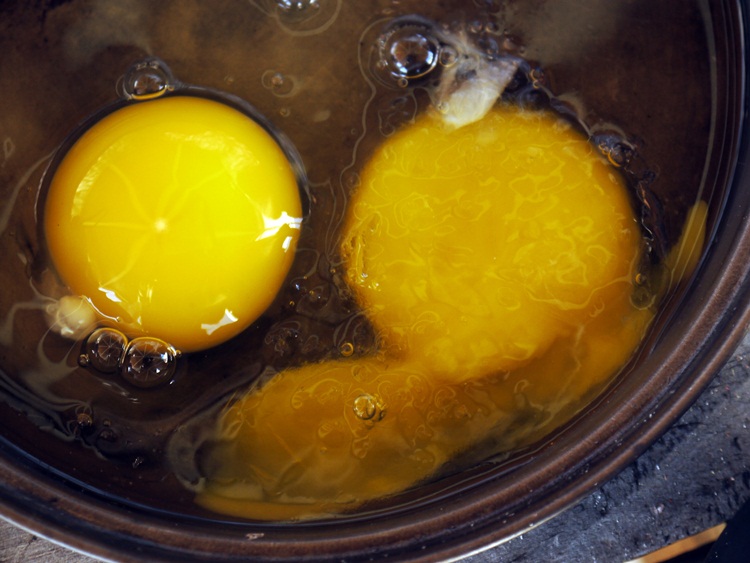
We camp in a playground at Cerro Castillo where it’s so cold overnight, Andy’s eggs are frozen in the morning.
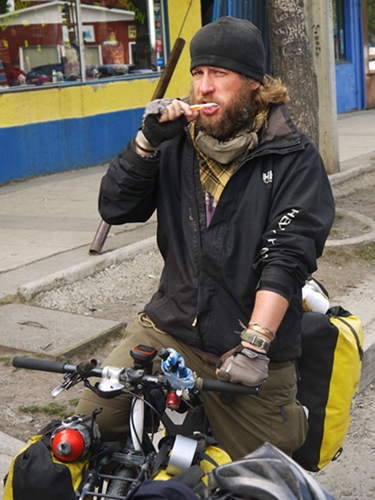
When does the constant movement of cycle touring become normal? Perhaps when brushing your teeth astride your bike in the middle of a busy shopping street doesn’t seem at all strange…
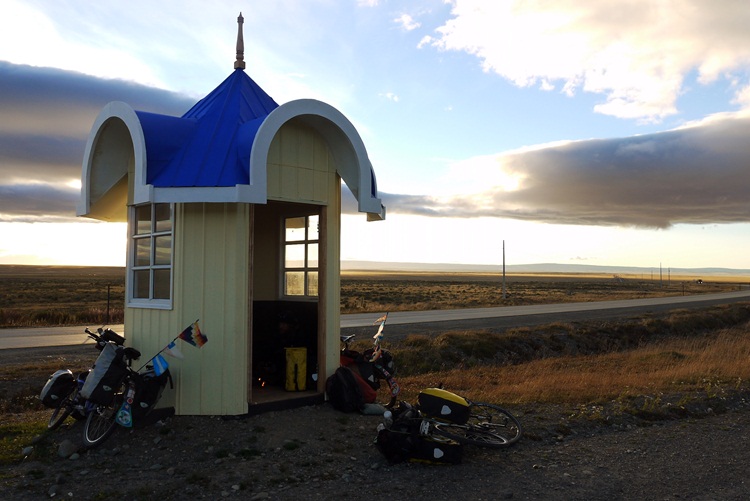
…or when sleeping in a bus shelter feels like a luxurious treat. This architectural gem is our home for the night.
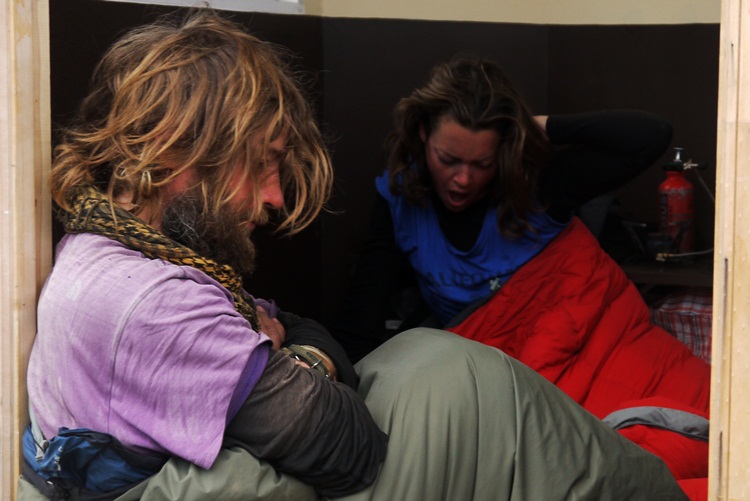
The three of us squeeze in, make hot chocolate and even watch a film on the laptop. The next morning we drag ourselves away from our cozy spot…
P-p-p-p-p-p-pick up a penguin
April 7th, 2014
“Whatever a penguin does has individuality, and he lays bare his whole life for all to see…sometimes solemn, sometimes humorous, enterprising, chivalrous, cheeky – and always a welcome and, in some ways, an almost human friend.”
The Worst Journey in the World
Apsley Cherry-Garrard
For me, a visit to Tierra del Fuego – the island nestled at the foot of South America – wouldn’t have been complete without a trip to the recently re-established King Penguin colony between Porvenir and Camerón. As a long-time admirer of this funny little waddle machine, I was looking forward to the visit with great expectations. (And it would take all of my self-control not to sneak one of them into my panniers before leaving).
Second only in size to the Emperor Penguin, the King is usually found in the much more southerly regions of South Georgia and Antarctica. As these areas are only accessible by long and expensive boat trips, we were keen and privileged to be able to access their colony by bike.
We were also lucky to have the place to ourselves. Camping there with three other cyclists, we had the last of the evening’s sun to nip down and pay them a visit and then the following morning, we returned to watch them stretch, wake and explore – a little more closely than we could ever have anticipated…
Sarah
